
New York State
Testing Program
English Language Arts
and Mathematics Tests
School
Administrator’s
Manual
v202
Updated information
regarding the administration
of these examinations is
posted on NYSED’s Office of
State Assessment website
http://www.p12.nysed.gov/
assessment/ei/2021/3-8-
administration-memo-2021.pdf
Grades 3–8
20212021

ii
Administering
the Tests
THE UNIVERSITY OF THE STATE OF NEW YORK
Regents of The University
LESTER W. YOUNG, JR., Chancellor, B.S., M.S., Ed.D. . ......................................... Beechhurst
T. ANDREW BROWN, Vice Chancellor, B.A., J.D. ................................................ Rochester
ROGER TILLES, B.A., J.D. ........................................................................................ Manhasset
CHRISTINE D. CEA, B.A., M.A., Ph.D. . ................................................................... Staten Island
WADE S. NORWOOD, B.A. .................................................................................... Rochester
KATHLEEN M. CASHIN, B.S., M.S., Ed.D. ............................................................... Brooklyn
JAMES E. COTTRELL, B.S., M.D. ............................................................................. New York
JOSEPHINE VICTORIA FINN, B.A., J.D. ................................................................... Monticello
JUDITH CHIN, M.S. in Ed. ..................................................................................... Little Neck
BEVERLY L. OUDERKIRK, B.S. in Ed., M.S. in Ed. .................................................. Morristown
CATHERINE COLLINS, R.N., N.P., B.S., M.S. in Ed., Ed.D. ...................................... Buffalo
NAN EILEEN MEAD, B.A., M.A. ............................................................................. Manhattan
ELIZABETH S. HAKANSON, A.S., M.S., C.A.S. ....................................................... Syracuse
LUIS O. REYES, B.A., M.A., Ph.D. ........................................................................... New York
SUSAN W. MITTLER, B.S., M.S. .............................................................................. Ithaca
FRANCES G. WILLS, B.A., M.A., M.Ed., C.A.S., Ph.D ............................................. Ossining
Commissioner of Education and President of the University
BETTY A. ROSA, B.A., M.S. IN ED., M.S. IN ED., M.ED., ED.D.
Senior Deputy Commissioner, Office of Education Policy
JOHN D’AGATI
Deputy Commissioner, Office of Instructional Services
KIMBERLY WILKINS
Assistant Commissioner, Office of State Assessment
STEVEN E. KATZ
Director, Office of State Assessment
ZACHARY WARNER
The State Education Department does not discriminate on the basis of age, color, religion, creed, disability, marital status, veteran status, national
origin, race, gender, genetic predisposition or carrier status, or sexual orientation in its educational programs, services and activities. Portions of this
publication can be made available in a variety of formats, including braille, large print or audio tape, upon request. Inquiries concerning this policy of
nondiscrimination should be directed to the Department’s Office for Diversity and Access, Room 530, Education Building, Albany, NY 12234.
Developed and published under contract with the New York State Education Department by Questar Assessment Inc. Copyright © 2021 by the
New York State Education Department. Permission is hereby granted for school administrators and educators to reproduce these materials,
located online at the Office of State Assessment (http://www.p12.nysed.gov/assessment), in the quantities necessary for their school’s use,
provided copyright notices are retained as they appear in these publications.
iii
Grades 3–8 English Language Arts and Mathematics Tests School Administrator’s Manual v202
Administering
the Tests
Table of Contents
Overview.....................................................................................................vi
Contact Information............................................................................................vi
Testing Schedule and Important Administration Dates ........................................ vii
Scratch Paper for Computer-Based Testing ........................................................ viii
How to Use this School Administrator’s Manual ......................................1
Part 1:
Preparing for the Tests ................................................................................3
General Features of the Grades 3–8 English Language Arts
and Mathematics Tests................................................................................... 4
Test Security Requirements and Responsibilities ................................................... 6
Students to Be Tested.......................................................................................... 9
Computer-Based Tests ....................................................................................... 11
Administrator’s Planning Steps for TestPreparation ........................................... 13
Part 2:
Administering the Tests.............................................................................23
School Administrator Responsibilities................................................................. 24
Prepare the Grades 3–8 Paper-Based English Language Arts
Prepare the Grades 3–8 Computer-Based
Prepare the Grades 3–8 Paper-Based Mathematics
Prepare the Grades 3–8 Computer-Based
Secure Test Materials and Answer Sheets .................................................... 25
English Language Arts Secure Test Materials................................................. 26
Secure Test Materials and Answer Sheets ..................................................... 27
Mathematics Secure Test Materials............................................................... 29
Supervision of Students .................................................................................... 30
Aid to Students ................................................................................................ 31
Temporary Absence from Testing Room ............................................................ 31
Emergency Evacuation of a School Building ...................................................... 31
Student Cheating ............................................................................................. 32
Illness ............................................................................................................... 32
Proctoring ........................................................................................................ 32
Untimed Testing ................................................................................................ 33
Make-up Testing .............................................................................................. 34
Concluding Test Sessions .................................................................................. 35
Part 3:
After Testing...............................................................................................39
Scoring of Secure Materials ............................................................................... 40
After Paper-Based Testing Scoring is Complete .................................................. 48
Destruction of Secure Test Materials ................................................................. 50
Reporting Irregularities and/or Misadministrations ............................................ 51
Post-Administration Guidelines.......................................................................... 54
iv
Grades 3–8 English Language Arts and Mathematics Tests School Administrator’s Manual v202
Appendices
Appendix A1: School Administrator’s Checklist for Paper-Based Testing ............................A-1
Appendix A2: School Administrator’s Checklist for Computer-Based Testing......................A-3
Appendix B: Test Storage Certificate .............................................................................A-4
Appendix C: Secure Materials Tracking Log ....................................................................A-5
Appendix D: Deputy and Proctor Certificate....................................................................A-6
Appendix E: Mathematics Tools .....................................................................................A-7
Appendix F: Testing Accommodations for English Language Learners (ELLs) ...................A-9
Appendix G: Testing Accommodations for Students with Disabilities ............................A-11
Appendix H: Specific Testing Accommodations ............................................................A-13
Appendix I: Information on Ungraded Students ..........................................................A-18
Appendix J: Paper-Based Testing School/Group List ......................................................A-19
Appendix K: Box Labels for Submission of Paper-Based Testing Booklets
to Scoring Center ................................................................................A-20
Appendix L1: Paper-Based Testing Scoring Site Organization ..........................................A-21
Appendix L2: Computer-Based Testing Scoring Site Organization ...................................A-22
Appendix M: Exam Scoring Confidentiality Agreement ..................................................A-23
Appendix N: Guidelines for Including Special Education Teachers
in Scoring Committees .........................................................................A-24
Appendix O: Scoring Operations Certificate ..................................................................A-26
Appendix P: Rules to Determine Whether a Student Receives a Valid Score ..................A-27
Appendix Q: Regional Information Centers and Large-CityScanning Centers ................A-28
Appendix R: New York City Department of Education
2020–21 Borough Assessment Implementation Directors......................A-31
Appendix S: Pausing and Reactivating a Computer-Based Test in Nextera
™
Test Delivery System..............................................................................A-33
Appendix T: Nextera
™
Test Delivery System Computer-Based
Testing Accommodations ......................................................................A-34
Appendix U: Roles, Responsibilities, and Permissions in Nextera
™
Administration
System for Computer-Based Testing ......................................................A-38
Appendix V: District and School Test Coordinator Checklist
for Computer-Based Testing..................................................................A-41
Appendix W: Suggestions for Creating a Secure
Computer-Based Testing Environment...................................................A-42
v
Grades 3–8 English Language Arts and Mathematics Tests School Administrator’s Manual v202
Appendix X: Glossary of Computer-Based TestingTerminology......................................A-43
Appendix Y: Nextera
™
Administration System...............................................................A-44
Overview..................................................................................................A-44
Sign In/Sign Out .......................................................................................A-45
Home Tab.................................................................................................A-47
School Test Coordinator ...........................................................................A-51
Teacher ....................................................................................................A-52
Students Tab ............................................................................................A-53
To View Students......................................................................................A-53
To Add or Edit a Student (School and District Test Coordinators only)........A-55
To Set a Student’s Alternate Language for the Computer-Based
Mathematics Test ...................................................................................A-62
Multi-Student Edit ....................................................................................A-63
Classes Tab...............................................................................................A-66
To View and Edit a Class...........................................................................A-66
To Add a Class..........................................................................................A-69
Tests Tab...................................................................................................A-70
To View Tests, Session Access Codes, and to Designate Students
Not Testing.............................................................................................A-71
Examiner View .........................................................................................A-74
To Print Student Login Tickets (Labels) ......................................................A-75
Troubleshooting Tip for Printing Student Login Tickets..............................A-78
Testing Status Details................................................................................A-79
Setting Student Not Testing Codes ...........................................................A-80
Accounts Tab............................................................................................A-82
To Edit an Account ...................................................................................A-82
To Add an Account...................................................................................A-84
Student Responses Tab .............................................................................A-87
Help Tab...................................................................................................A-88
Secure Browser Practice Test Logins ..........................................................A-93
Forgot Your Password?.............................................................................A-96
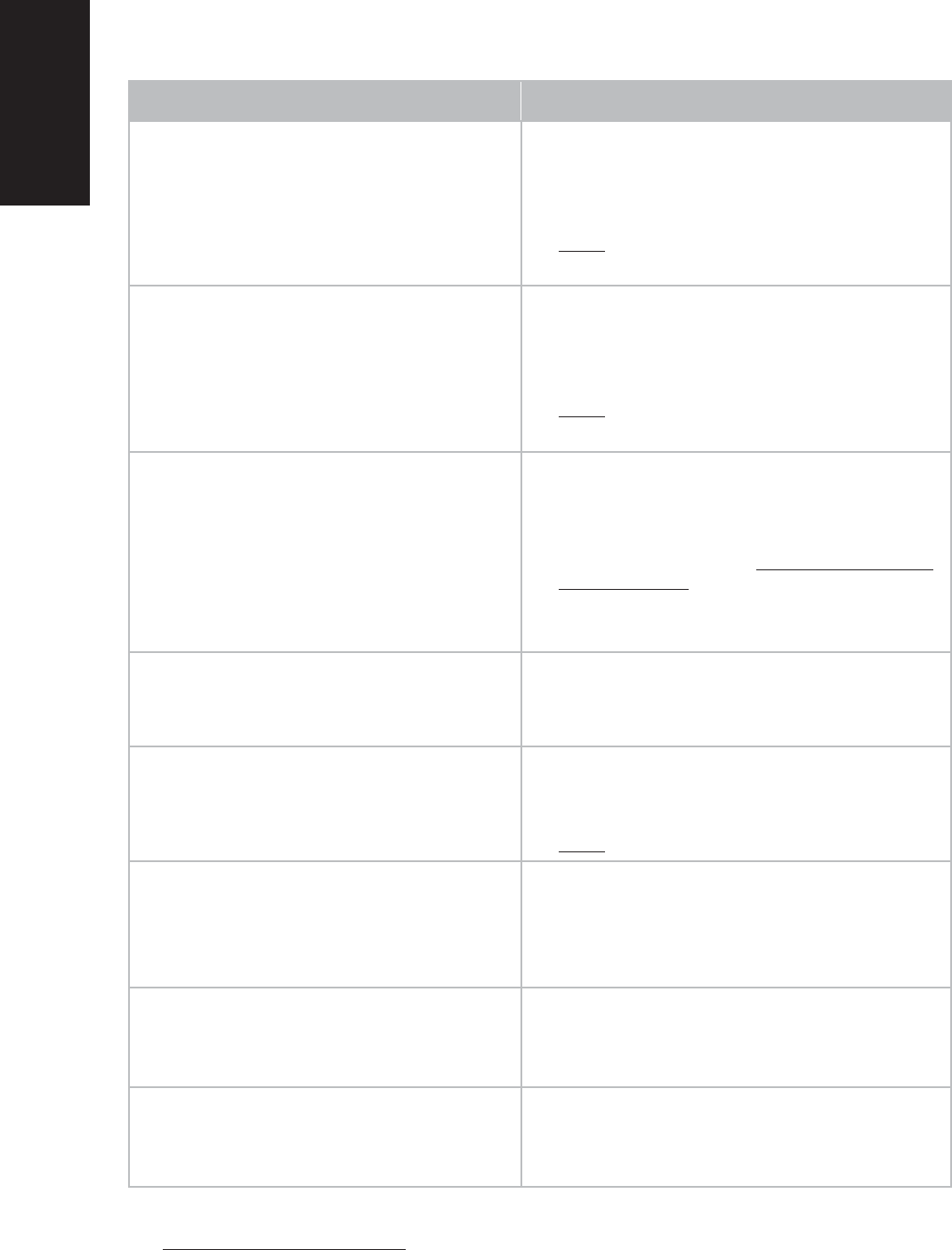
vi
Overview
Grades 3–8 English Language Arts and Mathematics Tests School Administrator’s Manual v202
Contact Information
For assistance with: Contact:
•
Requesting additional secure test materials
such as test booklets (including large type,
braille, and alternative language editions)
that were not originally requested
Questar Assessment Inc. (Questar)
CustomerSupport
Telephone: 866-997-0695
Fax: 866-688-0419
E-mail (ny[email protected])
See page 19.
•
Errors in the school’s shipment of secure test
materials, such as test booklets (including
large type, braille, and alternative language
editions)
Questar Assessment Inc. (Questar)
Customer Support
Telephone: 866-997-0695
Fax: 866-688-0419
E-mail (ny[email protected])
See page 19.
•
Answer sheets, precoded student identification
labels, generic answer sheets, and generic
student identification labels
•
Completing or changing demographic
studentdata
•
Sending completed answer sheets to scanning
centers after scoring of test booklets
The local scanning center (see Appendix Q:
Regional Information Centers and Large-City
Scanning Centers) and on computer-based testing
(CBT) and scoring (http://cbtsupport.nysed.gov).
•
Testing policies regarding accommodations
and security of test materials
The Office of State Assessment
Telephone: 518-474-5902
•
Technical Support for computer-based testing
Questar Assessment Inc. (Questar)
Customer Support
Telephone: 866-997-0695
E-mail (ny[email protected])
•
Sending completed paper-based English
Language Arts Test Session 2 booklets and
Mathematics Test Session 2 booklets and
English Language Arts and Mathematics Test
Answer Sheets to scoring site
The scoring site coordinator
•
Questions about scoring
Questar’s Scoring Helpline
Telephone: 888-382-4246
Monday–Friday, 7:30 a.m. to 4:30 p.m. (ET)
•
Academic Intervention Services
Student Support Services
Telephone: 518-486-6090
Important reminder: Check the Office of State Assessment’s website regularly for updates on
the Grades 3–8 Testing Program (http://www.p12.nysed.gov/assessment).
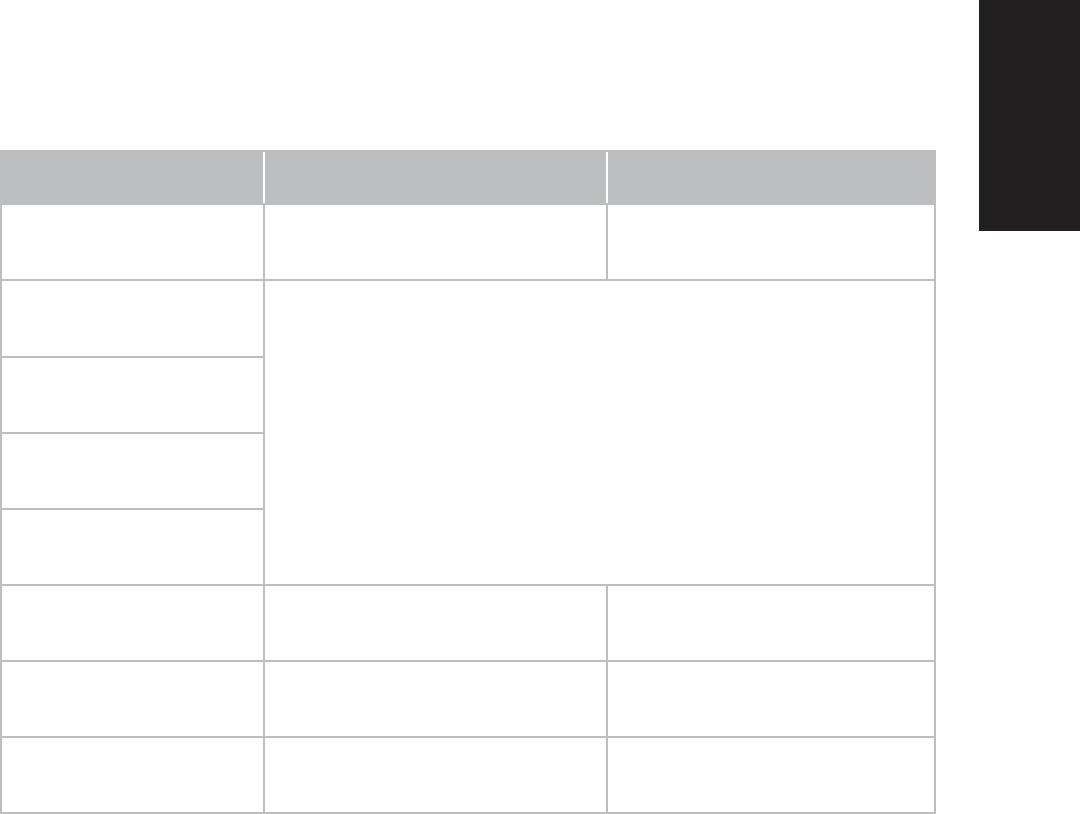
vii
Overview
Grades 3–8 English Language Arts and Mathematics Tests School Administrator’s Manual v202
Testing Schedule and Important Administration Dates
Events
Grades 3–8
English Language Arts
Grades 3–8
Mathematics
Secure Test Materials Arrive
atSchools
Monday, April 12–
Wednesday, April 14
Monday, April 26–
Wednesday, April 28
Computer-Based Test
Administration Window
Please refer to the test schedule at
http://www.p12.nysed.gov/assessment/schedules/schedule-ei.html
Computer-Based Test
Make-Up Window
Paper-Based Test
Administration Window
Paper-Based Test
Make-Up Window
Scoring CDs Arrive
at Schools
Tuesday, April 20 Tuesday, May 4
Scoring Window* Friday, April 23–Wednesday, May 5 Friday, May 7–Thursday, May 20
Final Date to Submit Answer
Sheets to Scanning Center
Wednesday, May 5 Thursday, May 20
* A teacher may not begin to train for scoring or rate student responses until the primary administration of the specific
grade-level test that the teacher will be rating has been administered in that teacher’s school.
Schools are not expected to bring students into the building to participate in the tests if they are receiving
entirely remote instruction during the test administration and make-up periods. The Department has
determined that it will not be possible to administer the tests remotely.
Being mindful of the variability in the manner that instruction is being provided to students across the
State in response to COVID-19, NYSED is providing schools much more flexibility than had been necessary
in past years in the local scheduling of the Spring 2021 operational tests. The testing schedule is posted
on the Department’s website, 2020–21 Elementary- and Intermediate-Level Testing Schedule (http://
www.p12.nysed.gov/assessment/schedules/2021/ei-test-schedule21rev.pdf).
For Spring 2021 only, this flexibility includes:
●
Schools are not expected to administer operational tests to those students who are receiving
entirely remote instruction throughout the test administration period. In other words, schools are
not expected to bring students into school for the tests if they are receiving entirely remote
instruction throughout the test administration period.
●
Schools will have the option to administer the two-session tests to students over the course of both
the primary administration dates and make-up dates to accommodate the school’s instructional
schedule.

viii
Overview
Grades 3–8 English Language Arts and Mathematics Tests School Administrator’s Manual v202
●
Schools will be allowed to administer the tests to students who are receiving hybrid instruction on
the days that they are ordinarily attending school in person. Schools will not be required to choose
two consecutive school days for the primary test administration for each grade of the test and will
not be required to test the entire grade on the same two school days.
●
Public school districts are not required to have a uniform testing schedule for all of the schools in
the district.
●
Make-up testing at each school may begin on the school day immediately following the first day of
the primary test administration.
●
The operational test will not include any embedded field test questions. As a result, there will only
be one form consisting of two sessions administered per grade and subject and all questions on the
test will contribute to student scores.
In addition, schools this year within a Local Education Agency (LEA—district, charter, religious, or
independent school) will not have to adhere to the same locally selected primary testing days. Make-ups
for PBT and CBT for a given grade may begin on the school day immediately following the first day of the
primary test administration.
The primary administration dates for the CBT English Language Arts and Mathematics tests start a
day earlier than the PBT. If a CBT school chooses to start testing on the first day of the CBT
administration window, they may open the corresponding PBT materials on the same day if needed
to allow students who, pursuant to an Individualized Education Program (IEP) or Section 504
Accommodation Plan (504 Plan), will be testing on paper, to provide the test read accommodation
to students testing on computer with a human reader, or for the Mathematics Tests, to provide a
testing accommodation to English Language Learners (ELLs).
Scratch Paper for Computer-Based Testing
Schools that will be administering the English Language Arts and Mathematics Tests on the
computer should prepare to furnish scratch paper to their students for use when taking the tests.
At the start of each test session the proctor should hand out scratch paper to each student testing
with CBT. For the Grades 3–8 English Language Arts Tests, each student should be given one sheet
of lined paper, such as loose leaf paper. For the Grades 3–8 Mathematics Tests, each student
should be given two sheets of scratch paper: one sheet of lined or plain paper and one sheet of
graph paper. In addition, for all test sessions the proctor should have a further supply of scratch
paper on hand to provide to students who request additional sheets during the test session.
Students testing with CBT should also be advised that any work done on this scratch paper will
not be counted. The scratch paper distributed to students testing with CBT must be collected at
the end of the session, whether used or unused, and securely destroyed by the school.

1
Overview
Grades 3–8 English Language Arts and Mathematics Tests School Administrator’s Manual v202
How to Use this School Administrator’s
Manual
The instructions in this manual explain the responsibilities of school administrators for the New York State
Testing Program (NYSTP) Grades 3–8 English Language Arts and Mathematics Tests. School administrators
must be thoroughly familiar with the contents of the manual, and the policies and procedures must be
followed as written so that testing conditions are uniform statewide.
The appendices include:
●
Certificates
●
A tracking log of secure materials
●
Procedures for testing students with disabilities
●
Testing accommodation information
●
Documents to assist with material return
●
Contact information
●
Information on the Nextera
™
Administration System for computer-based testing
This School Administrator’s Manual serves to guide school administrators in general test administration
activities for both paper- and computer-based testing.
All persons in charge of the administration of the Grades 3–8 English Language Arts and Mathematics
Tests should be familiar with the information in this manual.
Instructions for test administration in the testing room are provided in the English Language Arts Tests
Teacher’s Directions and the Mathematics Tests Teacher’s Directions (http://www.p12.nysed.gov/
assessment/manuals).
Questions concerning the administration of these tests should be directed to the Office of State
Assessment (OSA) at 518-474-5902.

Preparing for
the Tests
Part 1
Preparing for
the Tests
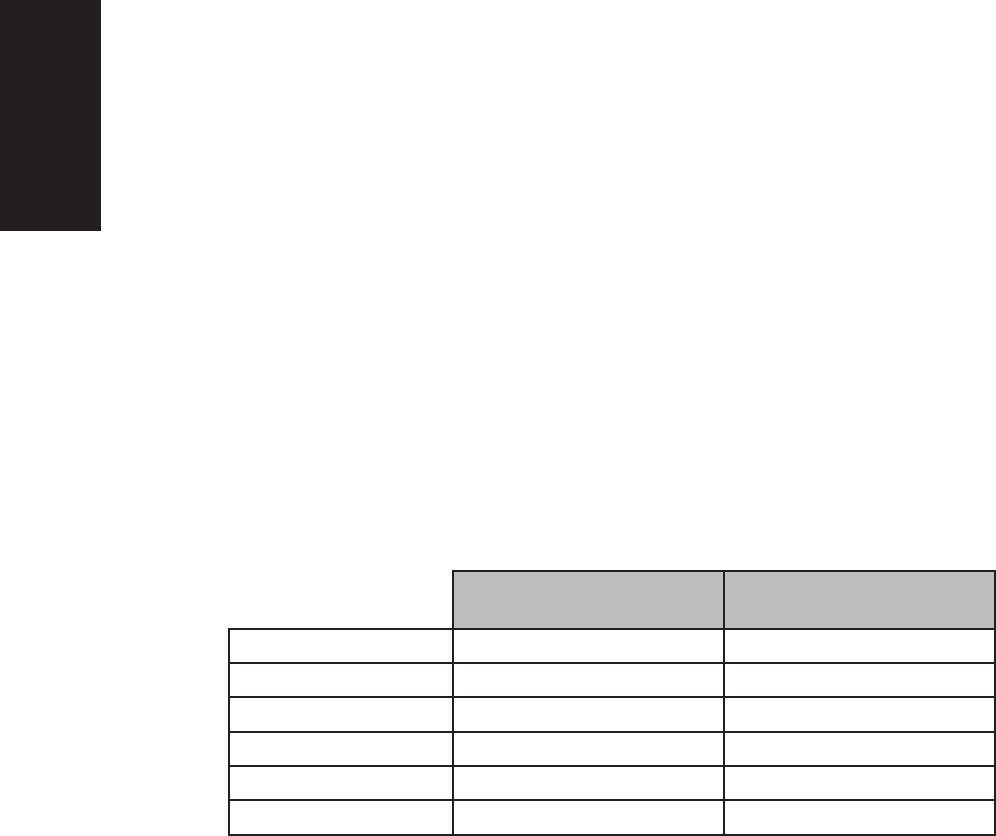
Grades 3–8 English Language Arts and Mathematics Tests School Administrator’s Manual v202
Preparing for
the Tests
General Features of the Grades 3–8 English
Language Arts and Mathematics Tests
The New York State Education Department (NYSED), along with its contractor, Questar Assessment Inc.
(Questar), constructed the Grades 3–8 English Language Arts and Mathematics Tests. Teachers from
across the State work with the Department in a variety of activities, such as writing, reviewing, and
selecting the test questions that will be included on the operational tests, to ensure that the tests are
appropriate measures of student achievement of the New York State Learning Standards.
The Grades 3–8 English Language Arts Tests will consist of two sessions. Except for make-up testing, the
tests must be administered in session order.
The Grades 3–8 English Language Arts Tests will be untimed. Students should be given as much time as
they need to complete them within the confines of the regular school day. On average, students in
Grades 3–4 will likely need approximately 60–70 minutes of working time to complete Session 1 and
70–80 minutes of working time to complete Session 2. Students in Grades 5–8 will likely need
approximately 80–90 minutes of working time to complete Session 1 and 90–100 minutes of working
time to complete Session 2.
The Grades 3–8 Mathematics Tests will consist of two sessions. Except for make-up testing, the tests
must be administered in session order.
The Grades 3–8 Mathematics Tests will be untimed. Students should be given as much time as they need
to complete them within the confines of the regular school day. Below is a table of the average time it
will take students to complete each session by grade.
Average Time to Complete
Session 1
Average Time to Complete
Session 2
Grade 3 55–65 Minutes 60–70 Minutes
Grade 4 65–75 Minutes 65–75 Minutes
Grade 5 80–90 Minutes 70–80 Minutes
Grade 6 80–90 Minutes 75–85 Minutes
Grade 7 80–90 Minutes 75–85 Minutes
Grade 8 80–90 Minutes 75–85 Minutes
Some students will need more time to complete the English Language Arts and Mathematics Tests, and
provisions should be made to accommodate these students. In addition, the test administrator will need
approximately 15 minutes to distribute materials and give directions to students.
The start time of each session may be staggered by grade to accommodate staffing and space needs
(e.g., Grade 3 starts at 9:00 a.m. while Grade 4 starts at 11:00 a.m.).
The principal must arrange for the collection and secure storage of all used and unused test booklets as
soon as each session is completed.
4

Grades 3–8 English Language Arts and Mathematics Tests School Administrator’s Manual v202
Preparing for
the Tests
Given that the spring tests have no time limits, schools and districts have the discretion to
create their own approach to ensure that all students who are productively working are given
the time they need within the confines of the regular school day to continue to take the tests.
School administrators may prefer to allow students to hand in their test materials as they finish and then
leave the room. If so, take care that students leave the room as quietly as possible so as not to disturb the
students who are still working on the test. Additional guidance concerning untimed testing is provided in
the section “Untimed Testing” in the “Administering the Tests” part of this manual.
Preparing for
the Tests
5

Grades 3–8 English Language Arts and Mathematics Tests School Administrator’s Manual v202
Preparing for
the Tests
Test Security Requirements and Responsibilities
The purpose of the NYSTP test security requirements is to protect the validity of the test results. This section
of the School Administrator’s Manual specifies security responsibilities and planning procedures that must
be followed, specifically:
●
The security and accounting measures of secure testing materials;
●
Specifications of who is responsible for maintaining test security;
●
The chain of responsibility in test security; and
●
Types of testing irregularities and how to report them.
Principals are responsible for ensuring that all proctors and school personnel authorized to have access to
secure test materials comply with the requirements and instructions contained in this part of the manual.
To minimize the number of testing irregularities, principals should conduct a review of the test
administration procedures—prior to each test administration—with all faculty and staff who will be
involved in the test administration and scoring. In addition, to preserve the integrity of the test materials,
advise all teachers administering and scoring the tests that they are not to discuss test questions or other
specific test content online via e-mail or LISTSERV or through any other electronic means. Teachers and
test administrators may not use cell phones or other photographic devices to duplicate test
materials and should keep their own personal communication devices put away during testing,
using them only in emergency situations. Please note that shrink-wrapped packages of test booklets
cannot be opened prior to the distribution of tests to students.
Test security responsibilities of the principal or designee:
❏
Authorize specific personnel to serve as proctors, and train them to properly administer the tests.
❏
Designate other school personnel permitted to access secure test materials, and train them in test
security requirements.
❏
Advise all staff that they are not to discuss test questions or other specific test content with each
other, with others online via e-mail or LISTSERV, or through any other electronic means.
❏
Prior to delivery date of secure test materials, make arrangements to:
•
Be notified when the secure test materials arrive,
•
Inventory the secure test materials (see “Inventory Secure Test Materials” on page 18), and
•
Store the secure test materials in a secure location (see “Store Secure Test Materials” on page20).
❏
Develop additional local policies and procedures necessary to ensure maximum test security at
alltimes.
❏
Deliver a copy of the Teacher’s Directions (which is not secure) to each teacher who will be
administering the test.
6

Grades 3–8 English Language Arts and Mathematics Tests School Administrator’s Manual v202
Preparing for
the Tests
❏
Conduct a review of the test administration procedures prior to each test administration with all
personnel who will be involved in the test administration and scoring.
❏
Review, comply, and sign the Test Storage Certificate located in Appendix B and retain in
school files for one year. This document acknowledges that required security procedures
wereobserved.
❏
Review, circulate, and collect signatures for the Deputy and Proctor Certificate located in
AppendixD and retain in school files for one year. This document acknowledges that required
administration procedures werefollowed.
❏
For computer-based testing (CBT) administration, maintain security of all secure materials associated
with CBT, including printed student login tickets, session access codes, and Proctor PINs.
❏
For CBT administration, after the conclusion of the test, securely destroy all used scratch paper,
printed student login tickets, session access codes, and Proctor PINs.
Test security responsibilities of proctors:
❏
Receive training in administering test sessions properly and securely.
❏
Review the Teacher’s Directions and:
•
Understand the security requirements before administering test sessions.
•
Read the scripts and directions prior to the test administration.
❏
Administer the tests during the assigned testing window, on the assigned days, and in the
assignedorder.
❏
Make arrangements in advance to seat students and prepare a secure testing environment.
❏
See “Prepare the Testing Room(s)” on page 20 for paper-based testing (PBT) and see page A-42
of Appendix W: Suggestions for Creating a Secure Computer-Based Testing Environment
for CBT.
❏
For CBT administration, obtain the Proctor PINs and session access codes from your administrator
for each test session (for Proctor PINs, see directions beginning on page A-47 of Appendix Y:
Nextera
™
Administration System; for session access codes, see directions on page A-71 of
Appendix Y for further details).
❏
Provide students with all required test materials, including student login tickets and session
access codes, for CBT administration.
❏
Prevent the use of unapproved materials (see pages 30–31 for lists of approved and unapproved
materials). Note that results will be invalidated for students who use or possess cell phones
duringtesting.
❏
Review, comply, and sign the Deputy and Proctor Certificate located in AppendixD.
❏
Follow proper procedures for students with disabilities; see Testing Accommodations for
Students with Disabilities located in Appendix G.
7

Grades 3–8 English Language Arts and Mathematics Tests School Administrator’s Manual v202
Preparing for
the Tests
Shared test security responsibilities of principals, proctors,
and all other school personnel authorized to have access to
secure material:
❏
Receive training in test security requirements and test administration protocols.
❏
Document the location of secure printed materials at all times using the Secure Materials
Tracking Log, located in Appendix C.
❏
Ensure the security of the testing environment (see “Prepare the Testing Room(s)” on page 20).
❏
Ensure the security of test questions, test booklets, and other secure materials.
Do not:
•
Leave secure materials unattended when tests are not being administered.
•
Read, reveal, review, or duplicate the contents of secure test material before, during, or after a
test administration.
•
Duplicate any portion of the test, including but not limited to audiotaping, videotaping,
photographing, photocopying, and copying by hand.
•
Remove secure printed test materials from the school without authorization.
•
Read, review, or change student responses.
Testing Irregularities
Testing irregularities are incidents that represent a deviation from the assigned testing procedures. Testing
irregularities may include confirmed cases of student cheating, student possession or use of a cell phone
or other communication device, or the mishandling of secure test materials. Such incidents must be
promptly reported, in writing, to the Office of State Assessment (OSA) by fax at 518-474-1989 or by
e-mail ([email protected]).
No one, under any circumstances, including the student, may alter the student’s responses on
the test once the student has handed in their test materials. Teachers and administrators
who engage in inappropriate conduct with respect to administering and scoring State
assessments may be subject to disciplinary actions in accordance with Sections 3020 and
3020-a of Education Law, or to action against their certification pursuant to Part83 of the
Regulations of the Commissioner of Education.
8

Grades 3–8 English Language Arts and Mathematics Tests School Administrator’s Manual v202
Preparing for
the Tests
Students to Be Tested
Except as noted below, all public and charter school students enrolled in Grades 3–8 must take all State
tests administered for their grade level. This includes students who have been retained in these grades.
The birth dates of ungraded students with disabilities should be used to determine who must be tested
and which grade-level test they will take (see Appendix I: Information on Ungraded Students). When
determining which students will participate in these tests, be sure to consider students who attend
programs operated by the Boards of Cooperative Educational Services (BOCES), as well as any other
programs located outside the district.
All students are expected to participate in State tests as part of the core academic program. Students can
only be tested once during each test administration period. Absences from all or part of the required
academic program should be managed in accordance with the attendance policies of the district. For
accountability and other statewide reporting purposes, students who do not participate in an assessment
are reported to the State as “not tested.” Schools do not have any obligation to provide an alternative
location or activities for individual students while the tests are being administered.
Religious and independent schools are also encouraged to participate in these tests and are to follow the
same guidelines for each grade-level test they are administering.
Students Receiving Entirely Remote Instruction
Schools are not expected to bring students into the building to participate in the tests if they are receiving
entirely remote instruction during the test administration and make-up periods. The Department has
determined that it will not be possible to administer the tests remotely.
Accelerated Mathematics Students Taking Regents Examinations
Grades 7 and 8 students who are receiving instruction in a commencement-level mathematics course and
who will be taking a Regents Examination in mathematics in June 2021 may be exempted by the school
from the respective Grade 7 or 8 Mathematics Test.
English Language Learners (ELLs)
●
Schools are permitted to exempt from the English Language Arts Tests only those English Language
Learners (ELLs) (including those from Puerto Rico) who, on April 1, 2021, will have been attending
school in the United States for the first time for less than one year.
●
Recently arrived ELLs may be eligible for one, and only one, exemption from the administration of
the New York State Grades 3–8 English Language Arts Tests.
●
Subject to this limitation, schools may administer the New York State English as a Second Language
Achievement Test (NYSESLAT) in lieu of the Grades 3–8 English Language Arts Tests, for
participation purposes only, to recently arrived ELLs who meet the criteria above.
All other ELLs must participate in the Grades 3–8 English Language Arts Tests, as well as in the NYSESLAT.
9

Grades 3–8 English Language Arts and Mathematics Tests School Administrator’s Manual v202
Preparing for
the Tests
The provisions of the Elementary and Secondary Education Act (ESEA) do not permit any exemption of
ELLs from the Grades 3–8 Mathematics Tests. In CBT and PBT formats, these tests are available in Chinese
(Traditional), Haitian Creole, Korean, Russian, and Spanish. Also, three new additional translations of the
Grades 3–8 Mathematics tests are available (in PBT format only): Arabic, Bengali, and Chinese (Simplified).
These three new PBT translated editions will need to be obtained exclusively from the Department, and
not Questar. The tests can be translated orally into other languages for those ELLs whose first language is
one for which a written translation is not available from theDepartment.
See Appendix F: Testing Accommodations for English Language Learners for specific testing
accommodations.
Students with Disabilities
●
The Committee on Special Education (CSE) must decide for each student, on a case-by-case basis,
whether the student will participate in a particular general State test or in the New York State
Alternate Assessment (NYSAA) for students with severe cognitive disabilities.
●
The CSE’s decision must be documented in the student’s Individualized Education Program (IEP).
The criteria that the CSE must use to determine eligibility for the NYSAA is available on the NYSAA
website (http://www.p12.nysed.gov/assessment/nysaa).
See Appendix G and Appendix H for testingaccommodations for students with disabilities.
Specific accommodations allowed for students can be found in Appendix H: Specific Testing
Accommodations.
Medically Excused
●
Students who are incapacitated by illness or injury during the test administration and make-up
periods and have on-file documentation from a medical practitioner that they were too
incapacitated to complete the test at the school, at home, or in a medical setting are considered
Medically Excused, are considered to have no valid test score, and must be reported with a final
score of 999 and a standard achieved code of 93.
●
These students are excluded from the numerator and the denominator of the participation and
performance accountability calculations.
Students Receiving Entirely Remote Instruction
Students who are unable to participate in the test due to receiving entirely remote instruction during the
test administration and make-up periods during the pandemic are considered Receiving Entirely Remote
Instruction. These students are considered to have no valid test score and must be reported with an
Overall Scale Score of “999” and a standard achieved code of 92.
10
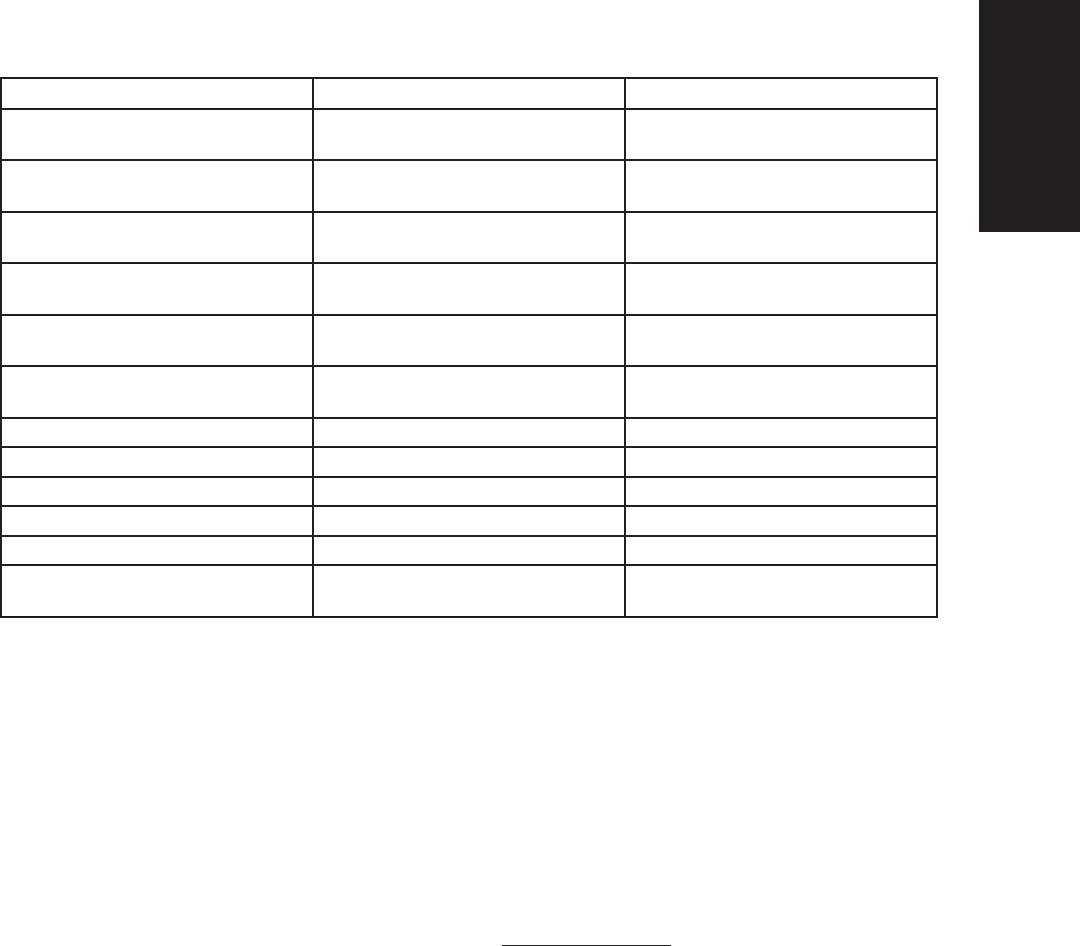
Grades 3–8 English Language Arts and Mathematics Tests School Administrator’s Manual v202
Preparing for
the Tests
Computer-Based Tests
General Tools for CBT
For students who will be taking the tests on the computer, General Tools are available to all students in
the Nextera
™
Test Delivery System for the appropriate grade(s) and content area(s). Please refer to the
table below for information regarding which tools are available by grade and content area.
General Tool Content Area(s) Grades
Highlighter English Language Arts and
Mathematics
3–8
Bookmark English Language Arts and
Mathematics
3–8
Zoom English Language Arts and
Mathematics
3–8
Answer Eliminator English Language Arts and
Mathematics
3–8
Notepad English Language Arts and
Mathematics
3–8
Line Reader English Language Arts and
Mathematics
3–8
Drawing Tool Mathematics 3–8–Session 2 only
Ruler Mathematics 3–8
Equation Editor Mathematics 3–8–Session 2 only
Protractor Mathematics 4, 5, 6, 7, and 8
Mathematics Reference Sheet Mathematics 5, 6, 7, and 8
Calculator Mathematics 6–Session 2 only
7 and 8–Sessions 1 and 2
Nextera
™
Test Delivery System Practice Tests
Practice tests will be available in the Nextera
™
Test Delivery System secure browser. Taking the practice test in the
secure browser provides students with the opportunity to become familiar with the mechanics of taking the test
on the computer, with the available tools, as well as with the general types of questions on the tests. All
students taking one or more of the operational tests on the computer should be provided with at least one
opportunity to take the practice test(s) available in the Nextera
™
Test Delivery System.
Detailed directions on accessing the secure browser practice tests can be found on page A-93 in
Appendix Y: Nextera
™
Administration System.
Students can also practice using the web-based Question Sampler which can be found at:
https://ny.nextera.questarai.com/tds/#practice. Note that it is recommended that students access both
the practice tests and the question sampler in the Chrome browser on computer devices.
Computer-Based Testing Accommodations
Some students with disabilities whose schools have chosen CBT for their grade level may benefit from
using online testing accommodations that change the way the test is displayed to enhance its accessibility
for those students. Students with learning needs as documented in an IEP or 504 Plan may require CBT
11

Grades 3–8 English Language Arts and Mathematics Tests School Administrator’s Manual v202
Preparing for
the Tests
accommodations. Please refer to the table below as you consider the online testing accommodations
your students may need.
CBT Accommodation Content Area Notes
Answer Masking Tool English Language Arts and Mathematics
Reverse Contrast English Language Arts and Mathematics
Background Color English Language Arts and Mathematics
Initial Page Zoom English Language Arts and Mathematics
Text-to-Speech (TTS)
English Language Arts directions, passages, questions,
and answer choices
Mathematics directions, questions, and answer choices
Read Aloud (by human)
English Language Arts directions, passages, questions,
and answer choices
Mathematics directions, questions, and answer choices
Refer to Appendix T: Nextera
™
Test Delivery System Computer-Based Testing Accommodations
for descriptions of the CBT Accommodations. CBT Accommodations must be assigned to students prior
to testing by the District Test Coordinator or School Test Coordinator via the Nextera
™
Administration
System. Instructions for assigning CBT Accommodations to students are provided in the section, “To Add
or Edit a Student” beginning on page A-55 of Appendix Y.
12

Grades 3–8 English Language Arts and Mathematics Tests School Administrator’s Manual v202
Preparing for
the Tests
Administrator’s Planning Steps for
TestPreparation
The following sections are provided to assist in descriptions of long-term planning (more than two weeks
prior to test administration) and short-term planning (within two weeks of test administration) activities
that should be conducted by school administrators in preparation for administering the New York State
Grades 3–8 English Language Arts and Mathematics Tests. A complete checklist of school administrator
planning activities is provided in Appendix A1: School Administrator’s Checklist for Paper-Based
Testing and in Appendix A2: School Administrator’s Checklist for Computer-Based Testing. Refer
to Appendix V for the District and School Test Coordinator Checklist for Computer-Based Testing.
Refer to Appendix U for descriptions of Roles, Responsibilities, and Permissions in Nextera
™
Administration System for Computer-Based Testing and Appendix X for a Glossary of Computer-
Based Testing Terminology.
All devices intended for use in the administration of the computer-based tests (CBT) must be set up and
configured to test using the Nextera
™
Test Delivery System. Appendix Y: Nextera
™
Administration
System includes processes and screen shots for common functions necessary to administer the tests on a
computer (adding and editing teachers, students, etc.). The Setup and Installation Guide (https://
cbtsupport.nysed.gov/hc/en-us/articles/208474306) has detailed instructions for preparing devices for
testing. If you have questions, please contact Questar Customer Support at 866-997-0695 or e-mail
(ny[email protected]).
Long-Term Planning
Announce Test Dates
Be sure to:
●
Schedule tests to avoid conflicts with recess or lunch.
●
Announce administration of test dates to students before the date that the tests are scheduled to
be administered. All announcements should be made in such a way as to convey information
without causing students to become overly anxious.
●
Inform parents of the dates and purpose of testing. Parents should be asked to encourage students
to do their best on the tests and to ensure that students are well-rested on the days of testing.
●
Familiarize students with the general types of questions on the tests and the procedures that they
should follow when recording the answers to the test questions. For additional instructions, refer
to the Teacher’s Directions (http://www.p12.nysed.gov/assessment/manuals), which will be
shipped to schools.
●
All students participating in CBT should be provided at least one opportunity to become familiar
with the practice test for the grade and subject(s) for which they will be taking the operational test.
The practice test is available in the secure browser.
●
Ensure that tests are administered within the testing window and in the assigned order.
13

Grades 3–8 English Language Arts and Mathematics Tests School Administrator’s Manual v202
Preparing for
the Tests
Plan Secure Test Materials Storage
The paper-based English language arts and mathematics test booklets must be stored in the safe or vault
of the building where the tests will be shipped. For CBT administration, the student login tickets, session
access codes, and Proctor PINs are considered secure materials. They must also be stored in the safe or
vault if they are printed prior to the test administration. The principal must ensure that access to the safe
or vault is restricted. If the building where the tests will be administered does not have a safe or vault
large enough to hold the secure test materials, arrangements must be made to store them at a location
with an appropriate safe or vault. If you have specific questions concerning the storing of test materials,
please call the OSA at 518-474-8220.
Alternate Storage Location
If you indicated that your secure materials will be stored at an alternate storage location on the School
Information Page when requesting tests via the online examination request system, you will be required
to complete the Examination Storage Plan form, found on the online examination request system, and
fax it to OSA at 518-474-2021.
Gather Mathematics Tools
Schools must furnish protractors and rulers to each student for their exclusive use with the paper-based
mathematics tests. Schools must also furnish hand-held calculators to each student for their exclusive use
for both paper- and computer-based testing. See Appendix E: Mathematics Tools for complete details
on the use of rulers, protractors, andcalculators.
Each student testing in Grades 5–8 will be provided with a mathematics reference sheet for their exclusive
use during the tests. For PBT, this sheet is provided as a removable sheet in the front of the student test
booklet. For CBT, this sheet is provided as a stand-alone document and must be handed out to students
before the test begins. The following table lists required tools that schools must provide for each grade
level for the paper-based Grades 3–8 Mathematics Tests. All tools listed below, as well as the mathematics
reference sheet, will be available to students testing on the computer through the Nextera
™
Test Delivery
System. Teachers must also provide hand-held calculators to students taking the Mathematics CBT, as
indicated in the table below.
Tool Grades Duration Usage Notes
Ruler Grades 3–8 Entire test
Examine all rulers to be sure they are in adequate
condition and that they do not have pertinent
information, such as mathematics formulas, written
on them.
Protractor Grades 4–8 Entire test
Examine all protractors to be sure they are in
adequate condition and that they do not have
pertinent information, such as mathematics
formulas, written on them.
Four-function
calculator with a
square root key
or
scientific calculator
Grade 6 Session 2 only
Grade 6 students must NOT be provided a calculator
for Session 1 because this part of the test measures
proficiency involving calculations.
Note: Grades 3–5 students may NOT use calculators
for any session of the Mathematics Tests.
Scientific calculator Grades 7 & 8 Entire test
See Appendix E for specifications of scientific
calculators.
14

Grades 3–8 English Language Arts and Mathematics Tests School Administrator’s Manual v202
Preparing for
the Tests
Plan the Scoring Operations—Scoring Constructed-Response
Questions
There are many activities that need to occur in order to be prepared for the scoring of the constructed
responses, such as choosing the scoring model that will be followed in your school, and selecting and
assigning the teachers who will do the scoring. The following sections describe many of the long-term
planning activities that will need to take place. For more detail on scoring and the scoring process, please
refer to the Grades 3–8 English Language Arts and Mathematics Tests Scoring Leader Handbook (Scoring
Leader Handbook) (http://www.p12.nysed.gov/assessment/ei/eigen.html).
Scoring Model Options
Public school districts and charter, religious, and independent schools have several scoring model options
as listed below. Arranging for the scoring of short- and extended-response questions in English Language
Arts Test Session 2 and Mathematics Test Session 2 is the responsibility of each school or school district.
The Department will not score these responses.
Scoring Model Code #/Option
The scorers for the school’s tests include
the following:
1. Regional Scoring*
a) scorers from three or more school districts; or
b) scorers from two or more religious or independent schools in
an affiliation group (religious, independent, or charter
schools may participate in regional scoring with public school
districts, and each religious, independent, or charter school
may be counted as one district).
2. Schools from two districts*
a) scorers from two school districts;
b) scorers from two religious or independent schools;
c) scorers from two charter schools; or
d) a combination of scorers from two of the following:
a school district, religious school, independent school, or
charter school.
3. Three or more schools within a district scorers from three or more schools in a district
4. Two schools within a district (PBT only) scorers from two schools in a district
5. One school (PBT only)
three or more scorers for each grade being scored, all from the
same school
6. Private Contractor scored by a private contractor (not a BOCES)
*This model is not permitted for CBT scoring unless it includes scorers from at least three schools.
Regardless of the scoring model being used, a minimum of three scorers is necessary to score
each student’s test. However, to comply with a State requirement, none of the scorers assigned
to score a student’s test responses may be that student’s teacher (refer to “Assign Scorer
Numbers and Questions to Scoring Committee Members” on page 42 for further details). In
order to maximize the number of teachers scoring test booklets from any one teacher’s class or any one
school, it is necessary that test booklets be randomized prior to assignment to scorers. The steps for
randomizing are described on pages 43–44.
15
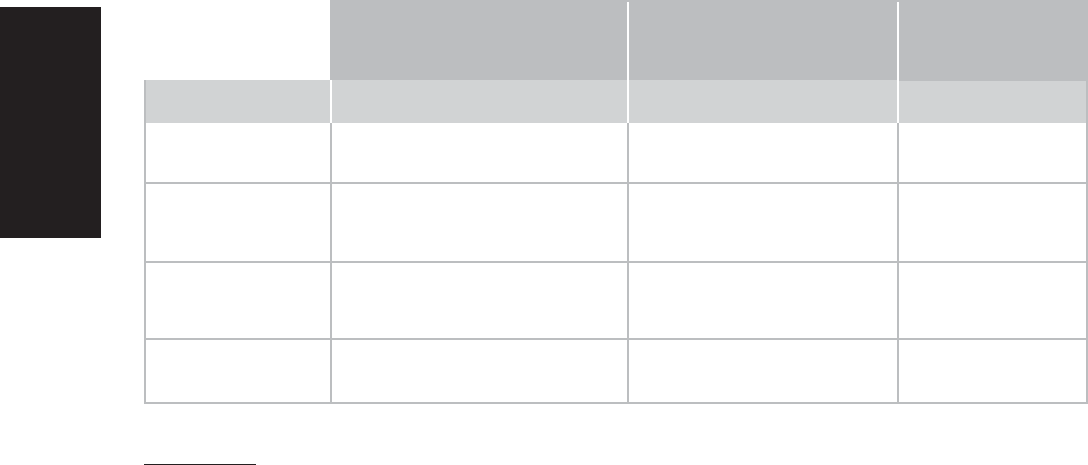
Grades 3–8 English Language Arts and Mathematics Tests School Administrator’s Manual v202
Preparing for
the Tests
Scoring options involve specific responsibilities and title designations. The responsibilities are similar,
although the titles are different depending on the option. For more information on scoring role
responsibilities, see Appendix L1 for Paper-Based Testing Scoring Site Organization and Appendix L2
for Computer-Based Testing Scoring Site Organization.
Regional Scoring (Scoring Model 1)
Private Contractor (Scoring Model 6)
Districtwide Scoring
(Scoring Models 2, 3, and 4)
Schoolwide Scoring
(Scoring Model 5)
Responsibilities Regional Title District Title School Title
Supervises scoring
operation
Site Coordinator School District Administrator Principal
Trains scorers,
monitors sessions
Scoring Leader
District English Language Arts
or Mathematics Leader
School English
Language Arts or
Mathematics Leader
Monitors sessions Table Facilitator
School English Language Arts
or Mathematics Leader
School English
Language Arts or
Mathematics Leader
Scores constructed
responses
Scoring Committee Member Scoring Committee Member
Scoring Committee
Member
For details on scoring model logistics, please see the Scoring Leader Handbook, available on the
OSA website (http://www.p12.nysed.gov/assessment/ei/eigen.html).
Responsibilities of Person Supervising Scoring Operations
The person responsible for supervising scoring operations must sign the Scoring Operations Certificate,
located in Appendix O of this manual. The signed certificate indicates compliance with the procedures
described in this section on scoring the short- and extended-response questions.
Selecting and Assigning Teachers for the Scoring Committees
A scoring committee is made up of teachers chosen to score the short- and extended-response questions
for the Grades 3–8 English Language Arts or Mathematics Tests. Each scoring committee must have a
minimum of three scorers. It is recommended that each scoring site have a minimum of two scoring
committees. School administrators make the final decision as to who can score these tests after a review
of the teacher’s certification and present teaching assignment(s). Criteria to consider when choosing
scoring committee members are listed below.
General Requirements for Scoring Committee Member
●
Experience with scoring constructed-response questions, including use of rubrics;
●
Experience using holistic rubrics;
●
Content area expertise;
●
One or more years of teaching the specified or adjacent grade levels;
●
Experience teaching in the elementary grades (for Grades 3–6 tests) or in the subject area (for
Grades 5–8 tests); and
16

Grades 3–8 English Language Arts and Mathematics Tests School Administrator’s Manual v202
Preparing for
the Tests
●
Familiarity with the Grades 3–8 Rubric and Scoring Training materials.
Retired teachers and active or retired school administrators, as well as certified teachers who are currently
working as teacher assistants, may score the short- and extended-response questions if they:
●
Have taught in the elementary grades (for Grades 3–6 tests) or in the subject area (for Grades 5–8
tests), and
●
Have familiarity with the Grades 3–8 Rubric and Scoring Training materials. If a district, charter
school, religious school, or independent school chooses to contract with a private contractor to
score these tests, it is the responsibility of the district, charter school, religious school, or
independent school to ensure that all individuals who will be scoring for the private contractor
have also met these criteria. District, charter school, religious school, or independent school
administrators considering the use of special education teachers to score these tests should refer to
Guidelines for Including Special Education Teachers in Scoring Committees located in
Appendix N.
Note: At the time scoring training takes place, scoring materials are secure, and may only be shared with
those who will be engaged in actually scoring student responses. Anyone who will not be scoring tests
may not participate in scoring training.
17

Grades 3–8 English Language Arts and Mathematics Tests School Administrator’s Manual v202
Preparing for
the Tests
Short-Term Planning
Receive Test Materials
●
All test shipments will be delivered by UPS, and may be delivered at any time between the hours of
8:00 a.m. and 5:00 p.m. (ET).
●
If you do not receive your shipment by 5:00 p.m. (ET) on the final day of the Secure Test Materials
Arrive at Schools window (see page vii for the Secure Test Materials Arrive at Schools window), please
contact Questar Customer Support at 866-997-0695, or by e-mail ([email protected]).
Inventory Secure Test Materials
English Language Arts and Mathematics test materials will arrive from Questar in separate shipments.
The shrink-wrapped packages of secure test materials must not be opened during the inventory.
All secure test materials must remain sealed until the test administration date. Answer sheets will be sent
from a Regional Information Center (RIC) or Large-City Scanning Center. Schools are responsible for
contracting with a RIC or Large-City Scanning Center for answer sheets and scanning services.
Inventory the following PBT materials received from your local scanning center:
●
Precoded answer sheets: Schools should have one precoded answer sheet for each student
participating in the Grades 3–8 English Language Arts Test, and two precoded answer sheets for
each student participating in the Grades 3–8 MathematicsTest.
●
Blank answer sheets: Schools should have blank answer sheets for new students. Please refer to
the district/regional testing directions for specific instructions on recording demographic
information for new students.
●
Precoded student identification labels: Schools should have precoded student identification labels
for each student participating in this test administration. The labels should be affixed to the English
Language Arts Session 2 test booklet and Mathematics Session 2 test booklet. The affixing of the
labels to the test booklets may occur no earlier than the day each test booklet will be administered.
●
Blank student identification labels: Schools should have blank student identification labels for new
students for whom no precoded label was found. The labels are to be completed and affixed to the
back covers of each new student’s English Language Arts Session 2 test booklet and Mathematics
Session 2 test booklet.
●
Preprinted classroom rosters: (This is only for schools associated with certain RICs or certain Large-
City Scanning Centers.) Schools should have one roster for every class participating in testing. (For
details, please contact your scanning center.) All other schools will need to prepare classroom
rosters of students to be tested, using the format provided in the answer sheet package sent by the
RIC or Large-City Scanning Center.
Inventory the materials received in your shipment from Questar:
●
Shipping Notice: Use the packing list in Box 1 of your shipment of test materials and the school’s
copy of the confirmation notice e-mailed to the school after submitting the school’s online request.
18
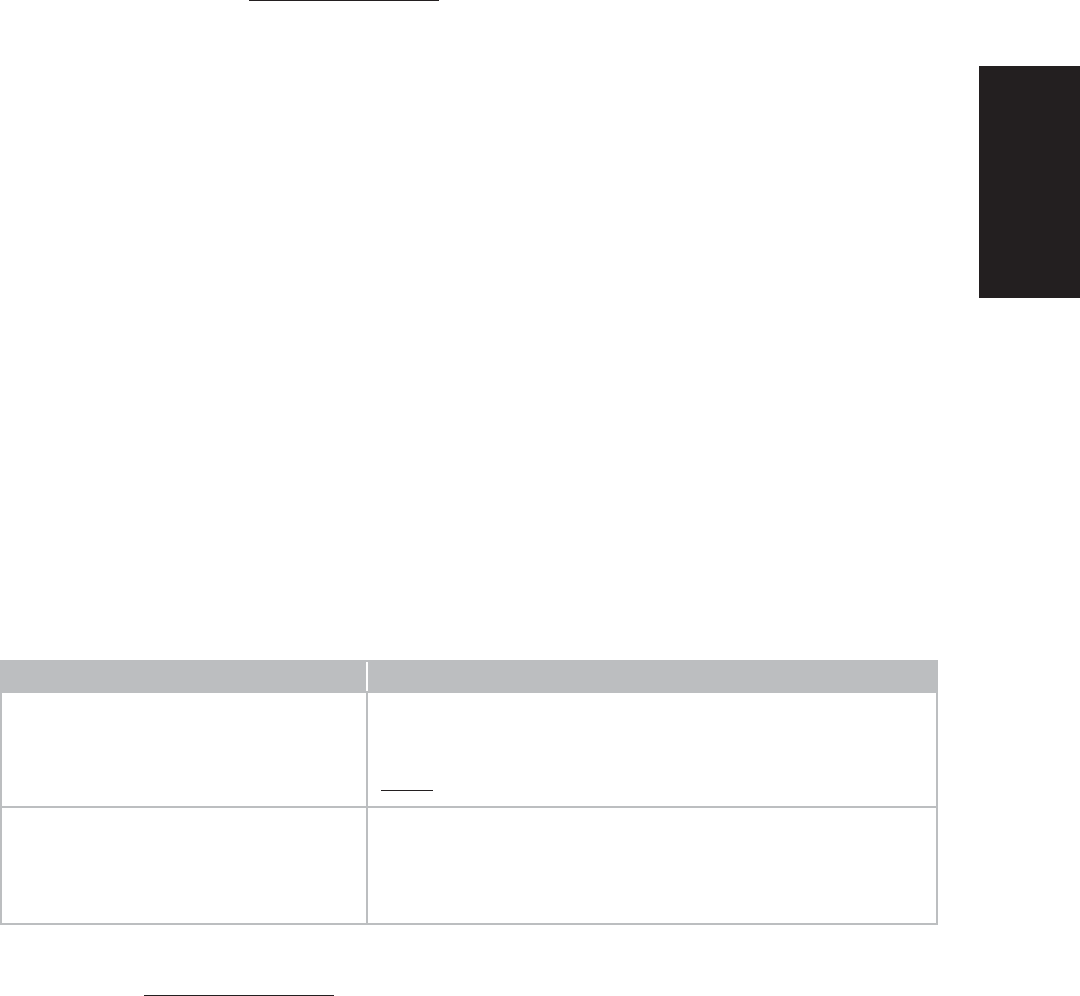
Grades 3–8 English Language Arts and Mathematics Tests School Administrator’s Manual v202
Preparing for
the Tests
●
Teacher’s Directions: Schools will receive two Teacher’s Directions, either PBT or CBT accordingly, for
every 25 students tested. If additional copies are needed, the Teacher’s Directions may be photocopied or
downloaded from the Department’s website (http://www.p12.nysed.gov/assessment/ei/eigen.html).
●
Test Booklets: For PBT administration, the regular edition of the test booklets will arrive shrink-
wrapped in packages of 10 or 25. The braille and large type test booklets will be shrink-wrapped
and will be included in the exact quantity requested by the school. The Spanish editions of the
mathematics test booklets will be shrink-wrapped in packages of 10 or 25. All other translated
editions of the mathematics test booklets will be shrink-wrapped in the exact quantity requested by
the school. The Test Read editions and English versions to accompany translated editions of the test
booklets will be shrink-wrapped in packages of 5 or 15 with a yellow label on the package. All
school personnel must leave the shrink-wrapped packages intact until the day of test
administration, when class packets are assembled.
The shrink-wrapped packages of secure test materials must not be opened during the inventory.
All secure test materials must remain sealed until the test administration date. Boxes used for
delivering materials to your school should be kept for storing and sending completed paper-
based test booklets and answer sheets to scoring sites.
Request Emergency Supply of Secure Test Booklets
All shipments of secure test materials should be inventoried immediately after delivery and before being
placed in the safe or vault. School personnel are forbidden to make or authorize photocopies of secure
State test materials without the express written prior approval of OSA. Such approval will be considered
only when it is not feasible for the school to obtain the secure test materials from a regional center. If
you have questions concerning the requesting of test materials, or about any of the other information,
call Questar Customer Support at 866-997-0695 for assistance.
After taking inventory, if: Then:
An item or items are missing from the
shipment listed on the shipping notice
Contact Questar Customer Support at:
Telephone: 866-997-0695
E-mail (ny[email protected])
The school requires items that were not
originally requested or items necessary to
accommodate students whose needs
were previously unknown to the school
Contact the official in charge of the regional center to arrange
for pickup of test materials. Notify Questar Customer Support, by
e-mail, which test materials will be picked up at the regional
center. Questar will work with the regional center to ensure they
have sufficient quantities of test materials for distribution.
Secure materials can be obtained from the regional center. Information on the location of regional centers is
available on the Department’s website (http://www.p12.nysed.gov/assessment/ei/eigen.html). For the list of
regional centers for New York City public and charter schools, see Appendix R: New York City
Department of Education 2020–21 Borough Assessment Implementation Directors.
The official school representative picking up secure test materials must present to the regional center
official a photo ID and a letter of authorization signed by the principal listing the materials to be picked
up. This letter, authorizing the school representative to pick up test materials, must be written on school
stationery.
19

Grades 3–8 English Language Arts and Mathematics Tests School Administrator’s Manual v202
Preparing for
the Tests
The school representative must countersign the authorization letter, and leave it with the regional center
official before the emergency supply of materials can be released.
Store Secure Test Materials
The English language arts and mathematics paper-based secure test materials must be stored in the safe
or vault of the building where the tests will be shipped. Student login tickets, access codes, and
Proctor PINs for CBT administration must also be stored in the safe or vault if they are printed prior to
administration.
●
Place all secure test materials and test booklets in the storage location as soon as they are received
or printed.
●
If the building where the tests will be administered does not have a safe or vault large enough to
hold the secure test materials, make arrangements to store these materials at a school or district
location with an appropriate safe or vault. Do not transfer tests to the school where the tests will
be administered until the day scheduled for the administration of that part of the test.
●
Restrict access to the test materials.
●
Do not remove shrink-wrapped packages of secure material from the safe or vault, except for the
inventory of PBT materials, until the days on which the tests are scheduled to be administered.
●
Use the Secure Materials Tracking Log, located in Appendix C, to document the movement of
materials and account for all secure testing materials.
●
Check the safe or vault where secure test materials are being stored daily to ensure that the secure
test materials have not been tampered with and remain secure.
●
Maintain the combination or key to the safe or vault under strict security conditions to preclude
access to the secure test materials.
Prepare the Testing Room(s)
Be sure to:
●
Determine which rooms will be used for testing.
●
Make sure the room(s) in which the tests are administered are well-lit, well-ventilated, and quiet.
●
Make preparations before the testing period to keep noise and other distractions to a minimum.
●
Prepare a “Do Not Disturb” sign to place on the door to prevent interruptions.
●
If tests are to be administered in a classroom, clear desks and shelves under the desks of all books,
papers, and other materials.
●
Completely cover or remove from the walls all blank or completed graphic organizers, number
lines, mathematics tables, and all aids, charts, posters, and board work pertinent to English
language arts and mathematics. This includes any such materials that pertain to the New York
State CBT system tools.
●
Make arrangements in advance to seat students so that each student will be clearly visible to the
proctor at all times and so that there will be the least possible opportunity for any communication
between students. Seating of students in alternate rows is recommended.
20

Grades 3–8 English Language Arts and Mathematics Tests School Administrator’s Manual v202
Preparing for
the Tests
For computer-based testing:
●
A seating chart is recommended in the event that the Internet fails and a student needs to go back
to a certain device to submit their test at a later time. Seating of students in alternate rows is
recommended. For additional suggestions for arranging a secure testing environment, see
Appendix W: Suggestions for Creating a Secure Computer-Based Testing Environment.
●
Each student will need their own device that has been configured for testing. Please work with
your School or District IT Coordinator to verify the devices are ready for testing. The Setup and
Installation Guide (https://cbtsupport.nysed.gov/hc/en-us/articles/208474306) has detailed
instructions for setting up devices for testing.
●
Ensure that teachers have printed student login tickets, Proctor PINs, and the session access code
prior to testing. For information on how to print student login tickets (page A-75) and where to
find the session access code (page A-72), see the section on the Tests tab that begins on page A-70
of Appendix Y: Nextera
™
Administration System.
21

Part 2
Administering
the Tests
Administering
the Tests

24
Administering
the Tests
Grades 3–8 English Language Arts and Mathematics Tests School Administrator’s Manual v202
School Administrator Responsibilities
It is the responsibility of the school administrator to:
●
Inventory all testing materials.
●
Store secure test materials in a safe or vault, as designated in the school’s Examination StoragePlan.
•
For computer-based testing administration, the student login tickets, session access codes,
and Proctor PINs are secure test materials and must also be stored in the safe or vault if they
are printed prior to the test administration.
●
Ensure paper-based secure test materials remain sealed in their packaging until the dates on which
they will be administered.
●
Distribute the materials to the teachers or proctors, and ensure the security of the tests.
●
Advise all teachers administering and scoring the tests that they are not to discuss test questions or
other specific test content with each other outside of the scoring room, with others online via
e-mail, or through any other electronic means.
●
Ensure that students with disabilities are provided allowable testing accommodations as indicated on
a student’s Individualized Education Program (IEP) or Section 504 Accommodation Plan (504 Plan).
●
Ensure that teachers, aides, and assistants receive training to ensure the correct implementation of
testing accommodations.

25
Grades 3–8 English Language Arts and Mathematics Tests School Administrator’s Manual v202
Administering
the Tests
Prepare the Grades 3–8 Paper-Based English
Language Arts Secure Test Materials and
Answer Sheets
In order to prepare the secure materials for paper-based testing (PBT), schools must take the following
steps:
●
Verify that the school has the following for each student in the class:
•
Answer sheet for use with English Language Arts Test Session 1.
•
Preprinted student identification label for English Language Arts Test Session 2.
●
If the school does not have a precoded answer sheet or student identification label for a student,
complete one of the extra answer sheets and labels provided by the Regional Information
Center (RIC) or Large-City Scanning Center. Record demographic information for that student
according to district/regional directions.
●
Record on the answer sheet the categories of testing accommodations for students with disabilities.
Only darken the circle if an accommodation was provided during the test. Please note that not all
the accommodations listed in Appendix H: Specific Testing Accommodations are permitted on
all parts of the Grades 3–8 English Language Arts Tests.
●
A student identification label must be affixed to each student’s English Language Arts Test
Session 2 booklet. Labels can be affixed either on the days of the tests or after the administration
of the tests.
If the school chooses to affix the student label(s) prior to administration on the days of the tests, be sure
that each student receives the test booklet with their name on the affixed label.
Under no circumstances may a school open the shrink-wrapped packages and affix the student
identification labels to the Session 2 test booklets prior to the day that the Session 2 test
booklets will be administered.
The following chart lists the English language arts materials needed in each testing room at each grade
level for each paper-based testing day.
English Language Arts
Session 1 Session 2
Grades 3–8
•
PBT Teacher’s Directions
•
Classroom roster
•
Session 1 test booklets (one per student and
one for the teacher)
•
English Language Arts Test Answer Sheet
(one per student)
•
PBT Teacher’s Directions
•
Classroom roster
•
Session 2 test booklets (one per student and
one for the teacher)
•
Student identification labels (one per
student to be used on Session 2 test booklet)

26
Administering
the Tests
Grades 3–8 English Language Arts and Mathematics Tests School Administrator’s Manual v202
Prepare the Grades 3–8 Computer-Based
English Language Arts Secure Test Materials
In order to prepare the secure materials for computer-based testing (CBT), schools must take the following
steps:
●
The building Principal and/or the School Test Coordinator must provide the following prior to each
session:
•
Printed student login tickets for all students who will be testing (see directions beginning on
page A-75)
•
The session access code to begin the applicable planned sessions found on the Nextera
™
Administration System Tests tab (see directions beginning on page A-70)
•
The secure Proctor PIN found on the Nextera
™
Administration System Home page (see
directions beginning on page A-47)
•
Scratch paper (one piece of lined paper per student)—For all test sessions the proctor should
have a further supply of scratch paper on hand to provide to students who request
additional sheets during the test session
The following chart lists the English language arts materials needed in each testing room at each grade
level for each computer-based testing day.
English Language Arts
Session 1 Session 2
Grades 3–8
•
CBT Teacher’s Directions
•
Classroom roster
•
Student login tickets for students who will
be testing
•
Access code for students to begin applicable
sessions
•
Proctor PIN for reactivating paused tests
•
Scratch paper (one piece of lined paper per
student)
•
Individual student device
•
CBT Teacher’s Directions
•
Classroom roster
•
Student login tickets for students who will
be testing
•
Access code for students to begin applicable
sessions
•
Proctor PIN for reactivating paused tests
•
Scratch paper (one piece of lined paper per
student)
•
Individual student device

27
Grades 3–8 English Language Arts and Mathematics Tests School Administrator’s Manual v202
Administering
the Tests
Prepare the Grades 3–8 Paper-Based
Mathematics Secure Test Materials and
Answer Sheets
In order to prepare the secure materials for testing, schools must take the following steps:
●
Verify that each student in the class has the following:
•
Answer Sheet 1 for use with Mathematics Test Session 1.
•
Answer Sheet 2 for use with Mathematics Test Session 2.
•
Preprinted student identification label for Mathematics Test Session 2.
●
If the school does not have a precoded answer sheet or student identification label for a student,
complete one of the extra answer sheets and labels provided by the RIC or Large-City Scanning
Center. Record demographic information for that student according to district/regional directions.
●
Record on the answer sheet the categories of testing accommodations for students with disabilities.
Only darken the circle if an accommodation was provided during the test. Please note that not all
the accommodations listed in Appendix H: Specific Testing Accommodations are permitted on
all parts of the Grades 3–8 Mathematics Tests.
●
A student identification label must be affixed to each student’s Mathematics Test Session 2
booklet. Labels can be affixed either on the days of the tests or after the administration of the tests.
If the school chooses to affix the student label(s) prior to administration on the days of the tests, be sure
that each student receives the test booklet with their name on the affixed label.
Under no circumstances may a school open the shrink-wrapped packages and affix the student
identification labels to the Session 2 test booklets prior to the day that the Session 2 test
booklets will be administered.

28
Administering
the Tests
Grades 3–8 English Language Arts and Mathematics Tests School Administrator’s Manual v202
The following chart lists the mathematics materials needed in each testing room at each grade level
for each paper-based testing day. Reference sheets for Grades 5–8 are included in each Session 1 and
Session 2 test booklet.
Mathematics
Session 1 Session 2
Grades 3–4
•
PBT Teacher’s Directions
•
Classroom roster
•
Session 1 test booklet (one per student
and one for the teacher)
•
Mathematics Test Answer Sheet 1 (one per
student)
•
Rulers (one per student)
Grade 4 only:
•
Protractors (one per student)
•
PBT Teacher’s Directions
•
Classroom roster
•
Session 2 test booklet (one per student
and one for the teacher)
•
Mathematics Test Answer Sheet 2 (one per
student)
•
Rulers (one per student)
Grade 4 only:
•
Protractors (one per student)
Grades 5–6
•
PBT Teacher’s Directions
•
Classroom roster
•
Session 1 test booklet (one per student
and one for the teacher)
•
Mathematics Test Answer Sheet 1 (one per
student)
•
Rulers (one per student)
•
Protractors (one per student)
•
PBT Teacher’s Directions
•
Classroom roster
•
Session 2 test booklet (one per student
and one for the teacher)
•
Mathematics Test Answer Sheet 2 (one per
student)
•
Rulers (one per student)
•
Protractors (one per student)
Grade 6 only:
•
Scientific or four-function calculators with
a square root key (one per student)
Grades 7–8
•
PBT Teacher’s Directions
•
Classroom roster
•
Session 1 test booklet (one per student
and one for the teacher)
•
Mathematics Test Answer Sheet 1 (one per
student)
•
Rulers (one per student)
•
Protractors (one per student)
•
Scientific calculators
(one per student)
•
PBT Teacher’s Directions
•
Classroom roster
•
Session 2 test booklet (one per student
and one for the teacher)
•
Mathematics Test Answer Sheet 2 (one per
student)
•
Rulers (one per student)
•
Protractors (one per student)
•
Scientific calculators
(one per student)

29
Grades 3–8 English Language Arts and Mathematics Tests School Administrator’s Manual v202
Administering
the Tests
Prepare the Grades 3–8 Computer-Based
Mathematics Secure Test Materials
In order to prepare the secure materials for computer-based testing, schools must take the following steps:
●
The building Principal and/or the School Test Coordinator must provide the following prior to each
session:
•
Printed student login tickets for all students who will be testing (see directions beginning on
page A-75)
•
The session access code to begin the applicable planned sessions found on the Nextera
™
Administration System Tests tab (see directions beginning on page A-70)
•
The secure Proctor PIN found on the Nextera
™
Administration System Home page (see
directions beginning on page A-47)
•
Scratch Paper (one piece of lined or plain paper and one piece of graph paper per student).
For all test sessions the proctor should have a further supply of scratch paper on hand to
provide to students who request additional sheets during the test sessions
•
Mathematics Reference Sheet (Grades 5–8 only)
The following chart lists the mathematics materials needed in each testing room at each grade level for
each computer-based testing day.
Mathematics
Session 1 Session 2
Grades 3–8
•
CBT Teacher’s Directions
•
Classroom roster
•
Student login tickets for students who will
be testing
•
Session access code for students to begin
applicable sessions
•
Proctor PIN for reactivating paused tests
•
Scratch Paper (one piece of lined or plain
paper and one piece of graph paper per
student)
•
CBT Teacher’s Directions
•
Classroom roster
•
Student login tickets for students who will
be testing
•
Session access code for students to begin
applicable sessions
•
Proctor PIN for reactivating paused tests
•
Scratch Paper (one piece of lined or plain
paper and one piece of graph paper per
student)
Grades 5–8
•
Mathematics Reference Sheet
•
Mathematics Reference Sheet
Grade 6 only:
•
Scientific or four-function calculators with a
square root key (one per student)*
Grades 7–8
•
Scientific calculators (one per student)*
•
Scientific calculators (one per student)*
*For students testing on computers in Grade 6 for Session 2 and Grades 7–8 for Sessions 1 and 2, a
calculator is provided as part of the computer testing delivery system. However, schools should continue
to supply students with exclusive use of the type of hand-held calculator the students use for everyday
mathematics instruction.

30
Administering
the Tests
Grades 3–8 English Language Arts and Mathematics Tests School Administrator’s Manual v202
Students in Grade 6 are NOT permitted to use a calculator with Session 1. For Session 2, students should
have exclusive use of a four-function calculator with a square root key or a scientific calculator.
Graphing calculators are NOT permitted. Students in Grades 7–8 should have exclusive use of a scientific
calculator for both Session 1 and Session 2. Graphing calculators are NOT permitted.
Supervision of Students
Unauthorized Materials
Students should be under close supervision at all times during the administration of the tests and may
not use any unauthorized notes, printed materials, or tools.
Use of Communications Devices
All students are prohibited from bringing cell phones and certain other electronic devices, as defined in
the script below, into a testing room. Test proctors, test monitors, and school officials shall retain the
right to collect and hold any prohibited electronic devices prior to the start of the test administration.
Admission to the test shall be denied to any student who is in possession of a cell phone or other
prohibited electronic device and refuses to relinquish it.
At the beginning of each test administration, proctors must read the following statement to all
students taking State examinations:
You cannot have any communications device, including a cell phone, with you during this examination
or during any breaks (such as a restroom visit). Such devices include, but are not limited to:
■
Cell phones
■
iPods and MP3 players
■
iPads, tablets, and other eReaders
■
Personal laptops, notebooks, or any other computing devices
■
Cameras, other photographic equipment, and scanning devices
■
Wearable devices/smart wearables, including smart watches and health wearables with a
display
■
Headphones, headsets, or in-ear headphones such as earbuds, and
■
Any other device capable of recording audio, photographic, or video content, or capable of
viewing or playing back such content, or sending/receiving text, audio, or video messages
If you brought any of these items to the building today, and have not already stored it in your locker or
turned it over to me, a test monitor or school official, you must give it to me now. You may not keep
your cell phone or any of these items with you, or near you, including in your pockets, backpack, desk,
etc. If you keep a cell phone or any of these items with you, your examination will be invalidated and
you will get no score. Is there anyone who needs to give me any of these items now?
[Proctor: repeat list of devices.]
This is your last opportunity to do so before the test begins.

31
Grades 3–8 English Language Arts and Mathematics Tests School Administrator’s Manual v202
Administering
the Tests
If any student is observed with any prohibited device while taking a State examination, the proctor must
direct the student to turn the device over to the proctor immediately; allow the student to complete the
test (to allow for all possible outcomes of procedural due process); and report the incident promptly to
the school principal.
If the student had a prohibited device in their possession during the test administration, the principal
must invalidate the student’s test (no score may be calculated for that student) and report the incident
to the Office of State Assessment (OSA).
Note: Some students with disabilities may use certain recording/playback devices only if this
accommodation is specifically required as a provision of the student’s IEP or 504 Plan. In addition, a
student may be allowed to retain an otherwise prohibited device in their possession if there is
documentation on file at the school from a medical practitioner that the student requires such a device
during testing. Without such documentation, the general policy on communications devices as provided
on the previous page is in effect, and the school may not allow the student to retain any such equipment
while testing.
Aid to Students
No one, under any circumstances, may interpret or explain test questions to students, nor may anyone
review or comment to students about the correctness or sufficiency of the students’ responses while the
tests are in progress. In response to inquiries by students concerning the meaning or interpretation of test
questions, proctors should advise students to use their own best judgment. Proctors may give students
assistance only in the mechanics of taking the tests, such as understanding that for PBT, multiple-choice
responses must be recorded on the answer sheets and constructed responses must be recorded in the
test booklets or, for CBT, understanding the navigation of the Nextera
™
Test Delivery System or that their
responses must be entered into the Nextera
™
Test Delivery System. Prior to concluding test sessions, the
proctor should point out to the students if they have left one or more answers completely blank, or, for
PBT, have darkened more than one circle for the same multiple-choice question.
Temporary Absence from Testing Room
No student may be permitted to leave and then return to the testing room during any part of the test
unless the student is accompanied by a proctor for the duration of their absence from the testingroom.
Emergency Evacuation of a School Building
Evacuation of a school building during testing may be required because of an emergency such as a fire
alarm or bomb threat. In any situation in which the safety of students is endangered, the principal has full
authority to interrupt the tests immediately.
If an emergency evacuation is required, school administrators should observe the following procedures.
1. If it is possible, keep students under supervision during the emergency.
2. Then, when work can be resumed safely, allow the students the necessary time to complete
the test.

32
Administering
the Tests
Grades 3–8 English Language Arts and Mathematics Tests School Administrator’s Manual v202
3. Following the test, a written report of the circumstances should be sent by mail or fax to OSA.
(See the section “Reporting Irregularities and/or Misadministrations” on page51.)
Student Cheating
Proctors must not permit students to obtain information from or give information to other students in
any way during the tests. At the conclusion of the tests, all suspected cheating must be reported to the
principal.
If a proctor suspects that such an attempt has occurred, the following actions should be taken:
●
The student(s) should be warned that any further attempts will result in the termination of their
tests.
●
Move students to another location, if necessary.
●
If these steps fail to end attempts to obtain or give information, the proctor must notify the
principal immediately and terminate the students’ tests.
If, in the judgment of the principal, a student has attempted to give aid to or obtain aid from another
person during the tests, the principal must follow the school’s disciplinary procedure for student cheating
and invalidate the student’s test.
Illness
If a student becomes ill during a part of the tests:
●
Excuse the student until they are well enough to continue.
●
When the student is well enough to complete the test (and as long as the testing or make-up
period has not ended), the student may be given the remaining part of the test.
●
If the student is taking a partially completed part of the test, the student must be closely supervised
so that the student does not go back to previously completed questions on the test.
●
As long as the make-up period has not ended, administer any other unadministered parts of the
test according to the Teacher’s Directions.
Proctoring
Proctors must follow all security protocols when supervising the test administration.
Proctors must:
●
Circulate periodically around the room during the administration of each session of the test to
ensure that students are recording their responses to test questions in the proper manner and in
the proper place.
●
For PBT administrations, make sure that students are recording their responses to the test questions
in a proper manner. Students must record their multiple-choice answers on their answer sheets
and not in their test booklets.
●
For CBT administrations, make sure that students are recording their multiple-choice and
constructed-response answers in the Nextera
™
Test Delivery System.

33
Grades 3–8 English Language Arts and Mathematics Tests School Administrator’s Manual v202
Administering
the Tests
●
Point out to students if they have left one or more answers blank or, for PBT, have darkened more
than one circle for the same multiple-choice question.
●
Not comment to the student on the correctness or sufficiency of any answer.
●
Not use cell phones or other photographic devices to duplicate test materials, and keep their own
personal communication devices put away during testing, using them only in emergency situations.
For PBT, make sure each student has recorded their answers to the multiple-choice questions on the answer
sheet before collecting that student’s test materials. No one other than the student may transfer multiple-
choice answers marked in the test booklet to the answer sheet. (The latter does not apply to students
whose IEP or 504Plan allows scribes to transfer answers from the test booklet to an answer sheet.)
For CBT, proctors should review the Review screen with the student to ensure the student has answered
all of the questions before the student selects Submit Test.
Untimed Testing
As long as students are productively working, they should be allowed as much time as they need within
the confines of the regular school day to complete that day’s test session. For planning purposes only,
estimated average times that most students will need to complete test sessions are provided on page 4 of
this manual. Some students will take more or less time than the estimated averages provided on page 4
for both English language arts and mathematics. Please plan accordingly to allow students who are
productively working to complete the test at their own pace each day.
Students who finish the test before other students may check their work. When a student is ready, the
PBT materials may be collected by the proctor, or the test may be submitted by the student for
CBT administration. After a student’s PBT materials are collected or their computer-based test is submitted,
that student may be permitted to read silently. This privilege is granted at the discretion of each school.
No talking and no other schoolwork is permitted. Once all students complete the test, you may end the
session.
Testing Accommodation – Extended Time
Because the English Language Arts and Mathematics Tests are untimed, the accommodation of extended
time will in essence be available to all students including all students with disabilities and English Language
Learners. However, students with disabilities who have flexibility in scheduling, such as breaks at specified
intervals, indicated as an accommodation in their IEPs or 504 Plans, must be provided such accommodation.
Supervised Lunch Breaks
It is recommended that schools schedule the test sessions either at the start of the school day or immediately
after lunch so that most students will have a sufficient block of time to complete each test session. It is
further recommended that schools group together for testing those students who are expected to require
more time to complete a test session than the pre-lunch or post-lunch block of time provides. Schools may
arrange for such students to have a carefully supervised lunch break during any of the test sessions if
necessary. Secure test materials should be collected from the students prior to the start of the lunch break
and returned to those who had not completed the test following the supervised lunch break. The school
may permit these students to talk with each other and with the supervising adults during the lunch break

34
Administering
the Tests
Grades 3–8 English Language Arts and Mathematics Tests School Administrator’s Manual v202
but must be instructed that they may not discuss the test content during this time. So that their tests will
not have to be invalidated, the proctor should not allow any students to resume work on a test session
who during the lunch break violated the instruction not to discuss the test content.
Limitations in Timing
As long as they are productively working, students should be allowed as much time as they need only
within the confines of the regular school day to complete each test session. Schools are not expected to
extend the school day in order for students to complete a test session. In addition, schools may not
extend a test session beyond its scheduled day unless the student has multiple-day testing as a specified
testing accommodation in their IEP or 504 Plan.
For questions and guidance on how to implement this policy, schools and districts are asked to contact
their regional District Superintendent’s office. District Superintendents will provide the technical guidance
and support to help ensure their member districts are able to carry out this policy within their unique
local and regional constraints.
Make-up Testing
The make-up dates are to be used for administering the tests to students who were absent during the
designated administration dates. Make-ups for PBT and CBT for a given grade may begin on the school
day immediately following the first day of the primary test administration. The testing schedule is posted
on the Department’s website, 2020–21 Elementary- and Intermediate-Level Testing Schedule (http://
www.p12.nysed.gov/assessment/schedules/2021/ei-test-schedule21rev.pdf). The make-up dates can also
be used to complete the initial administrations in schools that were closed due to religious observance or
unexpected events, such as power outages.
It is the principal’s responsibility to facilitate testing during the make-up period for those students who
did not complete the tests on the regularly scheduled testing dates. Rules to Determine Whether a
Student Receives a Valid Score are found in Appendix P of this manual.
Ensure the following if administering a make-up test.
●
Students should be given every opportunity to make up any missed test session.
●
The student completes all of the sessions in a subject area test. (In order to be counted as
participating in that test and receive a scale score and performance level, all sessions of a test
subject [two sessions for the Grades 3–8 English Language Arts Tests and two sessions for the
Grades 3–8 Mathematics Tests] must be administered.)
●
Apply the following guidelines for make-up testing for all sessions:
•
Students who are absent during any session of the regularly scheduled test administration
should take the session of the test scheduled for the day they return.

35
Grades 3–8 English Language Arts and Mathematics Tests School Administrator’s Manual v202
Administering
the Tests
•
Students who are absent throughout the regularly scheduled test administration should
complete both sessions of the test during make-up testing. More than one session may be
administered in one day. Administer these sessions in the same order for regularly scheduled
testing as indicated in the Teacher’s Directions.
•
For students who are absent for any session of a PBT and do not take a make-up for that
session, check their answer sheets to verify that the absences have been recorded by
darkening the Absent circle corresponding to the session or sessions missed. Instructions for
recording information about absences on the answer sheets are found in Appendix P of
this manual.
•
For students who are absent for any session of a CBT and do not take the make-up for that
session, check the Nextera
™
Administration System to verify the Absent reason for not
testing has been indicated. Information on indicating the reason for not testing in the
Nextera
™
Administration System can be found in Appendix Y: Nextera
™
Administration
System beginning on page A-44 of this manual.
Concluding Test Sessions
As soon as each testing session is completed, the principal must arrange for the collection and secure
storage of all used and unused secure test materials (regular, translated, large type, and/or braille test
booklets for PBT administrations; student login tickets, session access codes, Proctor PINs, scratch paper,
and math reference sheets for CBT administrations) and used answer sheets. Used answer sheets may
not be reviewed, scanned, or scored by anyone before the official scoring process has been
completed and the answer sheets have been scanned by the RIC or Large-City Scanning Center.

36
Administering
the Tests
Grades 3–8 English Language Arts and Mathematics Tests School Administrator’s Manual v202
Administrator’s Checklist for Collecting, Storing, and
Organizing Secure Paper-Based Testing Materials
Before repacking secure PBT materials, please read the following instructions:
❏
Collect all secure test materials, including used test booklets, answer sheets, completed
demographic data, and student identification labels. Place these in a secure location until they are
to be assembled for scoring.
❏
Teacher’s Directions should be left in the testing rooms with the teachers so that they may review
the instructions for the remaining test session(s).
❏
Request that each teacher provide updated classroom rosters for the Grades 3–8 English Language
Arts and Mathematics Tests. These rosters should include all students currently in each teacher’s
class.
❏
Advise all staff that they are not to discuss test questions or other specific test content with each
other, with others online via e-mail, or by any other electronic means.
❏
When collecting the test materials at the end of each test session, ensure each student places their
answer sheet inside the front cover of the test booklet. (Note: Session 2 for English Language Arts
does not have a separate answer sheet.)
❏
At the conclusion of the English Language Arts Tests, separate used Session 1 booklets and
Session 2 booklets. Remove each student’s Answer Sheet 1 from the student’s English Language
Arts Test Session 1 booklet and insert it inside the front cover of that student’s Session 2 booklet.
English Language Arts Test Session 2 booklets need to be sent to
the scoring site, along with
Answer Sheet 1, unless locally scored.
❏
At the conclusion of the Mathematics Tests, separate used Session 1 booklets and Session 2
booklets. Remove each student’s Answer Sheet 1 from the student’s Mathematics Test Session 1
booklet and send only the answer sheets to the RIC or Large-City Scanning Center. Mathematics
Session 2 booklets need to be sent to the scoring site, along with Answer Sheet 2, unless locally
scored.
❏
Securely store all unused test booklets for all grades and all used English Language Arts Test
Session 1 test booklets and Mathematics Test Session 1 test booklets. Keep all English Language
Arts Test booklets separate from all Mathematics Test booklets.
❏
Stack the used test booklets by testing room for scoring. Place the appropriate classroom roster
on top of each stack and band them together.
❏
Use the box(es) in which secure test materials arrived for storing the secure test materials and for
sending them to the scoring site. Remove any previous markings and labels from the box(es). If
original boxes are not available, use substitutes.
❏
For more information on the handling of all paper test booklets and secure materials after testing,
see Part 3, After Testing.

37
Grades 3–8 English Language Arts and Mathematics Tests School Administrator’s Manual v202
Administering
the Tests
Administrator’s Checklist for Collecting, Storing, and
Organizing Secure Computer-Based Testing Materials
At the conclusion of the CBT session, please follow these instructions:
❏
Collect and securely destroy all used scratch paper, printed student login tickets, session access
codes, and Proctor PINs.
❏
If student login tickets, session access codes, or Proctor PINs are to be used for future test sessions,
store in a secure location as designated in the school’s Examination Storage Plan until needed.
❏
CBT Teacher’s Directions should be left in the testing rooms with the teachers so that they may
review the instructions for the remaining test session(s).
❏
Advise all staff that they are not to discuss test questions or other specific test content with each
other, with others online via e-mail, or by any other electronic means.
❏
For information on the handling of all paper test booklets and secure materials after testing see
Part 3, After Testing.

Part 3
After Testing
After Testing

40
After Testing
Grades 3–8 English Language Arts and Mathematics Tests School Administrator’s Manual v202
Scoring of Secure Materials
Prepare Secure Paper-Based Testing Materials for Scoring
The following steps describe the procedures for scoring paper-based testing (PBT) materials at regional
and schoolwide scoring levels.
Checklist for Regional or Districtwide Scoring:
❏
Photocopy and complete the Paper-Based Testing School/Group List located in Appendix J of
this manual. Transfer the total number of students tested for each class (indicated on the teacher’s
classroom roster) to the School/Group List (SGL). Repeat this process for each testing room. Fill out
the requested information for each testing room in the school.
•
Testing Room Number: Write the room number of each testing room.
•
Grade: Write the grade of the students who took the test (e.g., Grade 3).
•
Number Tested: Write the number of students who took the test. Be sure to include students
who took make-up tests.
•
Comments: Include any additional pertinent information.
❏
English Language Arts Test Session 2 booklets and Mathematics Test Session 2 booklets must be
sent for scoring since there are written responses in these booklets. Place the used booklets in
separate boxes. English Language Arts Test Session 1 booklets and Mathematics Test Session 1
booklets should not be sent to the scoring sites since these booklets contain multiple-choice
questions exclusively, for which students record their answers on separate answer sheets.
❏
Put the appropriate SGLs with the classroom rosters on top of the used English Language Arts Test
Session 2 booklets and Mathematics Test Session 2 booklets in their respective Box 1s.
❏
Attach the appropriate box label, provided in Appendix K: Box Labels for Submission of
Paper-Based Testing Booklets to Scoring Center, to each box, and indicate the scoring site, the
school name, Basic Educational Data System (BEDS) Code, and the grade levels for which test
booklets are enclosed. Also indicate on the respective label the quantity of English Language Arts
Test Session 2 booklets or the quantity of Mathematics Test Session 2 booklets enclosed. Label the
boxes for delivery to the scoring site.
❏
Number the box(es) (e.g., “Box 1 of 5,” “2 of 5,” “3 of 5,” etc.).
❏
Seal the box(es) securely with packing tape and follow local testing directions for delivery of
completed test materials to scoring sites.
Checklist for Schoolwide PBT Scoring:
❏
Photocopy and complete the SGL located in Appendix J of this manual. Transfer the total number of
students tested for each class (indicated on the teacher’s classroom roster) to the SGL. Repeat this
process for each testing room. Fill out the requested information for each class in your school:
•
Testing Room Number: Write the room number of each classroom.
•
Grade: Write the grade of the students who took the test (e.g., Grade 3 or ungraded).

41
After Testing
Grades 3–8 English Language Arts and Mathematics Tests School Administrator’s Manual v202
•
Number Tested: Write the number of students who completed the test, including students
who took make-up tests.
•
Comments: Include any additional pertinent information.
❏
Place stacks of banded, used English Language Arts Test Session 2 booklets and Mathematics Test
Session 2 booklets into boxes with the appropriate SGL and classroom roster(s) on top. Place the
used English Language Arts and Mathematics Test booklets in separateboxes.
❏
Keep the completed SGL with the updated classroom roster(s) on top of the used test booklets
being packed for scoring. Send a separate copy of the SGL and classroom roster(s) to the scanning
center.
❏
The used test booklets that have been packed for scoring must be stored in a secure location in the
school until being relocated to the scoring site. Once at the site, the packed used test booklets must
be placed again in a secure location.
Prepare Scorers
Assemble Scoring Materials
Two scoring CDs, one for the Grades 3–8 English Language Arts Tests and one for the Grades 3–8
Mathematics Tests, will be shipped to schools by Questar. Schools will print scoring materials from the
PDFs provided on the CDs. The files are organized by individual grades.
The Scoring Leader Handbook (http://www.p12.nysed.gov/assessment/ei/eigen.html) contains a list of
supplies needed for hand-scoring the student responses.
NOTE: No one is permitted, for any reason, to take any test booklets, answer sheets, or scoring
materials from the scoring site.
Train Scorers
Scorer training may begin after operational testing is completed and make-up testing has begun. In order
to ensure that tests are scored reliably, it is essential that scorers receive scorer training every time they
serve on a committee to score a State test. Please see recommended scorer training time in the Scoring
Leader Handbook. If your scorers have not been previously trained, more training time will be needed on
the scoring day to ensure accurate and reliable scores. Furthermore, those persons responsible for scorer
training must strictly adhere to the training procedures detailed in the Scoring Leader Handbook.
Prior to training, all scorers and score leaders are required to sign the Exam Scoring Confidentiality
Agreement, located in Appendix M of this manual, or Appendix A of the Scoring Leader Handbook.
Scorers and Scoring Leaders agree to maintain and honor the security and confidentiality of all secure test
materials.
A Consistency Assurance Set (CAS) will be provided for each grade. The CAS is to be incorporated into
the scoring training process to:
●
Establish a uniform process statewide for training scorers, and
●
Improve the reliability of statewide scoring.

42
After Testing
Grades 3–8 English Language Arts and Mathematics Tests School Administrator’s Manual v202
During the scorer training for the tests, the CAS should be used to identify areas in which additional
training may be needed in order to ensure inter-rater reliability.
Note: At the time scorer training takes place, scoring materials are secure and may only be shared with
those responsible for scoring student responses. Anyone who will not be scoring tests may not participate
in scorer training.
Assign Scorer Numbers and Questions to Scoring Committee Members
Each scoring committee must be assigned a number. This number is a way of identifying scoring
committees in order to provide feedback when conducting read-behinds. Records of the names of scoring
committee members and the questions assigned to them should be retained in the school for one year.
The answer sheets have a place for teachers to record their scoring committee number. Refer to the
Scoring Leader Handbook (http://www.p12.nysed.gov/assessment/ei/eigen.html) for details.
Generally, teachers on the scoring committees are assigned approximately equal numbers of questions to
score. Questions must be assigned to scorers so that each student’s test is scored by a minimum of three
scorers. To comply with a State requirement, none of the scorers assigned to score a student’s test
responses may be that student’s teacher.
Estimated Time Needed for Scoring
Depending on the grade level of the test, a scoring committee of three can be expected to score
approximately 100–130 students’ English Language Arts Tests or approximately 120–220 students’
Mathematics Tests in one full school day, after the committee has completed the required training. (See
Appendices M and N of the Scoring Leader Handbook for grade-specific scoring read times.)
Operations/Logistics for Scoring the Short- and Extended-
Response Questions
Scoring Room
The room selected for scoring should provide all of the following conditions:
●
Ample lighting,
●
Adequate ventilation, and
●
The capacity to be made secure.
During scoring, the scoring room should be kept as quiet as possible to facilitate accurate and productive
scoring. Scorers may only discuss scoring with the Table Facilitators or the Scoring Leader.
All test booklets, student answer sheets, and scoring manuals must be kept secure and confidential.
These materials must not be left unattended during breaks or lunch, and the room must be kept locked
when unattended during the day and after school hours.

43
After Testing
Grades 3–8 English Language Arts and Mathematics Tests School Administrator’s Manual v202
Checklist for Receiving Materials to Be Scored
Regional Scoring (Scoring Model 1) and Districtwide Scoring (Scoring Models 2–4):
❏
Make sure test booklets have been received from each school.
•
Check the sequential numbering on each box (for example, “1 of 5,” “2 of 5,” etc.) to make
sure that the shipment from each school is complete. If a box is missing, do not continue. Contact
the school administrator to locate the missing box.
❏
Verify that the test booklet count written on each classroom roster matches the number of booklets
received from the school. If the test booklet counts do not match, do not continue. The classroom
roster can be used to determine which students’ test booklets are missing. Contact the school
administrator to locate the missing booklets.
❏
If a shipment is complete, open the boxes and check the first box to find the SGL classroom
roster and packing list. Place these sheets in a safe location because they will be used to make sure
test booklets were received for all tested students.
❏
Create a check-in log with columns for school name, box number (for example, “1 of 5”), date
shipment was received, and check-in date. Use the check-in log to record this information for every
box received. See Appendix M of the Scoring Leader Handbook for a Check-In Log Template.
❏
Determine the number of students whose test booklets were submitted by a school by adding the
number of students reported on the label affixed to the outside of the box(es). Record this total on
the check-in log.
❏
Keep a copy of the check-in log and the packing list for reference.
❏
Stack test booklets by school for randomizing.
Schoolwide Scoring (Scoring Model 5):
❏
Make sure test booklets have been received from each
class that administered paper-based tests.
Verify that the test booklet count written on the classroom roster
matches the number of booklets
received from the class.
❏
If the test booklet counts do not match, do not continue. The classroom roster can be used to
determine which students’ test booklets are missing. Contact the school administrator to locate the
missing booklets.
❏
Continue verifying the number of test booklets from each class, retaining class stacks on the work
table. When every test booklet from all classes is accounted for, the randomizing process
can
begin.
❏
File copies of the classroom rosters for reference.
❏
Stack test booklets by class.
Note: If any English Language Arts Test or Mathematics Test Session 1 booklets are received, they should
be boxed, stored securely until scoring is completed, and then returned to the district orschool.
Randomizing and Building Test Booklet Folders/Boxes
Randomizing PBT booklets is required to maximize the number of teachers scoring any one group of
tests. It involves mixing test booklets from all districts (if scoring regionally), all schools (if scoring

44
After Testing
Grades 3–8 English Language Arts and Mathematics Tests School Administrator’s Manual v202
__
districtwide), or all classes (if scoring locally). These test booklets are then placed into folders or boxes in
preparation forscoring.
To comply with a State requirement, none of the scorers assigned to score a student’s test responses may
be that student’s teacher.
Steps for Randomizing
1. If test booklets for more than one grade level are being scored at the same scoring site, be sure to
separate the test booklets for different grades in different rooms, if possible, or in different
corners of the same room if only one room is available.
2. Focusing on test booklets for only one grade exclusively at a time, select multiple districts, schools,
or classes with approximately equal numbers of test booklets for randomization. Position a box
from each of these districts, schools, or classes in a row on the floor. Line up all remaining boxes
behind their corresponding district, school, or class.
3. Randomly pull a set of booklets from the first box for each district, school, or class, and then
immediately repeat this procedure. Place these sets of booklets for five to ten students in the scoring
folder or box.
4. Continue randomly pulling sets of test booklets from each district, school, or class’s box until all
booklets have been sorted into groups and placed into folders or boxes. If one district, school, or
class box is depleted before the others, continue pulling from the remaining district, school,
or class boxes until all booklets are placed in folders or boxes.
5. If using folders, place folders in boxes. A box (12” x 8
3
”
x 5”) can hold up to 60 test booklets or
4
6–12 folders, but it is suggested that you limit the number of booklets or folders to a weight that
is comfortable to lift.
6. Fill out a box label (See Appendix K). Write the school names and the number of booklets in the
spaces provided.
7. Number each box consecutively (for example, “1 of 3,” “2 of 3,” or “3 of 3”) and tape the box
label securely to the outside of the box.
8. Repeat the process for the remaining districts, schools, or classes at the scoring site.
Staging Test Booklets for Scoring
All boxes will be routed to separate scoring areas depending on the content to be read. Each test booklet
will be scored.
1. Designate a location for each grade and scoring section to stage boxes.
2. At the start of a scoring session, provide enough test booklets to each scoring table for scorers to
score. Make sure the boxes for districts, schools, or classes are distributed to as many tables as
practical within a content area.
Processing Test Booklets During Scoring
The reader work tables will be arranged so that the Table Facilitator/School English Language Arts or
Mathematics Leader is at the head of the table, with up to six readers positioned around the table. All
folders containing sets of test booklets will be routed to the scoring committees.

45
After Testing
Grades 3–8 English Language Arts and Mathematics Tests School Administrator’s Manual v202
The scoring session will proceed as follows:
1. Folders or boxes are placed in the “in-process” box on the scoring table.
2. Scorers will remove a few sets of test booklets, record their scorer number, score their assigned
questions, record their scores on the answer sheet, place the answer sheet inside the test booklet,
and the booklet inside the folder. Scorers will then pass the folder to the next teacher to score (in
a round-robin fashion).
3. If there are any responses that are difficult to score, the scorer should speak with the Table
Facilitator or Scoring Leader.
4. If a scorer reads a student response that reveals a sensitive issue, the scorer should share this
response with the Table Facilitator and the Scoring Site Coordinator. The reporting protocol set
forth for Mandated Reporters must also be followed. A sensitive response includes an indication of
abuse, neglect, or maltreatment, suicidal tendencies, or other psychological problems.
5. If the Scoring Site Coordinator thinks that the student response warrants a formal report, the
coordinator will notify the school principal and/or the school counselor, who will then determine
whether a report should be filed. Papers with sensitive responses must be returned to the school
when scoring is complete.
6. Folders or boxes of unscored test booklets are brought to the work table as needed.
7. When a scorer has completed scoring the questions assigned to that scorer within a test booklet,
the answer sheet will be placed inside the test booklet and returned to the folder.
8. When all questions have been scored, place the folder in the “completed” box.
Read-Behinds
As sets of test booklets are finished being scored, they should be placed in the “completed” box so that
the Table Facilitator can conduct read-behinds. Read-behinds are scored sets of test booklets that are
read again as a check of scorer accuracy and consistency.
The Table Facilitators conduct read-behinds on completed test booklets. Approximately 12sets of test
booklets per hour (that is, two sets per scorer) are read by the Table Facilitator.
A Table Facilitator should not question a score if a response is a “fence-sitter” paper (i.e., a paper for
which either of two contiguous scores could be justified). However, if the Table Facilitator believes that a
particular paper’s score is not in alignment with the rubrics or that an errant pattern of scoring has
developed (i.e., scores are continually out of alignment with the rubrics), the Table Facilitator should not
change the score, but should discuss the response(s) in question with the scorer so that the scorer is able
to correct any scoring errors and return to accurate and consistent scoring.
If a problem persists, the Table Facilitator should bring the situation to the attention of the Scoring Site
Coordinator.
Scoring Helpline
Questar’s Scoring Helpline is available to assist with questions on how to score constructed-response
questions. The scoring helpline can be reached at 888-382-4246, from Monday–Friday between
7:30 a.m. and 4:30 p.m. (ET) during the scoring dates.

46
After Testing
Grades 3–8 English Language Arts and Mathematics Tests School Administrator’s Manual v202
No Double Scoring
Once a set of student test booklets has been completely scored one time, the answer sheet should be
reviewed to ensure that all questions have been scored, scores have been darkened appropriately, and
that there are no stray marks. Preparations should then be made for returning the sets of student test
booklets either back to the school or to a specified location for auditing. Schools will be notified if they
are to participate in the audit. Except for the read-behinds discussed previously, student test booklets
should be scored only once (i.e., no double scoring).
When the teacher scoring committee completes the scoring process, test scores must be considered final
and must be entered onto students’ answer sheets.
Principals and other administrative staff in a school or district do not have the authority to set aside the
scores arrived at by the teacher scoring committee and rescore student test papers or to change any
scores assigned through the procedures described in this manual and in the scoring materials provided by
the Department. Any principal or administrator found to have done so, except in the circumstances
described below, will be in violation of Department policy regarding the scoring of these tests. Teachers
and administrators who violate Department policy with respect to scoring State tests may be subject to
disciplinary action in accordance with Sections 3020 and 3020-a of Education Law, or to action against
their certification pursuant to Part 83 of the Regulations of the Commissioner of Education.
If an administrator has substantial reason to believe that the teacher scoring committee has failed to
accurately score student papers on any test, the administrator must first obtain permission in writing
from the Office of State Assessment (OSA) before arranging for or permitting a rescoring of student
papers. The written request to OSA must come from the superintendent of a public school district or the
chief administrative officer of a religious, independent, or charter school and must include the test title,
date of administration, and number of students whose papers would be subject to such rescoring. This
request must also include a statement explaining why the administrator believes that the teacher scoring
committee failed to score appropriately and, thus, why the administrator believes rescoring the test
papers is necessary. As part of this submission, the school administrator must make clear their
understanding that such extraordinary rescoring may be carried out only by a full committee of teachers
constituted in accordance with the scoring guidelines presented above and fully utilizing the scoring
materials for this test provided by the Department.
The Department occasionally finds it necessary to notify schools of a revision to the scoring guide for the
test. Should this occur after the scoring committee has completed its work, the principal is authorized to
have appropriate members of the scoring committee review students’ responses only to the specific
question(s) referenced in the notification and to adjust students’ scores when appropriate. This is the only
circumstance in which the school is not required to notify or obtain approval from the Department to
correct students’ scores.
Quality-Checking Answer Sheets
The quality-checking procedure involves a review of the scores filled in on the answer sheet by the scorers.
During the quality check, any errors or omissions made by the scorers in recording students’ scores should
be detected and corrected while the booklets and answer sheets are still in the scoring area. The task of
quality-checking the booklets should be assigned to a Scoring Site Assistant and should not be assigned
to the student’s teacher.

47
After Testing
Grades 3–8 English Language Arts and Mathematics Tests School Administrator’s Manual v202
Steps for Quality-Checking the Answer Sheets
1. Make sure the number of booklets in the folder matches the total number written on the
folderlabel.
2. Take the booklets out of the folder. Open the first booklet and inspect the answer sheet to be
sure all fields have been filled in properly. Look for questions with missing scores, lightly marked
scores, and double-marked scores.
3. If questions are marked properly on all answer sheets, the folder is placed in a “completed
scoring” box. These folders are ready for return processing, which means that the answer sheets
are sent to the scanning center and the booklets are returned to the schools.
4. If there are any answer sheets with missing information, a yellow flag is placed in the folder,
which is then put aside until all test booklets have been checked for errors.
5. The sets of test booklets and answer sheets are then given to the appropriate Table Facilitator or
Scoring Leader for corrections. After the corrections are made, return the test booklets and
answer sheets to the quality control station.

48
After Testing
Grades 3–8 English Language Arts and Mathematics Tests School Administrator’s Manual v202
After Paper-Based Testing Scoring is Complete
Forward Answer Sheets to Regional Information Centers or Large-City
Scanning Centers
After all test materials in all folders have been scored and quality-checked, prepare to send answer sheets
to scanning centers. Verify that every folder has been accounted for and scored before removing the
answer sheets.
Steps for Returning the Secure Test Materials to the Schools and Scanning
Centers
1. If scoring regionally or districtwide, sort the sets of test booklets into school groups.
2. Further sort the test booklets into classes, using the classroom roster(s).
3. Count the test booklets and verify the total counts against the totals on the SGL.
4. Remove the test booklets from the folders and ensure that each set of test booklets remains
together.
5. Remove the answer sheets from the test booklets and place them on top of a copy of the SGL and
the classroom rosters, building a stack of answer sheets for the school.
6. Before placing the answer sheets on top of a copy of the SGL and the classroom rosters, verify
that all student information (e.g., name, ID number) is complete.
7. If an answer sheet is soiled or mutilated in some manner, the school must transcribe all student
information and test responses onto an unused answer sheet, which is then added to the stack.
Two staff members, supervised by an administrator or principal, are required for this—one to
transfer answers and one to check that the answers have been transferred accurately. Note that
the transferring of answers is not to be used for students who did not follow testing directions.
(See “Proctoring” on pages 32–33.) Do not fold, bend, tape, or staple any answer sheets.
8. Continue this process until all answer sheets are removed.
9. Count the answer sheets. Verify that the total number of answer sheets equals the number
of students tested.
10. Record the shipment of secure materials on the Secure Materials Tracking Log (Appendix C).
11. Place the answer sheets into a box for shipping. Affix the address label for the appropriate
scanning center. Forward all answer sheets to the designated Regional Information Center (RIC)
or Large-City Scanning Center no later than the due dates designated by the Department.
12. Return test booklets to each school.

49
After Testing
Grades 3–8 English Language Arts and Mathematics Tests School Administrator’s Manual v202
Return of Scoring Ancillary Materials
The Scoring Site Coordinator will be responsible for returning all materials listed below to the schools. Call a
secure package delivery company (such as FedEx, UPS, or DHL) to pick up the materials that day or the next
day, or receive directions to the nearest drop-off location.
The following is a list of materials to be returned to the schools:
●
Scoring Sign-in Log (with assigned scorer numbers).
●
Confidentiality Agreements: verify the completion of all the Confidentiality Agreements for each
scorer and Scoring Site Assistant.
●
Training Materials Inventory Sheet: this is a log verifying the receipt of training materials.
●
Sensitive Papers.
Closing of Scoring Site
After the scoring and preparation of PBT materials for delivery to scanning centers and schools, the
Scoring Site Coordinator supervises the closing of the scoring facility. Scoring Site Assistants, as well as
other members of the leadership team, may help with theseprocedures:
●
Arranging secure shipments of all paper-based answer sheets and test booklets;
●
Checking scoring areas for overlooked materials; and
●
Returning all ancillary materials to schools.

50
After Testing
Grades 3–8 English Language Arts and Mathematics Tests School Administrator’s Manual v202
Destruction of Secure Test Materials
The 2021 Grades 3–8 ELA and Mathematics Tests do not include field test items. Therefore, unused ELA
Test Session 1 and Test Session 2 booklets and unused Mathematics Test Session 1 and Test Session 2
booklets may be retained by the school and used for instructional or staff development purposes after
the scoring period has closed.
No used or unused 2021 Grades 3–8 ELA and Mathematics Test materials need to be returned to
Questar. Used ELA and Mathematics Test Session 1 booklets may be stored securely in the school for one
year, or securely destroyed upon completion of the test administration and scoring. As in past years, all
used answer sheets and Session 2 booklets must be stored securely for a minimum of one year and then
securely destroyed.
Securely Destroy Upon
Completion of
Test Administration
(for CBT only)
Store Securely in School or
District for One Year,
then Securely Destroy
•
All used scratch paper
•
Student login tickets, session
access codes, and Proctor PINs
•
All used printed English
Language Arts Test Session 2
booklets
•
All used printed Mathematics
Test Session 2 booklets
•
All used printed answer sheets
after their return from the
scanning center

51
After Testing
Grades 3–8 English Language Arts and Mathematics Tests School Administrator’s Manual v202
Reporting Irregularities and/or
Misadministrations
Pursuant to Section 102.3 of the Regulations of the Commissioner of Education, “Building principals are
responsible for administering department examinations and maintaining the integrity of examination
content and programs, in accordance with directions and procedures established by the commissioner.”
Accordingly, the building principal is responsible for all aspects of the school’s test administration and
must take appropriate measures both to prevent, as much as possible, and to investigate all security
breaches and irregularities associated with the administration and scoring of the test. In addition,
the principal must report the following testing irregularities and misconduct by students—in writing,
on school letterhead, and signed by the principal—to OSA via fax to 518-474-1989 or by e-mail to
[email protected]. New York City public schools must also e-mail [email protected].
●
All student infractions of the Department’s policy prohibiting the possession or use of cell phones
and other communications devices during State tests.
●
All confirmed cases of students cheating.
●
All interruptions of test sessions, including those caused by power outages, internet service
interruptions, or firealarms.
●
All instances in which a State test is administered without Department authorization on a date
outside the published statewide administration or make-up schedule.
●
All instances in which scorers do not rate State tests in accordance with the scoring materials
provided by the Department.
●
All cases in which printed student test booklets or answer sheets are lost prior to either the scoring
of the tests or submission of the answer sheets to the RIC or Large-City Scanning Center.
●
All instances of school officials or staff members providing students with unauthorized/
inappropriate testing accommodations or tools (such as the use of a calculator for the Grades3–5
Mathematics Tests).
●
All instances of school officials or staff members providing students with other nonstandard test
administrations, unrelated to cheating.
The report, signed by the principal, must include:
●
The school’s Basic Educational Data System (BEDS) Code,
●
The school name,
●
The home school/district name,
●
The name and grade of the test,
●
A brief description of the incident,
●
The number of students affected,
●
The New York State Student Identification System (NYSSIS) ID numbers of affected students, and
●
The principal’s determination as to whether the incident constitutes a misadministration.

52
After Testing
Grades 3–8 English Language Arts and Mathematics Tests School Administrator’s Manual v202
Mandatory Reporting of Testing Improprieties by Adults
The Department’s Test Security Unit (TSU) handles all reports of testing improprieties by adults involved in
the administration and scoring of State tests. School officials and personnel are required to report any
incident of testing misconduct by an educator or other adult involved in testing. Reports should be made
via the TSU website (http://www.highered.nysed.gov/tsei) by submitting the incident report form located
on the main page under the tab “Report Educator Test Fraud.”
No adverse action, including dismissal and any disciplinary action, may be taken against an employee
who files a mandatory report of testing misconduct because the employee filed a report. Anyone who
takes such unwarranted adverse action against another employee may face disciplinary action by the
Department.
Examples of Improper Testing Conduct Reported to TSU
●
All suspected or confirmed cases of a school official or staff member giving aid or impromptu lessons
on specific test content to students immediately before or during a State test or altering student
responses on a test.
●
All cases in which a school official or staff member does not adhere to the Department policy
concerning finality of test scores as determined by the teacher scoring committees. This is explained
on page 46 of this manual under the heading “No Double Scoring.”
●
All instances of an administrator or teacher instructing another administrator or teacher to alter or
interfere with a student’s testscore.
Coding of Invalid Tests
Any breaches or irregularities, except interruptions caused by power outages or alarms, may be
determined by the school or by the Department to invalidate a student’s test results. In cases where a
student’s test has been invalidated, the principal must:
1. For a paper-based test, darken the circle on the affected student’s answer sheet denoting
“administrative error.”
•
For a computer-based test, indicate the “administrative error” in the Nextera
™
Administration
System. Directions for setting Testing Status Codes can be found on page A-73 in Appendix Y:
Nextera
™
Administration System of this manual.
2. Notify the RIC or Large-City Scanning Center of the administrative error. In order to expedite
accurate reporting, provide the BEDS Code, School Name, Subject, Grade, and NYSSIS IDs.
3. In the Student Information Repository System (SIRS), in the Assessment Standard Achieved Code
field, students must be coded as “administrative error with Standard Achieved Code of 97.” Please
work with your RIC or Large-City Scanning Center to make sure these students are reported
properly in SIRS.
4. On the verification reports, a student for whom an administrative error occurred will not receive a
valid score and will appear as “not tested.”
5. If a student’s test is deemed to be an administrative error after the student’s testing record
has been transmitted to Questar, it is the responsibility of the principal to contact their RIC or

53
After Testing
Grades 3–8 English Language Arts and Mathematics Tests School Administrator’s Manual v202
Large-City Scanning Center as soon as possible. The only method for submitting the administrative
error record after the file has already been transmitted to Questar is for the RIC or Large-City
Scanning Center to submit a request to the Department’s Office of Information and Reporting
Services for permission to override the score during the summer clean-up process to an Assessment
Standard Achieved Code of “97,” indicating administrative error.
Circumstances that Should Not Be Reported as
Administrative Errors
Inaccurate Demographic Data
If an answer sheet containing inaccurate demographic data was submitted to and scanned by a RIC or
Large-City Scanning Center, do not darken the circle denoting administrative error code on the answer
sheet. Instead, communicate the problem to the scanning center, go back into the student management
system (SMS), correct the demographic data, and reload it into SIRS. If the student uses a blank/extra
answer sheet in place of the preprinted answer sheet with incorrect demographic data, do not code the
original answer sheet as an administrative error. Instead, communicate the problem to the RIC or Large-
City Scanning Center, but do not submit the incorrect answer sheet for processing.
Student No Longer Enrolled
If a RIC or Large-City Scanning Center sends an answer sheet to the school for a student who is no longer
enrolled in that school, do not code the answer sheet as an administrative error. Instead, communicate
the change in enrollment to the RIC or Large-City Scanning Center, go back into the SMS to update the
enrollment record to reflect the ending enrollment, and reload it into SIRS.
Incorrect Grade Level
Students originally reported with an incorrect grade level should not be reported as administrative error
as long as the student is administered the correct grade level test. For a paper-based test, use a blank
answer sheet for the appropriate grade level test. Do not submit the incorrect answer sheet to the RIC or
Large-City Scanning Center. Instead, communicate the problem to the scanning center, correct the
student information in the SMS, and reload the updated demographic information into SIRS.
Communicate any concerns or questions to the RIC or Large-City Scanning Center prior to or at the time
of delivery of the answer sheets.

54
After Testing
Grades 3–8 English Language Arts and Mathematics Tests School Administrator’s Manual v202
Post-Administration Guidelines
Recording and Maintaining Test Scores, Test Booklets, and
Storing Answer Sheets
All schools must maintain accurate and complete records of their students’ test results. However, in public
schools, these records must be kept separate from the students’ permanent records. Paper-based answer
sheets that schools send for scanning, and any test booklets sent for regional or centralized scoring, will
be returned to schools once scanning/scoring has been completed. This material must be retained securely
at the school for one year, then securely destroyed.
Score Reports
The information contained in a student’s Score Report must be made available to the student’s parent/
guardian as soon as practical after the school has received the Score Report. The information may be
mailed or delivered electronically.
Review of Test Sessions by Students and Parents
For the Grades 3–8 English Language Arts or Mathematics Test administration, students and their parents/
guardians have the right to review only the student’s own responses to open-ended questions in English
Language Arts Session 2 and Mathematics Session 2 after the responses have been scored and the scoring
window has closed. Parents may be allowed to read passages associated with students’ responses. The
review must take place in the presence of school personnel to ensure that the student’s responses are not
changed as they are being reviewed. Schools may provide copies of the student’s responses to open-
ended questions to parents upon request.

Appendices
Appendices

1
Appendices
Grades 3–8 English Language Arts and Mathematics Tests School Administrator’s Manual v202
Appendix A1: School Administrator’s Checklist for
Paper-Based Testing
Test Administration
Before Testing:
❏
Contract with a Regional Information Center (RIC) or Large-City Scanning Center for answer sheets
and scanning services.
❏
Announce testing dates and scoring schedules in advance.
❏
Inventory the materials when received. If items are missing, follow the directions on page 19 of this
manual. Boxes used for delivering materials to your school should be kept for storing and sending
completed paper-based test booklets and answer sheets to scoring sites.
❏
Secure all test materials in an appropriate safe or vault.
❏
Familiarize yourself with all test materials, including this manual and the Teacher’s Directions.
Provide copies of the Teacher’s Directions, prior to the first day of testing, to all teachers who will
be administering the tests. Teacher’s Directions are not secure, and may be distributed.
❏
Brief all teachers on their responsibilities and roles in testing, and remind teachers about preparation
of the testing room.
❏
Arrange to obtain secure test materials, if needed, from a Regional Center.
❏
Obtain secure test materials from the safe or vault on the days they will be administered.
❏
Prepare class materials early in the morning of each test.
❏
Ensure a secure and efficient method for distributing and collecting the secure test materials (test
booklets, answer sheets, etc.) each day. Provide additional test booklets as needed.
❏
Keep test materials secure throughout the testing and scoring processes.
❏
Ensure that students with disabilities are provided the allowable testing accommodations
as indicated in their Individualized Education Program (IEP) or Section 504 Accommodation Plan
(504 Plan).
❏
Ensure that English Language Learners and eligible former ELLs are provided with the testing
accommodations that the principal has determined will be provided for them.
A-1

2
Appendices
Grades 3–8 English Language Arts and Mathematics Tests School Administrator’s Manual v202
After Testing:
❏
Collect and verify the return of all test booklets and answer sheets at the conclusion of testing each
day. Use the Secure Materials Tracking Log located in Appendix C to track the return of
materials to secure storage. No one should review test booklets prior to scoring.
❏
Make sure used English Language Arts Test Session 1 booklets are separated from used Session 2
booklets and that used Mathematics Test Session 1 booklets are separated from used Session 2
booklets.
❏
At the conclusion of the English Language Arts tests, separate used Session 1 booklets and
Session 2 booklets. Remove each student’s Answer Sheet 1 from the student’s English Language
Arts Test Session 1 booklet and insert it inside the front cover of that student’s Session 2 booklet.
English Language Arts Test Session 2 booklets need to be sent to the scoring site, along with
Answer Sheet 1, unless locally scored.
❏
At the conclusion of the Mathematics Tests, separate used Session 1 booklets and Session 2
booklets. Remove each student’s Answer Sheet 1 from the student’s Mathematics Test Session 1
booklet and send only the answer sheets to the Regional Information Center or Large-City Scanning
Center. Mathematics Session 2 booklets need to be sent to the scoring site, along with Answer
Sheet 2.
❏
Check the condition of the answer sheets to ensure that:
•
Absences, refusals, and exempt status have been recorded.
•
Student information is correct and matches student labels on the backs of all testbooklets.
•
Selected score circles have been darkened completely.
•
No stray marks appear on the answer sheet.
❏
For more information on the handling of all paper test booklets and secure materials, please see
Part 3, After Testing.
A-2

3
Appendices
Grades 3–8 English Language Arts and Mathematics Tests School Administrator’s Manual v202
Appendix A2: School Administrator’s Checklist for
Computer-Based Testing
Test Administration
Before Testing:
❏
Announce testing dates and scoring schedules in advance.
❏
Familiarize yourself with all test materials, including this manual and the appropriate Teacher’s
Directions. Provide copies of the Teacher’s Directions, prior to the first day of testing, to all teachers
who will be administering the tests. Teacher’s Directions are not secure, and may be distributed.
❏
Familiarize students with the general types of questions on the tests and the procedures that they
should follow when recording the answers to the test questions. All students should have at least one
opportunity to practice with the practice test for either English language arts or mathematics in the
Nextera
™
Test Delivery System secure browser. Login credentials for the practice tests are available on
the Help tab of the Nextera
™
Administration System (see directions beginning on page A-88 of
Appendix Y: Nextera
™
Administration System for further details).
❏
Each student will need their own device that has been configured for testing. Please work with
your School or District IT Coordinator to verify the devices are ready for testing. The Setup and
Installation Guide (https://cbtsupport.nysed.gov/hc/en-us/sections/201823103-CBT-Resources) has
detailed instructions for setting up devices for testing.
❏
Ensure applicable accommodation features are set in the Nextera
™
Administration System for each
student requiring such accommodations.
❏
Ensure that teachers have printed student login tickets, session access codes, and Proctor PINs prior to
testing. For information on how to print student login tickets and where to find the session access code,
see the section on the Tests tab that begins on page A-70 of this manual.
After Testing:
❏
Collect and securely destroy all used scratch paper, student login tickets, Proctor PINs, and session
access codes.
❏
Collect and verify the return of any paper test booklets (test read editions used by students
receiving the Read Aloud [by human] accommodation or English language editions provided as an
accommodation to English Language Learners who took an alternate language mathematics
CBT test) at the conclusion of testing. Use Appendix C to track the return of materials to secure
storage.
❏
Verify Not Tested codes, including absences, refusals, and exempt status have been indicated in
the Nextera
™
Administration System, as applicable.
A-3

4
Appendices
Grades 3–8 English Language Arts and Mathematics Tests School Administrator’s Manual v202
Appendix B: Test Storage Certificate
The University of the State of New York
THE STATE EDUCATION DEPARTMENT
Office of State Assessment
Albany, New York 12234
SECURE PRINTED TEST MATERIALS STORAGE CERTIFICATE
❏
Spring 2021 Grades 3–8 English Language Arts Tests
or
❏
Spring 2021 Grades 3–8 Mathematics Tests
School Name: _________________________________________________________________
Test Period: ___________________________________________________________________
(Month/Year)
I, the undersigned principal of the school named above, do hereby declare that each of the security
procedures listed below was fully and faithfully observed for the current administration of the 2021
Grades 3–8 English Language Arts and Mathematics Tests.
1. The shrink-wrapped packages of secure test materials were stored in a safe or vault at the location
indicated on the test storage plan submitted to the Department for the above test period.
2. The safe or vault was maintained under strict security conditions.
3. An inventory of the test materials was conducted as soon after delivery as was practical. The
Department was notified in writing if any of the packages of secure test materials were not
properly shrink-wrapped when received. The shrink-wrapped packages of secure test materials
were replaced inside the safe or vault immediately after the inventory was completed.
4. The shrink-wrapped packages of secure materials were not removed from the safe or vault,
except for the inventory of test materials shipped to the school, until the day on which each test
booklet was scheduled to be administered.
5. The shrink-wrapped packages of secure test materials were not opened until the days on which
the tests were scheduled to be administered.
6. Following each day of testing, test booklets and answer sheets were collected and stored in a
secure location.
Name of Principal (print or type): ___________________________________________________
Signature of Principal: __________________________________________ Date: ___/_____/____
After completion, retain in school files for one year.
A-4

5
Appendices
Grades 3–8 English Language Arts and Mathematics Tests School Administrator’s Manual v202
Appendix C: Secure Materials Tracking Log
Grades 3–8 English Language Arts and Mathematics Tests
Secure Printed Materials Tracking Log
Proctor’s Name: __________________________________ Room Number:________________
Grade:___________________ Subject/Sessions:_____________________________________
Materials Moved from Secure Storage Location to Room
Principal’s or
Designee’s
Signature
Proctor’s
Signature
Room #
# of Regular
Edition Test
Booklets
# of
Answer
Sheets
# and Type of
Accommodated
Test Booklets
Tracking #s for
English Language Arts
Session 1 booklets
and Mathematics
Session 1 booklets
Date Time
Materials Moved from Room to Secure Storage Location
Materials Moved from Secure Storage Location to Scoring Site
Materials Moved from Scoring Site to Secure Storage Location
A-5
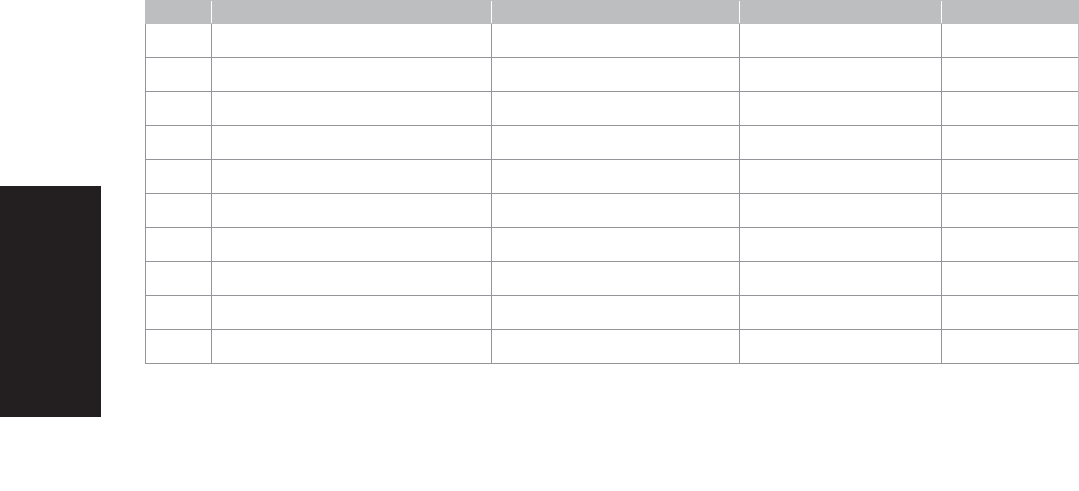
6
Appendices
Grades 3–8 English Language Arts and Mathematics Tests School Administrator’s Manual v202
Appendix D: Deputy and Proctor Certificate
The University of the State of New York
THE STATE EDUCATION DEPARTMENT
Office of State Assessment
Albany, New York 12234
❏
Spring 2021 Grades 3–8 English Language Arts Tests
or
❏
Spring 2021 Grades 3–8 Mathematics Tests
School Name: _________________________________________________________________
We, the undersigned deputies and proctors who assisted in the administration of the 2021 Grades 3–8
English Language Arts and Mathematics Tests, hereby declare our belief in the correctness of the
following:
●
The rules and regulations for administering the tests were fully and faithfully observed, and in
particular:
●
The rules for administering the tests were read to or read by each person who assisted in
administering the tests.
●
The tests were administered within the assigned dates.
●
Secure test materials were kept in the shrink-wrapped packages until the administration dates.
●
The students were given appropriate instructions and orientation before beginning the tests.
●
The students were so seated as to prevent collusion.
●
Adequate supervision was maintained throughout the administration of each test.
●
All test booklets and answer sheets were collected from the students immediately at the close of
the tests for all administrations.
●
Test booklets and answer sheets were collected and returned to the principal for storage in a
secure location after each day of testing.
●
For CBT administration, all used scratch paper, student login tickets, session access codes, and
Proctor PINs were collected and returned to the principal for storage in a secure location after each
day of testing and securely destroyed at the conclusion of testing.
Print Name Signature Test Proctored Test Room
1
2
3
4
5
6
7
8
9
10
(Make additional copies as necessary.)
After completion, retain in school files for one year.
A-6

7
Appendices
Grades 3–8 English Language Arts and Mathematics Tests School Administrator’s Manual v202
__
__
__
Appendix E: Mathematics Tools
Rulers and Protractors
For paper-based testing (PBT), schools must provide the mathematics tools that students will use with the
Grades 3–8 Mathematics Tests. Students may use the same rulers and protractors in the testing room
that they use in daily instruction, provided that the tools do not have pertinent information—such as
mathematics formulas—written on them, and that they meet the specifications provided below.
Rulers will be used with all of the Grades 3–8 Mathematics Tests; protractors will be used only with the
Grades 4–8 Mathematics Tests.
Grades 3–8 Mathematics Tests—Specifications for Rulers:
●
Rulers may be constructed of plastic, wood, metal, cardboard, or other suitable material.
●
Rulers must be no shorter than 6” and no longer than 12”.
●
Rulers must include inch to
1
“ subdivisions.
16
●
Rulers must include centimeters with millimeter subdivisions.
●
Rulers must be calibrated accurately with another ruler that is known to be accurate.
Grades 4–8 Mathematics Tests—Specifications for Protractors:
●
Protractors must be constructed of clear plastic and measure no shorter than 3
15
” in diameter and
16
no longer than 4
3
“ in diameter.
4
●
Protractors must be calibrated accurately with another protractor that is known to beaccurate.
For computer-based testing (CBT), rulers and protractors are available to students in the Nextera
™
Test
Delivery System, as needed for their specific grade-level Mathematics Test.
Calculators
For both PBT and CBT, schools must provide students with hand-held calculators meeting the specifications
listed below. Students testing with CBT will be able to use either the hand-held calculator provided by the
school or the calculator available within the Nextera
™
Test Delivery System.
For those grades and sessions in which a calculator is permitted, when students enter the testing room,
clear, reset, or disable the memory of any calculator with programming capability. If the memory of a
student’s calculator is password-protected and cannot be cleared, the calculator must not be used.
Students may not use calculators that are capable of symbol manipulation or that can communicate with
other calculators through infrared sensors, nor may students use operating manuals, instruction or
formula cards, or other information concerning the operation of calculators during the tests. Graphing
calculators are NOT permitted.
Grades 3–5
Because these tests measure student proficiency involving calculations, the use of a calculator or
mathematics tables is not allowed.
A-7

8
Appendices
Grades 3–8 English Language Arts and Mathematics Tests School Administrator’s Manual v202
Grade 6
Students in Grade 6 are NOT permitted the use of a calculator or mathematics tables for Session 1. For
Session 2, students should have exclusive use of a four-function calculator with a square root key
or a scientific calculator. Graphing calculators are NOT permitted. The use of mathematics tables is
permitted for Session 2 for students in Grade 6 only if specified in the student’s Individualized Education
Program (IEP) or Section 504 Accommodation Plan (504 Plan).
Grades 7–8
Students in Grades 7–8 should have exclusive use of a scientific calculator for both Session 1 and
Session 2. Graphing calculators are NOT permitted. The use of mathematics tables is permitted for
Sessions 1 and 2 for students in Grades 7 and 8 only if specified in the student’s IEP or 504 Plan.
Calculators and CBT
For students testing on computers in Grades 6–8, a calculator is provided as part of the Nextera
™
Test
Delivery System, but schools should continue to supply students with exclusive use of the type of hand-
held calculator the students use for everyday mathematics instruction for those sessions in which a
calculator is permitted.
A-8

9
Appendices
Grades 3–8 English Language Arts and Mathematics Tests School Administrator’s Manual v202
Appendix F: Testing Accommodations for
English Language Learners (ELLs)
English Language Learners
For ELLs, schools may provide the following testing accommodations:
●
Separate Location—Schools are encouraged to provide optimal testing environments and facilities
for all students. They may administer the Grades 3–8 English Language Arts and Mathematics Tests
to ELLs individually or in small groups in a separate location.
●
Translated Editions—ELLs may be provided with a translated edition of the Grades 3–8 Mathematics
Tests. Translated editions will be available for both paper-based testing (PBT) and computer-based
testing (CBT). These tests are available in Chinese (Traditional), Haitian Creole, Korean, Russian,
Spanish, and for PBT only, Arabic, Bengali, and Chinese (Simplified). In addition, ELLs may use an
English and translated edition of the Grades 3–8 Mathematics Tests simultaneously. For PBT,
students should be instructed to record all of their responses in only one of the two editions. The
translated edition used by the student should be indicated on the student’s answersheet. For CBT,
students should be instructed to record all of their responses in the Nextera
™
Test Delivery System.
●
Bilingual Dictionaries and Glossaries—ELLs may use bilingual dictionaries and glossaries when
taking the Grades 3–8 English Language Arts and Mathematics Tests. These bilingual dictionaries
and glossaries may provide only direct translations of words. Bilingual dictionaries or glossaries that
provide definitions or explanations of words, and electronic dictionaries or glossaries with Internet
access, are not permitted. Additional information on bilingual glossaries, as well as testing
accommodations for ELLs, can be found on the Bilingual Education and English as a New Language
website (http://www.nysed.gov/bilingual-ed/english-language-learnermultilingual-learner-
assessment-testing-accommodations).
●
Oral Translation for Lower-Incidence Languages—Schools may provide ELLs with oral translations
of the Grades 3–8 Mathematics Tests when there is no translated written edition provided by the
Department. This accommodation is not permitted for the Grades 3–8 English Language Arts Tests.
All translations of the Grades 3–8 Mathematics Tests must be oral, direct translations of the English
editions when there is no translated edition provided by the Department. Written translations are
not allowed. No clarifications or explanations can be provided. Translators should receive copies of
the English edition of the paper-based tests one hour prior to administration. The Department’s
Office of Bilingual Education and World Languages (518-474-8775) and the Regional Bilingual
Education Resource Networks (RBERNs) can assist schools in locating suitable translators. A list of
RBERNs can be found on the Department’s Office of Bilingual Education and World Languages
website (http://www.nysed.gov/bilingual-ed/schools/regional-supportrberns).
●
Writing Responses in Native Language—ELLs making use of translated editions or of oral
translations of the Grades 3–8 Mathematics Tests may write their responses to the open-ended
questions in their native language. This accommodation is not permitted for the
Grades 3–8 English Language Arts Tests. Scoring the responses to open-ended questions on
the Grades 3–8 Mathematics Tests written in the student’s native language is the responsibility of
the school. However, the Department’s Office of Bilingual Education and World Languages and the
RBERNs can assist schools in locating persons who can translate the students’ responses into
English to facilitate scoring of the tests.
A-9

10
Appendices
Grades 3–8 English Language Arts and Mathematics Tests School Administrator’s Manual v202
For each ELL testing with PBT, darken the circles indicating the testing accommodations provided on the
answer sheet under the heading “ELL Accommodations.” For each ELL testing with CBT, indicate the
testing accommodations provided in the Nextera
™
Administration System (see directions beginning on
page A-59 of Appendix Y: Nextera
™
Administration System for further details).
Former English Language Learners
Schools may provide the testing accommodations listed on the previous page to former ELLs who met
the exiting criteria specified in Part 154-2 of the Regulations of the Commissioner of Education and were
exited from ELL status following their participation in one of the two most recent administrations (Spring
2018 or Spring 2019) of the New York State English as a Second Language Achievement Test (NYSESLAT).
Such students either achieved an overall level of Commanding on the NYSESLAT or achieved an overall
level of Expanding on the most recent administration of the NYSESLAT and scored at Level 3 or higher on
the New York State Grades 3–8 English Language Arts Test.
These accommodations may not be provided to ELLs who were identified as English language proficient
prior to the 2018 NYSESLAT administration. For each eligible former ELL testing with PBT, darken the
circles indicating the testing accommodations provided on the answer sheet under the heading
“ELL Accommodations.” For each eligible former ELL testing with CBT, indicate the testing
accommodations provided in the Nextera
™
Administration System (see directions beginning on page
A-59 of Appendix Y: Nextera
™
Administration System for further details).
A-10

11
Appendices
Grades 3–8 English Language Arts and Mathematics Tests School Administrator’s Manual v202
Appendix G: Testing Accommodations for
Students with Disabilities
Students Who Incur Disabilities Shortly Before Test Administration
Principals may provide certain testing accommodations to students who incur an injury (e.g., broken arm)
or experience the onset of either a short- or long-term disability (either cognitive or physical) within 30
days prior to test administration. Eligibility for such accommodations is based on the principal’s
professional judgment. The principal may confer with Committee on Special Education/Section 504
Accommodation Plan (CSE/504) Multi-Disciplinary Team members, the school physician, or other school
personnel in making such determinations. These accommodations must not significantly change the
constructs/student skills being tested and are limited to the following:
●
Administering the test in a special location,
●
Recording the student’s answers in any manner (see Accommodations Specific to the
Grades 3–8 English Language Arts Tests or Accommodations Specific to the Grades 3–8
Mathematics Tests in Appendix H), and
●
Reading the test to the student. This accommodation is allowed only for students whose vision is
impaired.
Prior permission need not be obtained from the Department for the principal to authorize these testing
accommodations. However, a full written report concerning each authorization must be sent to the Office of
State Assessment (OSA) via fax at 518-474-1989. The report must be on school letterhead, must be signed by
the principal, and must include the following information:
●
The last four digits of the student’s New York State Student Identification System (NYSSIS) ID
number,
●
The title of the test, including the grade,
●
A brief description of the student’s injury or disability, and
●
A list of the accommodations that were authorized by the principal.
If the student is expected to continue to need testing accommodations, the principal must immediately
make the appropriate referral for the consideration of an Individualized Education Program (IEP) or a
Section 504 Accommodation Plan (504 Plan).
Students with IEPs or 504 Plans
In general, students with disabilities must be provided with the testing accommodations specified in their
IEPs or 504 Plans when taking these tests. It is the principal’s responsibility to ensure that students receive
their testing accommodations and that those staff who will be providing them are appropriately trained.
Teachers are advised to become familiar with the accommodations specific to the particular test being
administered. For information on assigning testing accommodations in the Nextera
™
Test Delivery System
for CBT, refer to the section in the manual for the Students tab in Appendix Y: Nextera
™
Administration
System (beginning on page A-53).
A-11

12
Appendices
Grades 3–8 English Language Arts and Mathematics Tests School Administrator’s Manual v202
Large Type or Braille Editions
For students who use large type or braille editions of the tests, large type answer sheets, or have a
testing accommodation allowing the circling of answers in the test booklet rather than marking the
answer sheet, teachers should transcribe the students’ responses onto regular test answer sheets and test
booklets exactly as dictated or recorded. Additional information on scribing may be found on the website
of the Office of Special Education (http://www.p12.nysed.gov/specialed/publications/).
Format Changes
Any format changes to the Grades 3–8 paper-based tests to be made by the school, such as the re-spacing
of questions, enlargement beyond the standard large type edition provided, or colorization, must receive
prior written approval from the Department. Note that the reformatting of State tests may never change
the wording of questions, nor may additional examples be included.
In order for the Department to process requests for reformatting by the school, requests for approval
should be submitted to OSA at least two weeks before the first scheduled date of the test administration.
Requests should be on school letterhead signed by the school principal. Requests may be faxed
to 518-474-1989. Department approvals will be provided by fax. However, regardless of approval, under
no circumstances may the shrink-wrapped packages of paper-based tests be opened prior to the day that
the test is to be administered in the school.
A-12

13
Appendices
Grades 3–8 English Language Arts and Mathematics Tests School Administrator’s Manual v202
Appendix H: Specific Testing Accommodations
Testing Accommodations Categories
Information on the types of testing accommodations are available on the website of the
Office of Special Education
(http://www.p12.nysed.gov/specialed/)
. For information on assigning testing
accommodations in the Nextera
™
Test Delivery System for computer-based testing (CBT), refer to the
section “Students Tab” in Appendix Y of this manual.
Please note that not all accommodations defined in that publication and reproduced here are permitted
on all parts of the Grades 3–8 English Language Arts and Mathematics Tests.
For information on documenting the provision of testing accommodations for students with
disabilities on the Grades 3–8 English Language Arts and Mathematics Tests, see the
Student Information Repository System (SIRS) manual (http://www.p12.nysed.gov/irs/sirs/).
Flexibility in Scheduling:
●
Administer tests with frequent breaks
Flexibility in Setting:
●
Separate location/room—administer test individually
●
Separate location/room—administer test in small group (e.g., three to five students)
●
Provide adaptive or special equipment/furniture (specify type [e.g., study carrel])
●
Special lighting (specify type [e.g., 75-watt incandescent light on desk])
●
Special acoustics (specify manner [e.g., minimal extraneous noises])
●
Location with minimal distraction (specify type [e.g., minimal visual distraction])
●
Preferential seating
Method of Presentation:
Revised Test Format
1
●
Braille editions of tests
●
Large type editions of tests
●
Increased spacing between test questions
●
Increased size of answer blocks/circles
●
Reduced number of test questions per page
●
Multiple-choice questions in vertical format with answer circles to right of responsechoices
●
Reading passages with one complete sentence per line
●
Test read or Text-to-Speech (For CBT, students may choose human reader or online text-to-speech)
1
For State tests, any reproduction and/or reformatting of the printed test booklets by the school requires the advance written permission
of OSA, and, even with such permission, may not occur until the day that the test booklet will be administered.
A-13

14
Appendices
Grades 3–8 English Language Arts and Mathematics Tests School Administrator’s Manual v202
Method of Presentation, continued:
Revised Test Directions
2
●
Directions read to student
●
Directions reread for each page of questions
●
Language in directions simplified
●
Verbs in directions underlined or highlighted
●
Cues (e.g., arrows and stop signs) on answer form
●
Additional examples provided
Use of Aids/Assistive Technology:
● Audio recording/playback device
● Computer (including talking word processor)
● Masks or markers to maintain place
● Papers secured to work area with tape/magnets
● Questions and multiple-choice responses read to student
● Questions and multiple-choice responses signed to student
● Magnification devices (specify type)
● Amplification devices (specify type)
● Amanuensis (scribe)
● Tape recorder
● Word processor
● For CBT: Answer Masking, Background Color, Initial Page Zoom, Reverse Contrast
Method of Response:
●
Marking of answers in booklet rather than on answer sheet
●
Use of additional paper for math calculations
●
Use of scribe
Other:
●
On-task focusing prompts
2
Revision of test directions is an accommodation that is limited to oral or written instructions provided to all students that explain where
and how responses must be recorded, how to proceed in taking the test upon completion of sections, and what steps are required upon
completion of the test. The term “test directions” does not refer to any part of a question or passage that appears solely on a student’s
test booklet or computer screen.
A-14

15
Appendices
Grades 3–8 English Language Arts and Mathematics Tests School Administrator’s Manual v202
Accommodations Specific to the Grades 3–8 English Language Arts Tests
Use of Spell Checking Devices/Software
Students whose Individualized Education Programs (IEPs) or Section 504 Accommodation Plans (504 Plans)
specify the use of spell checking devices or software are permitted to use such devices with both sessions
associated with the Grades 3–8 English Language Arts Tests. Please note that spell check is not available as
part of the CBT platform. Therefore, students who are testing on computer and who have this
accommodation as specified in an IEP or 504 Plan must be provided with a separate device.
Test Read
For the Grades 3–8 English Language Arts Tests, students with disabilities whose IEPs or 504 Plans specify
this accommodation must have tests read to them in accordance with the testing conditions and
implementation recommendations specified in the student’s IEP or 504 Plan. When a test is read to a
student with a disability, the test should be read in its entirety, which includes directions, passages, test
items, questions, and answer choices. The test must be read in a neutral manner, without intonation or
emphasis, and without otherwise drawing attention to key words or phrases. Passages and questions
must be read word for word, without any clarification or explanation. Unless the IEP or 504 Plan indicates
otherwise, passages, parts of passages, questions, and answer choices may be reread to the student
upon the student’s request.
For CBT students, either a human reader or the online text-to-speech accommodation may be used.
Scoring Student Writing
Students may not have requirements for use of correct spelling, grammar, capitalization, and punctuation
of complete sentences waived for any part of the Grades 3–8 English Language Arts Tests.
Note: As indicated above, use of a spell checking device is permissible for those students whose IEPs or
504 Plans so specify.
Use of Scribes
The use of scribes is an allowable accommodation for the paper-based Grades 3–8 English Language Arts
Tests. However, the Department encourages the use of a word processor (with the thesaurus application
disabled) in place of a scribe. Most students have some experience with computers, and word processing
allows the student more control over their environment, fosters independence, and is less labor intensive
than using a scribe. If using a computer or word processor, be sure to delete the student’s work after it
has been printed.
When administering the paper-based Grades 3–8 English Language Arts Tests, scribes must use the
following procedures:
●
When “use of a scribe” is indicated as a testing accommodation on an IEP or 504 Plan, the student
may dictate responses directly to the scribe or into a recording device which may be played back by
a scribe for transcription. If a recording device is recommended to implement this testing
accommodation, this should be indicated accordingly as an implementation specification in the
student’s IEP or 504 Plan.
●
Scribes must record word-for-word what the student dictates or records. Scribes may capitalize the
first letter of each sentence and provide punctuation at the end of a sentence. Scribes must leave out
additional punctuation (e.g., commas or quotation marks) and capitalization of proper nouns unless
directed by the student. Students do not have to spell words aloud while dictating to a scribe.
A-15

16
Appendices
Grades 3–8 English Language Arts and Mathematics Tests School Administrator’s Manual v202
●
A word processor may be used by a scribe to type a student’s dictation, and scribes should write/
type a student’s dictation on every other line.
●
When the student’s dictation is complete, the scribe shows the student the written response and
asks them to indicate where capitalization of proper nouns, additional punctuation, and
paragraphing should be used.
●
The student reads the completed dictation/transcription and indicates if there are any further
changes to be scribed on the skipped lines.
●
For PBT, the scribe must then transfer the student’s completed response into the printed test
booklet exactly as dictated or recorded, and should attach the lined paper with the student’s
dictation to the back of the printed test booklet, preferably by stapling, to ensure against the
student’s response being lost.
●
For CBT, the student’s transcribed response would need to be entered by the scribe into the
corresponding answer boxes in the Nextera
™
Test Delivery System for submission.
Accommodations Specific to the Grades 3–8 Mathematics Tests
Test Read
Testing accommodations in students’ IEPs or 504 Plans that are reading-related—for example, reading
the test to the student—are permitted for the Grades 3–8 Mathematics Tests. Unless the IEP or 504 Plan
specifically disallows it, when a mathematics test question is read to a student who has this
accommodation, all numbers and mathematics symbols, along with words, should be spoken by the
teacher to the student. For example, the symbol < should be read as “less than,” and 1,211 should be
read as “one thousand, two hundred, eleven.” However, test questions may never be modified or
simplified, nor may teachers provide additional examples.
Use of Scribes
The following procedures should be used to implement the testing accommodation, “use of scribe,”
specific to the administration of paper-based Grades 3–8 Mathematics Tests.
●
The scribe must record what the student dictates on a separate sheet of paper.
●
The scribe must ask the student to indicate exactly where the numbers need to be placed and
lined up.
●
The scribe must record the operational sign as dictated by the student (e.g., addition sign,
subtraction sign).
●
When dictating numbers, the student must indicate how the number is written and indicate place
value. For example, if the student says “one thousand thirty-eight,” the student should specify
how that is written (e.g., one, zero, three, eight).
●
When computing a problem, students must indicate to the scribe how they are making the
computation and should be specific in terms of what numbers to write down, including how to
record carrying. For example, when adding 23 and 9, the student should indicate the following:
“9 plus 3 is 12; put down the 2 and carry the 1 above the 2.”
●
The scribe shows the student the written response and asks them to indicate if there are any
further changes to be made.
●
The student does not have to provide spelling, capitalization, and punctuation in word responses.
A-16

17
Appendices
Grades 3–8 English Language Arts and Mathematics Tests School Administrator’s Manual v202
●
For paper-based testing, the scribe must then transfer the student’s completed response into the
printed test booklet exactly as dictated or recorded and should attach the lined paper with the
student’s dictation to the back of the printed test booklet, preferably by stapling, to ensure against
the student’s response being lost.
●
For CBT, the student’s transcribed response would need to be entered by the scribe into the
corresponding answer boxes in the Nextera
™
Test Delivery System for submission.
Use of Manipulative Devices
Students whose IEPs or 504 Plans specify the use of manipulative devices, such as counting blocks,
counters, or an abacus, are permitted to use such devices with both sessions associated with the
Grades 3–8 Mathematics Tests.
Use of Mathematics Spatial Boards with Large Type or Braille Editions
Students whose IEPs or 504 Plans specify the use of mathematics spatial boards are permitted to use
these devices with the large type and braille editions of the Grades 3–8 Mathematics Tests.
Use of Calculators and Mathematics Tables
Grades 3–5
Because these tests measure student proficiency involving calculations, the use of a calculator or mathematics
tables is not allowed.
Grade 6
Students in Grade 6 are NOT permitted the use of a calculator or mathematics tables for Session 1. For
Session 2, students should have exclusive use of a four-function calculator with a square root key
or a scientific calculator. Graphing calculators are NOT permitted. The use of mathematics tables is
permitted in Grade 6 for Session 2 only if specified in the student’s IEP or 504 Plan.
Grades 7–8
Students in Grades 7–8 should have exclusive use of a scientific calculator for both Session 1 and
Session 2. Graphing calculators are NOT permitted. The use of mathematics tables is permitted for
Sessions 1 and 2 for students in Grades 7 and 8 only if specified in the student’s IEP or 504 Plan.
For Grades 6–8, a calculator is provided as part of the Nextera
™
Test Delivery System, but schools should
continue to supply students with exclusive use of the type of hand-held calculator the students use for
everyday mathematics instruction.
A-17

18
Appendices
Grades 3–8 English Language Arts and Mathematics Tests School Administrator’s Manual v202
Appendix I: Information on Ungraded Students
Students who are graded must take the State test for the grade level in which they are enrolled. The
chart below is to be used solely to ascertain the appropriate grade-level test to administer to ungraded
students with disabilities.
Age Ranges for Testing on the New York State Alternate Assessment (NYSAA) and General Tests
for Ungraded Students with Disabilities at the Elementary and Middle Levels in the
2020–2021 School Year
Tests Birth Date
Reaches Age Given Between
September 1, 2020, and
August 31, 2021
Grade 3
English Language Arts,
Mathematics
September 1, 2011–August 31, 2012 9
Grade 4
English Language Arts,
Mathematics
September 1, 2010–August 31, 2011 10
Grade 5
English Language Arts,
Mathematics
September 1, 2009–August 31, 2010 11
Grade 6
English Language Arts,
Mathematics
September 1, 2008–August 31, 2009 12
Grade 7
English Language Arts,
Mathematics
September 1, 2007–August 31, 2008 13
Grade 8
English Language Arts,
Mathematics
September 1, 2006–August 31, 2007 14
A-18

19
Appendices
Grades 3–8 English Language Arts and Mathematics Tests School Administrator’s Manual v202
Appendix J: Paper-Based Testing School/Group List
School/Group List
❏
Grades 3–8 English Language Arts Tests
or
❏
Grades 3–8 Mathematics Tests
School Name:______________________________________________________________
District Name:__________________________ Contact Name:______________________
BEDS Code:____________________________ Phone Number:______________________
Testing Room Number Grade Number Tested Comments
A-19

20
Appendices
Grades 3–8 English Language Arts and Mathematics Tests School Administrator’s Manual v202
Appendix K: Box Labels for Submission
of Paper-Based Testing Booklets to Scoring Center
English Language Arts Test Booklets for Scoring
Send to: _________________________________________________________________________
Scoring Site
From: ___________________________________________________________________________
School Name
BEDS Code: _____________________________________________________________________
BEDS Code Number
English Language Arts Test (Check One)
❏
Gr 3 Session 2s
❏
Gr 6 Session 2s
❏
Gr 4 Session 2s
❏
Gr 7 Session 2s
❏
Gr 5 Session 2s
❏
Gr 8 Session 2s
Box ____________________________ of _______________________
Contains _________________________________ Booklets for Scoring
Quantity
Mathematics Test Booklets for Scoring
Send to: _________________________________________________________________________
Scoring Site
From: ___________________________________________________________________________
School Name
BEDS Code: _____________________________________________________________________
BEDS Code Number
Mathematics Test (Check One)
❏
Gr 3 Session 2s
❏
Gr 6 Session 2s
❏
Gr 4 Session 2s
❏
Gr 7 Session 2s
❏
Gr 5 Session 2s
❏
Gr 8 Session 2s
Box ____________________________ of _______________________
Contains _________________________________ Booklets for Scoring
Quantity
A-20

21
Appendices
Grades 3–8 English Language Arts and Mathematics Tests School Administrator’s Manual v202
Appendix L1: Paper-Based Testing Scoring Site Organization
SCORING OPERATIONS
Scoring Site Coordinator
z
Supervision and management of the site
z
Support for scoring
z
Logistics for operations
z
Security
z
Coordination of site personnel
z
Responsible for collection of audit papers
Operations
Scoring Site Assistants
z
Check in test booklets
z
Prepare test booklets for scoring (organize and randomize)
z
Deliver and collect scored test booklets
z
Quality check answer sheets
z
Return answer sheets to scanning centers
z
Return test booklets to schools
z
Monitor and maintain security
z
Maintain quality control
z
Ship completed materials to schools
Scoring
Scoring Leader
z
Act as a Scoring Trainer
z
Monitor scoring sessions
z
Support Table Facilitators and Scorers
z
Administer Consistency Assurance Sets to Table Facilitators and Scorers
Table Facilitators
z
Monitor scoring progress to ensure scoring of all student responses by the end of the
scoring period
z
Conduct read-behinds
z
Be a resource for rubric clarification
Scorers
z
Score student responses
A-21

22
Appendices
Grades 3–8 English Language Arts and Mathematics Tests School Administrator’s Manual v202
Appendix L2: Computer-Based Testing Scoring
Site Organization
The following table shows the roles for the paper-based testing (PBT) scoring organization as they equate
to computer-based testing (CBT) scoring roles in the ScorePoint application:
PBT Scoring Organization Role CBT Scoring Role in ScorePoint
Scorer = Reader
Table Facilitator = Team Leader
Scoring Leader = Scoring Director
Scoring Site Coordinator = Scoring Director
The responsibilities for each of the CBT scoring roles in ScorePoint:
Reader
z
Score student responses
z
Identify and mark alerts while scoring responses for assigned items
z
Mark responses identified as unable to score
z
Identify and use non-score code when appropriate
Team Leader
z
Distribute Login tickets to Readers
z
Monitor progress of scoring for Readers and items assigned to their scoring group
z
Perform “read-behind” for Readers and items assigned to their scoring group
z
Handle alerts for Readers and items assigned to their scoring group
Scoring Director
z
Train Team Leaders and Readers
z
Implement the policies and procedures for scoring the Grades 3–8 English Language Arts
and Mathematics Tests provided in the Scoring Leader Handbook (http://www.p12.
nysed.gov/assessment/ei/eigen.html)
z
Request NY Logins
z
Setup days and times for scoring
z
Monitor progress of scoring for all Readers and all items assigned to their consortium
z
Monitor “read-behind” for all Readers and all items assigned to their consortium
z
Handle alerts for all Readers and all items assigned to their consortium
z
Generate reports
A-22

23
Appendices
Grades 3–8 English Language Arts and Mathematics Tests School Administrator’s Manual v202
1) I agree not to disclose any secure test materials, including test questions and answers, other than while
participating in the scoring activity described above. In the event that the State Education Department
publicly releases any secure test materials subject to this agreement, including test questions and answers,
the provisions of this agreement shall no longer apply to those materials upon such release.
2) Upon completion of the work described above, I agree to return to the scoring site coordinator all secure
test materials provided to or prepared by me, including all copies thereof and all notes taken or otherwise
prepared by me.
3) I understand that I may not retain any copies of any secure test materials, including scoring materials and
any notes pertaining to their contents.
4) I agree that I will not use or discuss the content of secure test materials, including test questions and
answers, in any classroom or other activities, prior to any public release of any such materials by the State
Education Department as described in paragraph (1) herein.
5) I understand that teachers and administrators who engage in inappropriate conduct with respect to State
assessments may be subject to disciplinary actions in accordance with Sections 3020 and 3020-a of
Education Law and/or to action against their certification pursuant to Part 83 of the Regulations of the
Commissioner of Education. I also understand that §225 of the Education Law makes fraud in exams
amisdemeanor.
Appendix M: Exam Scoring Confidentiality Agreement
The University of the State of New York
Office of State Assessment
THE STATE EDUCATION DEPARTMENT
Albany, New York 12234
EXAM SCORING CONFIDENTIALITY AGREEMENT
❏
Spring 2021 Grades 3–8 English Language Arts Tests
or
❏
Spring 2021 Grades 3–8 Mathematics Tests
Scoring Site __________________________________ Date(s) of Scoring _____________________
The purpose of all New York State assessments is to provide a fair and equitable assessment system that reliably measures
the State learning standards. Because you will have access to secure test materials and to confidential student information,
you also have the responsibility to assist the scoring site in ensuring the security and confidentiality of the test materials,
student responses, and scores. Therefore, by signing this agreement, you agree to abide by the following security restrictions.
Please retain a copy of this confidentiality agreement for your records.
Secure Test Materials
The test materials that you are scoring are “secure test materials” and are subject to certain security restrictions, including
those listed below. “Secure test materials” include, but are not limited to, all student responses, test booklets, answer
sheets, scoring guides, and any other information, whether printed or electronic, relating to the scoring of the open-ended
questions on the 2021 Grades 3–8 English Language Arts and Mathematics Tests. Secure test materials also include any
notes you take during your participation in the scoring of secure test materials and confidential student information.
By signing this agreement, I agree to maintain and honor the security and confidentiality of all secure test materials
to which I am being given temporary access during the scoring activity and to abide by the following security
restrictions:
I, _______________________________________, have read the confidentiality agreement above and agree to abide
by the security restrictions described herein.
Signature: __________________________________________________ Date: _______________________
School (Print): ___________________________________________________________________________
A-23

24
Appendices
Grades 3–8 English Language Arts and Mathematics Tests School Administrator’s Manual v202
Appendix N: Guidelines for Including Special Education
Teachers in Scoring Committees
Note: After review of their teacher certifications and present teaching assignments, school administrators
may choose to include special education teachers with the following titles in the scoring committee.
Special Education Teaching Titles Awarded
Prior to February 2, 2004
Certificate Titles
Awarded Prior to
February 2, 2004
May Score English
Language Arts Tests and/
or Mathematics Tests in
these Grades
Additional
Requirements
Special Education, Nursery,
K–12
3–6
7–8
If highly qualified at the elementary level
If highly qualified in English language arts
and/or mathematics at the middle/secondary
level
Deaf and Hard of Hearing
3–6
7–8
If highly qualified at the elementary level
If highly qualified in English language arts
and/or mathematics at the middle/secondary
level
Blind and
Visually Impaired
3–6
7–8
If highly qualified at the elementary level
If highly qualified in English language arts
and/or mathematics at the middle/secondary
level
Speech and
Language Disabilities
3–6 If highly qualified at the elementary level
A-24

25
Appendices
Grades 3–8 English Language Arts and Mathematics Tests School Administrator’s Manual v202
Special Education Teaching Titles Awarded
On or After February 2, 2004
Certificate Titles Awarded
On or After February 2, 2004
May Score English
Language Arts Tests and/
or Mathematics Tests in
these Grades
Additional
Requirements
Students with Disabilities
Grades 1–6
3–6 —
Students with Disabilities
Grades 5–9—Generalist
5–8 —
Students with Disabilities
Grades 5–9—Content Specialist
5–6
7–8
Grades 7–8 if English language arts and/
or mathematics is the content
specialization on certificate, or if highly
qualified at middle/secondary level in
English language arts and/or
mathematics
Students with Disabilities
Grades 7–12—Content
Specialist
7–8
Only if English language arts and/or
mathematics is the content specialization
on certificate, or if highly qualified at
middle/secondary level in English
language arts and/or mathematics
Deaf and Hard of Hearing
3–6
7–8
Grades 7–8 if highly qualified at middle/
secondary level in English language arts
and/or mathematics
Blind and Visually Impaired
3–6
7–8
Grades 7–8 if highly qualified at middle/
secondary level in English language arts
and/or mathematics
Speech and Language
Disabilities
3–6
If highly qualified at the elementary
level
A-25

26
Appendices
Grades 3–8 English Language Arts and Mathematics Tests School Administrator’s Manual v202
Appendix O: Scoring Operations Certificate
The University of the State of New York
THE STATE EDUCATION DEPARTMENT
Office of State Assessment
Albany, New York 12234
SCORING OPERATIONS CERTIFICATE
❏
Spring 2021 Grades 3–8 English Language Arts Tests
or
❏
Spring 2021 Grades 3–8 Mathematics Tests
School Name:__________________________________________________________________
District/BOCES Name: _____________________________ Test Period _____________________
(Month/Year)
❏
Grade 3 English Language Arts Test
❏
Grade 3 Mathematics Test
❏
Grade 4 English Language Arts Test
❏
Grade 4 Mathematics Test
❏
Grade 5 English Language Arts Test
❏
Grade 5 Mathematics Test
❏
Grade 6 English Language Arts Test
❏
Grade 6 Mathematics Test
❏
Grade 7 English Language Arts Test
❏
Grade 7 Mathematics Test
❏
Grade 8 English Language Arts Test
❏
Grade 8 Mathematics Test
I, the undersigned leader of the scoring operations, do hereby declare that each of the procedures listed
below was fully and faithfully implemented:
1. The scoring committee for each grade level included a minimum of three scorers.
2. Test questions were assigned to scorers according to the criteria described in the School
Administrator’s Manual.
3. Scorers were trained using the procedures and materials described in the Scoring Leader
Handbook.
4. Scorers were not permitted to rate their own students’ responses.
5. Table Facilitators conducted read-behinds.
6. The paper-based answer sheets were subjected to a quality review as described in the School
Administrator’s Manual.
7. The paper-based answer sheets and test booklets were kept secure.
8. The scoring sessions were conducted during the dates specified by the Department.
9. All paper-based answer sheets were checked and accounted for before being submitted to the
scanning center by the date specified.
Name: ____________________________________________________
_
Title: ____________________
Signature: _________________________________________________ Date: ______/______/______
After completion, retain in school files for one year.
A-26

27
Appendices
Grades 3–8 English Language Arts and Mathematics Tests School Administrator’s Manual v202
Appendix P: Rules to Determine Whether a Student Receives
a Valid Score
The following rules will determine whether the student receives a valid score:
●
Students who were present for the administration, including make-ups, of any session of the test
and who responded to at least one question on the test will receive valid scores and be counted as
tested in calculating a school’s participation rate.
●
Students will be considered to have been present for a session unless they are marked as absent
from school for one or both of the test sessions. A student must not be marked absent for a test
session if they were present in the school while the test session was being administered, unless the
student became ill during the test session or earlier that day.
●
Students who were not present during the test administration and make-up periods due to
receiving entirely remote instruction are considered to have no valid test score.
●
Students will be counted as not tested in calculating a school’s participation rate only if one of the
following occurred:
•
The student’s Student Information Repository System (SIRS) record shows the student as
enrolled for the entire test administration period but includes no appropriate test record,
•
The student was absent from school for one or both of the test sessions and the missed
session(s) were not completed during the makeup period,
•
The student was present for one or more test sessions but did not respond to even one
question on the test,
•
The student refused both of the test sessions, or
•
The student’s results were invalidated due to an administrative error.
●
In the case where a student leaves the test administration in the middle of a session and is not able
to make-up that part of the test (see “Illness” on page 32), school officials must decide whether to
mark the student as absent for that session.
•
For paper-based testing, if any circle denoting absent from school for any session is darkened,
or if absent is selected in the Nextera
™
Administration System for any session for computer-
based testing, the student will not receive a valid score.
•
For paper-based testing, if the circle denoting absent is not darkened for any session, or if
absent is not selected in the Nextera
™
Administration System for any session for computer-
based testing, the student will receive a score based on the questions completed. Any missing
constructed responses will receive a condition code of “A,” indicating no response, and the
response will receive a score of zero. The final raw score will be the sum of the number of
multiple-choice questions answered correctly and the scores assigned to constructed-response
questions.
•
If the circle denoting Medically Excused is darkened on the answer sheet, or if Medically
Excused is indicated in the Nextera
™
Administration System, the student will receive no score
and will not be counted in calculating the school’s participation rate.
For additional information on rules to determine a valid score and on reporting scores, please visit the website
for Student Information and Repository System Guidance (http://www.p12.nysed.gov/irs/sirs/home.html).
A-27

28
Appendices
Grades 3–8 English Language Arts and Mathematics Tests School Administrator’s Manual v202
Appendix Q: Regional Information Centers and
Large-CityScanning Centers
Location Primary Contacts Secondary Contacts
Buffalo Public Schools
Office of Shared Accountability
808 City Hall
Buffalo, New York 14202
Answer Sheets & Scanning
Edward Kuzan
716-816-3035
716-851-3044 (fax)
CNYRIC
Central New York
Answer Sheets & Scanning Answer Sheets & Scanning
Regional Information Center
Noelle Hickok Amy Keesey
OCM BOCES
315-433-8327 315-433-8332
6075 East Molloy Rd.
315-433-2221 (fax) 315-433-8368 (fax)
P.O. Box 4866
Syracuse, New York 13221
EduTech / WFL
Answer Sheets & Scanning Answer Sheets & Scanning
Wayne-Finger Lakes BOCES
Kirk Simpson Chris Voit
Eisenhower Building
315-332-7413 315-332-7226
131 Drumlin Ct.
315-332-7370 (fax) 315-332-7370 (fax)
Newark, New York 14513
GST BOCES
Greater Southern Tier Regional
Information Center
Computer Services Center
459 Philo Road
Elmira, New York 14903
Answer Sheets & Scanning
Melissa Zelko Wood
607-795-5342
607-795-5307 (fax)
Answer Sheets
Steve Updike
607-795-5338
607-795-5307 (fax)
Scanning
Shane Swimley
607-795-5338
607-795-5307 (fax)
LHRIC
Lower Hudson Regional Information
Center
Southern Westchester BOCES
450 Mamaroneck Ave.
Harrison, New York 10528
Answer Sheets & Scanning
Testing Services
914-592-4203 x3001
914-345-3719 (fax)
Answer Sheets & Scanning
Todd Moore
914-592-4203 x3279
914-345-3719
MHRIC
Answer Sheets & Scanning Answer Sheets & Scanning
Mid-Hudson Regional Information Center
Testing and Reporting Mariah Adin
Ulster BOCES
845-255-1450 x1220 845-255-1450 x1246
175 Route 32 North
845-255-9104 (fax) 845-255-9104 (fax)
New Paltz, New York 12561
A-28
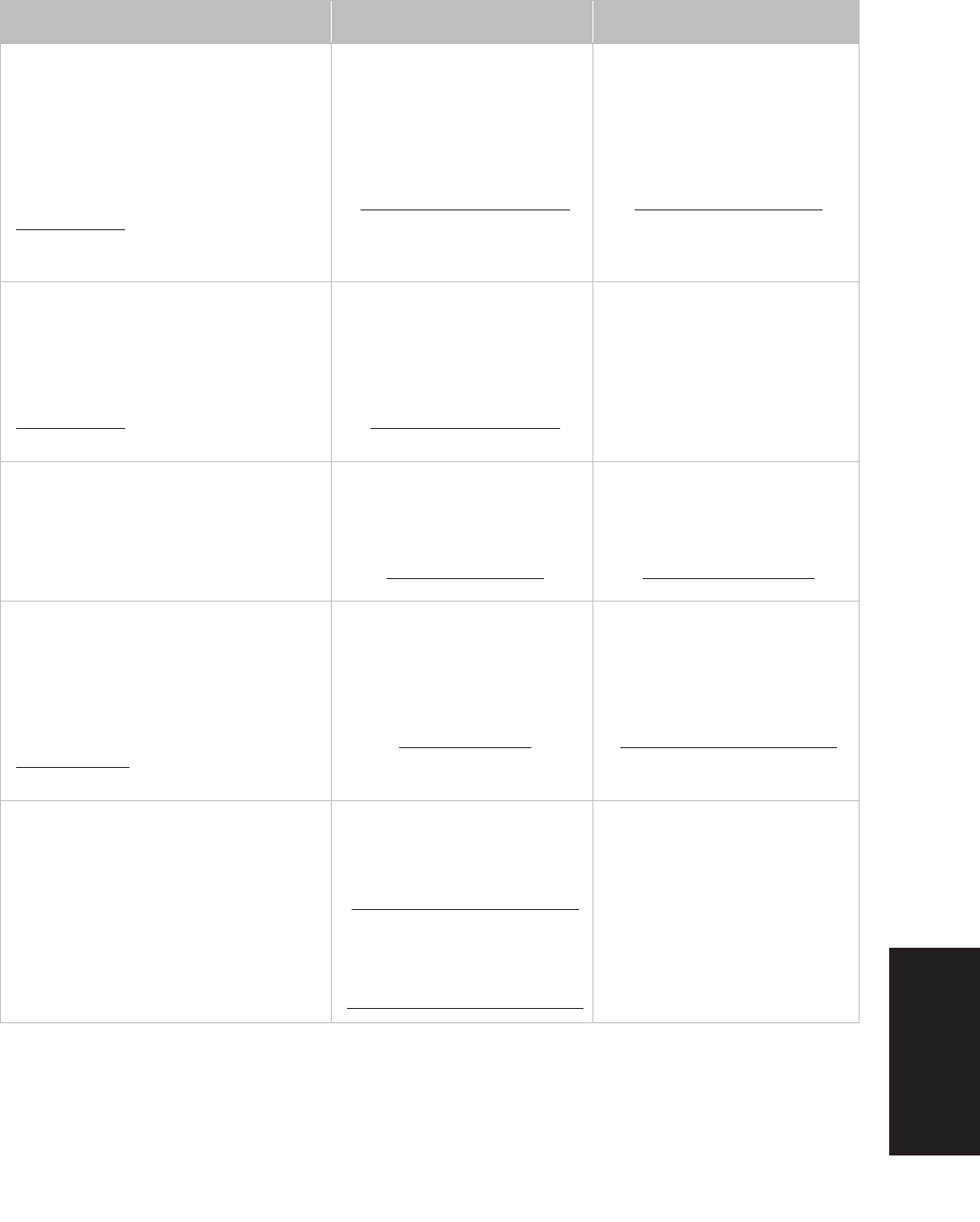
29
Appendices
Grades 3–8 English Language Arts and Mathematics Tests School Administrator’s Manual v202
Scanning Centers (continued)
Location Primary Contacts Secondary Contacts
Monroe RIC
Regional Information Center
BOCES MAARS
(Monroe/Orleans Accountability,
Assessment and Reporting Svcs.)
3625 Buffalo Road
Rochester, New York 14624
Web resources:
(http://www.monroe2boces.org/maars_
home.aspx)
Answer Sheets & Scanning
Mari-Ellen Maloney
585-349-9025
585-349-9090 (fax)
Answer Sheets & Scanning
Patty Zeiner
585-349-9053
585-349-9090 (fax)
MORIC
Mohawk Regional Information Center
Madison Oneida BOCES
4937 Spring Road
Verona, New York 13478
Web resources:
(http://www.moric.org)
Answer Sheets & Scanning
Data Readiness Team
315-361-2700 or
866-986-6742
315-361-5845 (fax)
Nassau BOCES
Regional Information Center
Robert E. Lupinskie Center for
Curriculum, Instruction and Technology
1 Merrick Avenue
Westbury, New York 11590
Answer Sheets & Scanning
Stephanie Witt
516-608-6623
516-608-6616 (fax)
Answer Sheets & Scanning
Fran Werner
516-608-6688
516-608-6616 (fax)
NERIC
Northeastern Regional Information
Center
Testing Operations
900 Watervliet-Shaker Road, Suite 102
Albany, New York 12205
Web resources:
(http://neric.org)
Answer Sheets & Scanning
NERIC Testing Team
518-862-5314
518-862-5396 (fax)
Answer Sheets & Scanning
Anne Marie Bertram
518-862-5333
518-862-5396 (fax)
New York City Department of Education
Office of Assessment Operations and
Scan Center (for Public Schools)
44–36 Vernon Blvd.
Room 207
Long Island City, New York 11101
Answer Sheets & Scanning
Public Schools
NYC DOE Service Center
212-374-6646
Charter Schools
NYC DOE Charter School Office
212-374-5419
A-29

30
Appendices
Grades 3–8 English Language Arts and Mathematics Tests School Administrator’s Manual v202
Scanning Centers (continued)
Location Primary Contacts Secondary Contacts
Rochester City School District
131 West Broad Street
Rochester, New York 14614
Answer Sheets & Scanning
Nancy Eichner
585-262-8328
585-262-8684 (fax)
Answer Sheets & Scanning
Bob Lau
585-262-8556
585-262-8684 (fax)
SCRIC
South Central Regional Information
Center
Broome Tioga BOCES
Mail Drop #31
435 Glenwood Road
Binghamton, New York 13905
Web resources:
(http://www.southcentralric.org/DDC.
aspx)
Answer Sheets & Scanning
Tim Farnham
607-763-3592
607-757-3000 (fax)
Answer Sheets & Scanning
Kathy Mras/Mary Beth Townsend/
Gail Boffi
607-763-3592
607-757-3000 (fax)
Suffolk RIC
Regional Information Center
Eastern Suffolk BOCES
Student Data Services
750 Waverly Ave.
Holtsville, New York 11742
Answer Sheets & Scanning
Lisa Zwerling
631-218-4103
631-240-8967 (fax)
Answer Sheets & Scanning
Karen Barbaro
631-244-4285
631-240-8967 (fax)
Syracuse City School District
Office of Shared Accountability
258 E. Adams Street
Syracuse, New York 13202
Answer Sheets & Scanning
Raymond Stazzone
315-435-6241
315-435-4978 (fax)
Answer Sheets & Scanning
Sheila Davidson
315-435-6440
315-435-4978 (fax)
WNYRIC
Western New York Regional Information
Center
Erie 1 BOCES
355 Harlem Road
West Seneca, New York 14224
Answer Sheets & Scanning
Karen Halbert
716-821-7173
716-821-7432 (fax)
Answer Sheets & Scanning
Margaret Maloney
716-821-7466
716-821-7432 (fax)
Yonkers City School District
1 Larkin Center
Yonkers, New York 10701
Answer Sheets & Scanning
Rachel Cole
914-376-8234
914-376-9144 (fax)
Answer Sheets & Scanning
David Beaver /Jim Anderson
914-376-8234
914-376-9144 (fax)
A-30

31
Appendices
Grades 3–8 English Language Arts and Mathematics Tests School Administrator’s Manual v202
Appendix R: New York City Department of Education
2020–21 Borough Assessment Implementation Directors
Borough Assessment Office
Borough Assessment
Implementation Director
Manhattan
Comprising Districts:
1, 2, 3, 4, 5 & 6
333 Seventh Avenue
7th Floor
New York, New York 10011
Louise Smith
718-349-5613 (Monday–Thursday)
212-356-3784 (Friday)
212-356-7523 (fax)
Bronx
Comprising Districts:
7, 8, 9, 10, 11 & 12
1 Fordham Plaza
Room 749
Bronx, New York 10458
Yuk Fung (Jane) Lam
718-741-5559 (Friday)
718-349-5664 (Monday–Thursday)
718-741-7971 (fax)
Brooklyn
Comprising Districts:
13, 14, 15, 16, 19, 23 & 32
131 Livingston Street
Room 310C
Brooklyn, New York 11201
Laura Dalla Betta
718-349-5551 (Monday–Thursday)
718-935-5795 (Friday)
718-935-2104 (fax)
Queens
Comprising Districts:
24, 25, 26, 27, 28, 29 & 30
28-11 Queens Plaza North
Room 304
Long Island City, New York 10001
Barbara Marcisak
718-391-8352
718-391-6088 (fax)
Staten Island
Comprising Districts:
17, 18, 20, 21, 22 & 31
715 Ocean Terrace
Building A
Staten Island, New York 10301
José Garcia
718-390-1579
718-420-5665 (fax)
A-31

32
Appendices
Grades 3–8 English Language Arts and Mathematics Tests School Administrator’s Manual v202
New York City Department of Education (continued)
Borough Assessment Office
Borough Assessment
Implementation Director
Special Education
D75
400 First Avenue
Room 662C
New York, New York 10010
Danny Gong
212-802-1532
718-706-4587 (fax)
Alternate Schools & Programs
D79
4360 Broadway
Room 428
New York, New York 10033
Joanne Mitchell
917-521-3635
917-521-3649 (fax)
Charter Schools
100 Gold Street
New York, New York 10038
J. Greyston Holmes
212-374-6793
212-374-2324 (fax)
Homebound Instruction
3450 East Tremont Avenue
Bronx, New York 10033
Angela Velez
718-794-7236
718-794-7237 (fax)
Hospital Instruction
3450 East Tremont Avenue
Bronx, New York 10033
Keri Kaufmann
718-794-7266
718-794-7263 (fax)
A-32
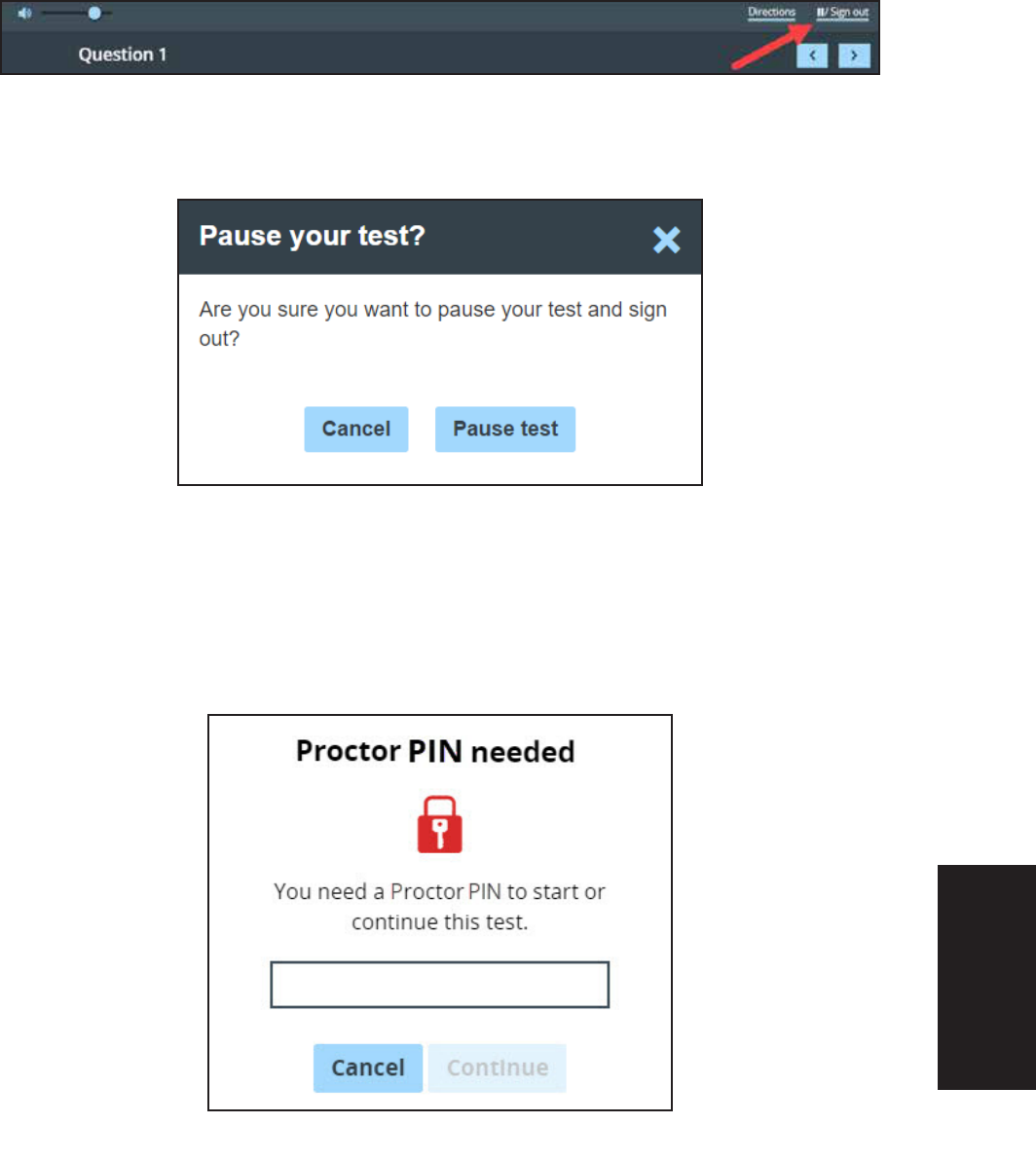
33
Appendices
Grades 3–8 English Language Arts and Mathematics Tests School Administrator’s Manual v202
Appendix S: Pausing and Reactivating a Computer-Based
Test in Nextera
™
Test Delivery System
A student may pause a test by selecting ll/Sign out in the upper right corner of the student’s screen in
the Nextera
™
Test Delivery System.
The student then selects Pause test to exit the test session and save current progress until the student
can return to the test session. If the student selects Cancel, the student will immediately return to the
test session without pausing the test.
Any test that is paused will require a Proctor PIN for the student(s) to log back into the test. Proctors will
need to contact their school administrator to obtain the Proctor PIN prior to administering the test. The
Proctor PIN will be the same for all students testing on computer within a school, but each school will
have a unique Proctor PIN. Please Note: Being mindful of the health and safety protocols established at
schools in response to COVID-19, for the Spring 2021 administration, schools have the option of having
students enter the Proctor PIN themselves. If a school chooses this option, the Proctor PIN should be reset
after each test session.
A-33

34
Appendices
Grades 3–8 English Language Arts and Mathematics Tests School Administrator’s Manual v202
Appendix T: Nextera
™
Test Delivery System
Computer-Based Testing Accommodations
Student testing accommodations must be set for both English Language Arts and Mathematics computer-
based testing (CBT) administrations. Testing coordinators can set testing accommodations on the
individual student level, from the Classes page, or from the Multi-Student Edit page. The Nextera
™
Test
Delivery System includes the following online testing accommodations and classroom accommodations:
●
Answer Masking Tool
●
Reverse Contrast
●
Initial Page Zoom
●
Text-to-Speech (online only)
●
Background Color
●
Read Aloud (by human)
Students with learning needs as documented in an Individualized Education Program (IEP) or Section 504
Accommodation Plan (504 Plan) may require online accommodation tools. Refer to the following
information concerning online testing accommodations when considering the accommodations your
student(s) may need. These options need to be identified and coded in the Nextera
™
Administration
System prior to testing.
After setting all student testing accommodations in Nextera
™
Admin, the testing coordinators should
review reports from the Students tab for Classes in Nextera
™
Admin. It is extremely important that student
testing accommodations are set before a student logs into a CBT session. It is recommended that you add
this verification step to review student testing accommodations at least 1–2 days before CBT begins in
your school. If online testing accommodations are not set for the student before the student accesses
A-34
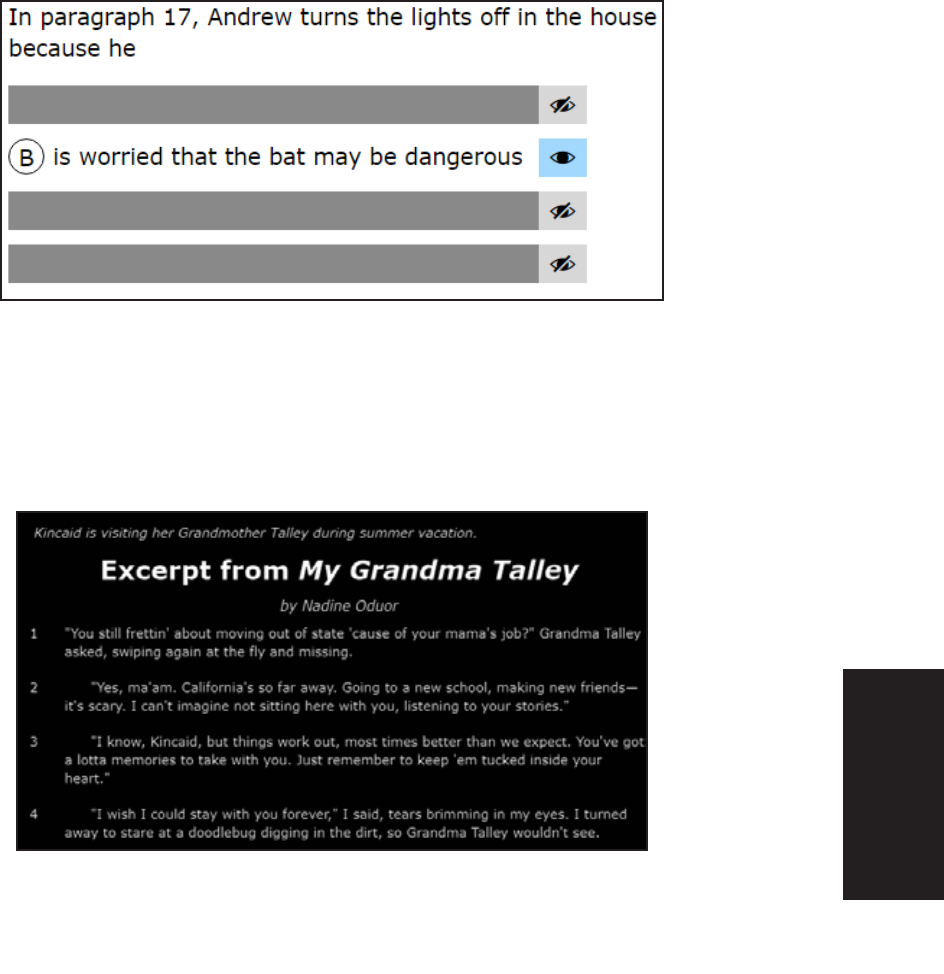
35
Appendices
Grades 3–8 English Language Arts and Mathematics Tests School Administrator’s Manual v202
the computer-based test, the student will have to have their online test reset by calling Questar customer
support at 866-997-0695.
Answer Masking
Answer masking is an embedded accommodation that allows for the responses to be shaded so the
responses do not distract the focus of the student from the question.
In order to reveal or hide a response option, the student clicks on the gray, crossed-out eye, or blue eye
next to that option.
●
The blue eye indicates response options that have been selected to view.
●
The gray, crossed-out eyes indicate which response options are masked.
●
Examples:
Reverse Contrast
Reverse contrast is an embedded accommodation that changes the color of the text and the background
for students that have an easier time reading white text on a black background. If this option is selected,
the test will automatically appear in the selected mode and the student does not have to take any action.
Example:
A-35

36
Appendices
Grades 3–8 English Language Arts and Mathematics Tests School Administrator’s Manual v202
Initial Page Zoom
The initial page zoom is an embedded accommodation that enlarges the text and images on the screen
so the student can view or read the text more easily. Once set in Nextera
™
Admin, the initial page zoom
remains as is throughout the test unless the student chooses to change it.
Example:
Text-to-Speech (online only)
Text-to-Speech (TTS) is an accommodation that indicates that the student will take the test online, but
that all or part of the test will be read aloud by the computer. See the Teacher’s Directions for Computer-
Based Testing for additional information regarding the TTS accommodation.
Note: If TTS is not set as an accommodation for the student before the student accesses the computer-
based test, the student will have to have their online test reset. This will cause a delay to the student’s
ability to test that day. Please double-check all testing accommodations by reviewing the student’s
downloadable report from the Classes page.
Background Color
The background color option is an embedded accommodation that allows the color of the background to
be changed as needed in order to make the text easier for the student to read. There are multiple color
options available.
A-36
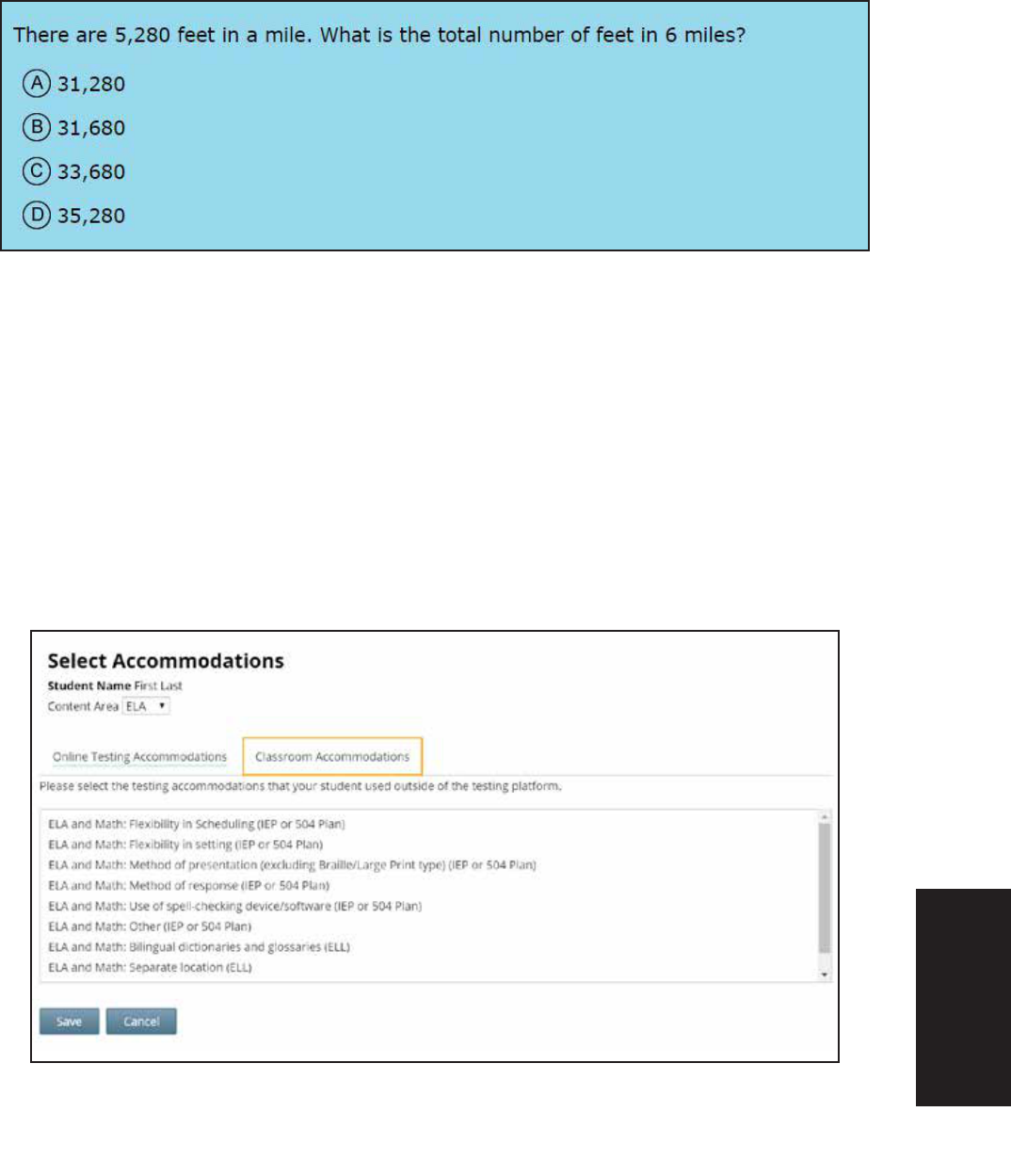
37
Appendices
Grades 3–8 English Language Arts and Mathematics Tests School Administrator’s Manual v202
If this option is selected, the test will automatically appear in the selected mode and the student does not
have to take any action.
Example:
Read Aloud (by human)
Read Aloud (by human) is an accommodation that indicates the student will take the test online, but that
all or part of the test will be read aloud by a human reader. Setting this accommodation for the student
in Nextera
™
Admin ensures that the student and human reader are using the same test form, Form A, so
that all test questions match between the computer-based test and the paper-based test being read to
the student. Students with disabilities whose IEP or 504 Plan recommend this accommodation must have
tests read to them in accordance with the testing conditions and implementation recommendations
specified in the student’s IEP or 504 Plan.
Classroom Accommodations
The below image shows a list of the classroom accommodations that can be selected in Nextera
™
Admin
that students may use outside of the testing platform.
A-37

38
Appendices
Grades 3–8 English Language Arts and Mathematics Tests School Administrator’s Manual v202
Appendix U: Roles, Responsibilities, and Permissions in
Nextera
™
Administration System
for Computer-Based Testing
This section describes the roles, responsibilities, and permissions of the various user roles in Nextera
™
Administration System for computer-based testing (CBT).
●
Regional Information Coordinator (RIC)
•
Point of contact for all District Test Coordinators in their region
•
Can create district- and school-level users in their region
•
Has access to all district- and school-level information in their region
●
District Test Coordinator (DTC)
•
Main point of contact at the district for Questar
•
Ensures accuracy of all student data in the system
•
Manages district-level accounts and sets up primary school-level users, including the School
Test Coordinator and School Information Technology Coordinator
•
There is only one District Test Coordinator per district
•
Can verify CBT Technology Readiness in Nextera
™
Admin
●
District Information Technology Coordinator (DITC)
•
Information technology point of contact for all schools in the district
•
May help district and school staff troubleshoot technology issues
•
Cannot create new users
•
Can verify CBT Technology Readiness in Nextera
™
Admin
●
District Level User (DLU)
•
Receives the same permissions in the system as the District Test Coordinator
•
Has access to all district schools, users, and students
•
Can assist in managing district-level users and students, and in scheduling tests
•
Can create users with DITC role and school-level users
●
Superintendent (SUP)
•
Provides guidance to the District Test Coordinator
•
Ensures all student data is correct and in the system
•
Has access to their own district- and school-level information
•
Can assist in managing district-level users and students, and in scheduling tests
•
Can view student constructed responses for their schools
•
There is only one SUP per district
A-38

39
Appendices
Grades 3–8 English Language Arts and Mathematics Tests School Administrator’s Manual v202
●
Principal (PRN)
•
Has access to their own school-level information
•
One principal role per school
•
Can verify CBT Technology Readiness in Nextera
™
Admin
●
School Test Coordinator (STC)
•
Handles test coordinator responsibilities at the school level
•
Responsible for managing users and students, and schedules tests at the school level
•
There is only one School Test Coordinator per school
•
Can verify CBT Technology Readiness in Nextera
™
Admin
●
Building Level User (BLU)
•
Receives the same permissions in the system as the School Test Coordinator
•
Can assist in managing school-level users and students, and in scheduling tests
•
Can create SITC and Teacher users
•
Can verify CBT Technology Readiness in Nextera
™
Admin
●
School Information Technology Coordinator (SITC)
•
Information technology point of contact for the school
•
Can download the secure test browser on all devices used for testing
•
May help district and school staff troubleshoot technology issues
•
Cannot create users
•
Can verify CBT Technology Readiness Checklist in Nextera
™
Admin
●
Teacher (TA)
•
Responsible for leading test administration
•
There is only one teacher per class
•
Visibility to their class-level information
•
Cannot create users
•
Confirms the students are present
•
Reads the directions from the Teacher’s Directions and leads students
A-39

40
Appendices
Grades 3–8 English Language Arts and Mathematics Tests School Administrator’s Manual v202
Nextera
™
User Roles By Functionality
Note: The functionalities differ based on role. For example, a school user does not have access to all
district information. A school user, with appropriate access, can edit student information within their
own school but not for a student who is enrolled in another school within the district. A district user,
with appropriate access, can edit any student’s information.
Page Functionality DTC DLU SUP PRN DITC STC RIC BLU SITC Teacher
Home
View Home Page, Quick
Links
X X X X X X X X X X
Search for District/School
X X X X X
Dashboard Metrics
X X X X X X X X X
Students
View/Edit Students Page
(Teachers cannot edit)
X X X X X X X X
Option drop-down
(accommodations
information)
X X X X X X X
Download class list in CSV
(Excel)
X X X X X X X
Classes
View/Edit Classes and
Create New Classes
X X X X X X X X
Tests
View Test Pages and
Important Dates
X X X X X X X X X X
View Test Administrations
and Test Details
X X X X X X X X X X
Print Student Logins
X X X X X X X
Set Status Code for each
Test (Do Not Score,
Invalidate)
X X X X X X
Accounts
View Accounts, Activate
and Reset Accounts
X X X X X X X
Add New Test
Administrators
X X X X X
View/Edit Contact
Information, Addresses,
School Registration
Information
X X X
Merge Accounts
X X X
Help
View Customer Service
Telephone Number,
E-mail, Chat, FAQ,
Support Documentation
X X X X X X X X X X
View Downloads Page,
Download Secure
Browsers
X X X X X X X X X
View System Scan Results
Page
X X X X X X X X X
A-40

41
Appendices
Grades 3–8 English Language Arts and Mathematics Tests School Administrator’s Manual v202
Appendix V: District and School Test Coordinator Checklist
for Computer-Based Testing
Activities PRIOR to and DURING Test Administration
❏
Announce testing in advance.
❏
Familiarize yourself with all test materials, including this manual and the Teacher’s Directions for
Computer-Based Testing.
❏
Complete appropriate steps necessary in the Nextera
™
Administration System to prepare for
testing. Examples include adding or updating teacher and student details, creating classes, etc.
❏
Provide copies of the Teacher’s Directions for Computer-Based Testing prior to the first day of
testing to all teachers who will be administering the tests. Teacher’s Directions are not secure and
may be distributed.
❏
Brief all teachers on their responsibilities and roles in testing and remind teachers about
preparation of the testing room and supplies for testing.
❏
Work with your School or District IT Coordinator to verify devices are ready for each student to
complete the test.
❏
Ensure that test read copies are available for students receiving the Read Aloud (by human)
accommodation.
❏
Ensure that English Language Learners and eligible former ELLs are provided with the testing
accommodations that the principal has determined will be provided for them.
❏
Communicate with Technology Coordinator(s) and School Test Coordinator(s) regarding
technology, planning, and scheduling.
❏
Review all materials available on the Nextera
™
Administration System Help page.
❏
Aid in the coordination of and/or facilitate administration training for district and school staff if
necessary (content, dates, etc.).
❏
Have all participating schools review the Setup and Installation Guide and perform the Testing
Readiness Check (http://www.questarai.com/readiness/test-readiness/) to determine if all
technology requirements have been met.
❏
Ensure tasks are completed for uploading Pre-ID files.
❏
Ensure tasks are completed for those students that require online accommodations.
❏
Make sure that schools know where (Questar Customer Support, technology staff, district staff)
and how to get assistance for any issues that might come up.
❏
Prior to administering the test, be prepared to share the Proctor PIN (available on the Nextera
™
Administration System Home page) with proctors for students who have paused testing.
A-41

42
Appendices
Grades 3–8 English Language Arts and Mathematics Tests School Administrator’s Manual v202
Appendix W: Suggestions for Creating a Secure
Computer-Based Testing Environment
The following physical and visual barriers between testing devices can also be used as security measures
for computer-based testing.
●
Card stock (e.g., manila folders) that can be taped to the sides of monitors
●
Flattened cardboard boxes that can be cut, folded, and taped to form a visual barrier between
testing devices
●
Cardboard carrels
●
Privacy screens that narrow the viewing angle of a computer monitor so that it is visible only to
someone sitting in front of it. Schools that have privacy screens available should affix them to
monitors prior to the beginning of testing and ensure that students are seated so that they cannot
view the monitor of the student seated in the row in front of them.
A-42
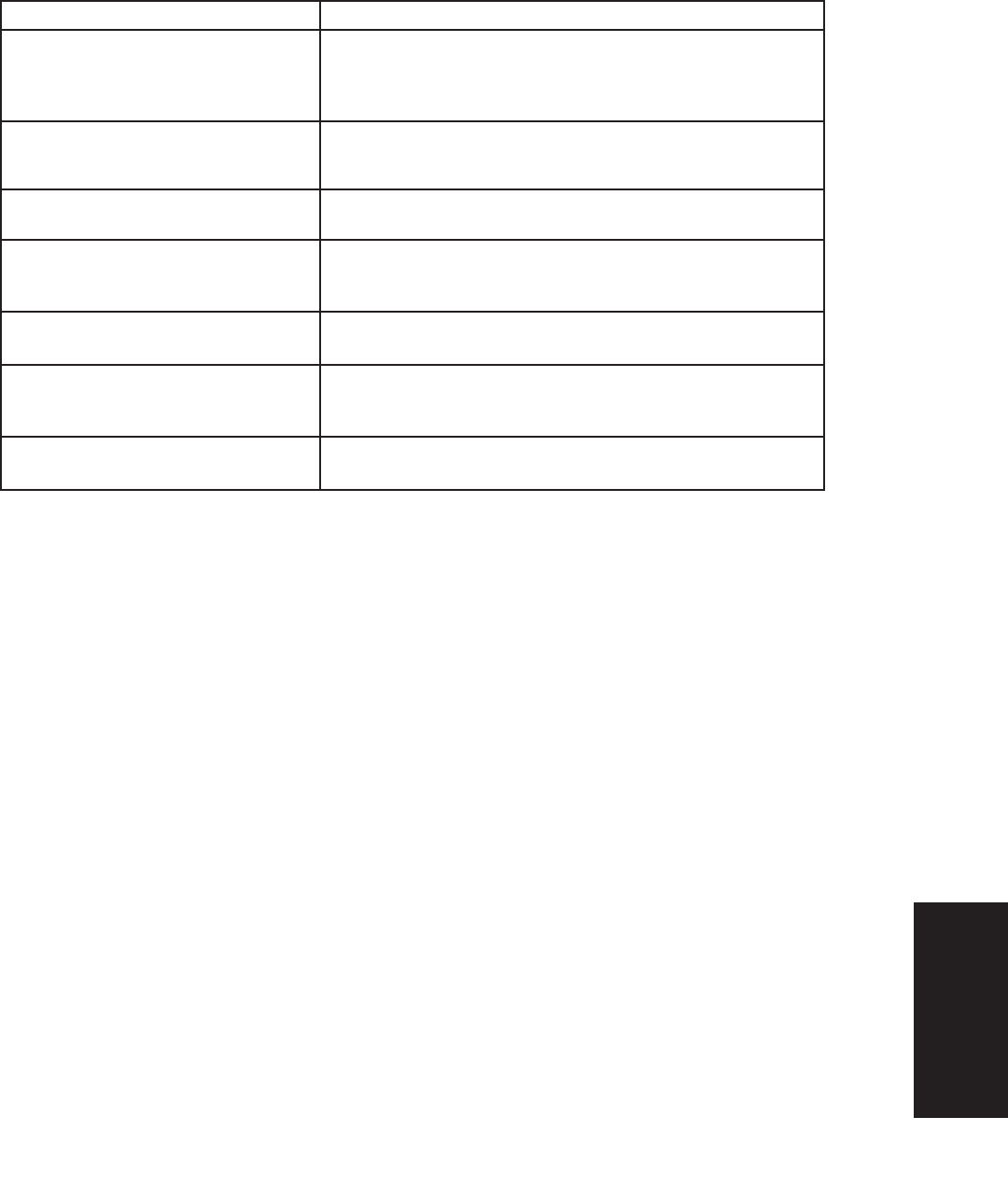
43
Appendices
Grades 3–8 English Language Arts and Mathematics Tests School Administrator’s Manual v202
Appendix X: Glossary of Computer-Based
TestingTerminology
Term Definition
Nextera
™
Administration System
System used by teachers, school, and district representatives
to verify student registration, assign accessibility/
accommodation features, print student login tickets, and
other administrative duties
Nextera
™
Test Delivery System
System that delivers tests to students and receives responses.
Nextera
™
Test Delivery System is delivered through the secure
browser.
Secure Browser
Downloadable application that protects the security of the
test and student responses
Session Access Code
Four-digit code announced or displayed for all students in a
session once the teacher has ensured all students have
successfully logged in and are ready to begin testing
Proctor PIN Password to reactivate a paused student test
Student Login Tickets (Student Labels)
Login tickets students use to initiate a test session in the
Nextera
™
Test Delivery System. These include the New York
State Student Identification System (NYSSIS) ID and password.
Test Administrator/Proctor
Individual(s) at the school ultimately responsible for
administering the assessment
A-43

44
Appendices
Grades 3–8 English Language Arts and Mathematics Tests School Administrator’s Manual v202
Appendix Y: Nextera
™
Administration System
Overview
This section provides guidance for administering computer-based tests (CBT) using the Nextera
™
Administration System, commonly called “Nextera
™
Admin,” including the login process, navigation, and
management of class and student data. In New York State, students are loaded into Nextera
™
Admin
from the Level 2 Data Warehouse before each CBT administration. Students are loaded by grade-level
enrollment. Schools are responsible for ensuring that all students are available in Nextera
™
Admin for CBT
and that all needed student-testing accommodations are set for students. Any students in a CBT grade
level that are testing on paper or not testing for allowable reasons must be marked with a Not Testing
code.
You will find information on all CBT administrative activities for Nextera
™
Admin in this appendix.
Contact Questar Customer Support if you need additional help at 866-997-0695 or e-mail
(ny[email protected]).
1. Home Page
The Home page has general information that districts and schools need for
testing, such as important updates and the school’s Proctor PIN, based on role.
2. Students
The Students tab allows users to view students in the Nextera
™
Administration
System. Some roles can make changes (e.g., updating online testing
accommodations), download class lists, and add students.
3. Classes The Classes tab allows users to view, edit, and create classes.
4. Tests
Based on the user’s role, the Tests tab allows users to view important dates and
test administration details, print student login tickets as labels or tickets,
designate students not taking the test, and track student progress while taking
the test.
5. Accounts
The Accounts tab allows some roles to view, activate, and add test
administrators, such as Teachers. DTCs can also edit contact information
and addresses.
6. Student Responses
The Students Responses tab provides access to the previous spring’s constructed-
responses. DTCs and Principals have access to download the PDFs.
7. Help
The Help tab offers resources for support, such as customer support contact
details, FAQ, and support documentation.
A-44

45
Appendices
Grades 3–8 English Language Arts and Mathematics Tests School Administrator’s Manual v202
Sign In/Sign Out
If you have been provided with Nextera
™
login tickets, you can enter the following website address in
your browser address bar to access Nextera
™
Admin (https://ny.nextera.questarai.com/Admin/). If you
have not been provided with login tickets to Nextera
™
Admin, you should contact your District Test
Coordinator (DTC), School Test Coordinator (STC), or your local Regional Information Center (RIC) testing
department.
Sign In
1. Enter your User ID and Password, then select Sign In. If you need to reset your password,
please find password reset instructions on page A-96. You can also contact your testing
coordinator to have login tickets resent to you.
2. If you are signing in for the first time, you will be prompted to reset your password upon first
login.
3. You will receive a message that your password has expired. This step allows you to create your
own password. Enter a new password in the New Password and Retype Password fields and
select Submit.
A-45
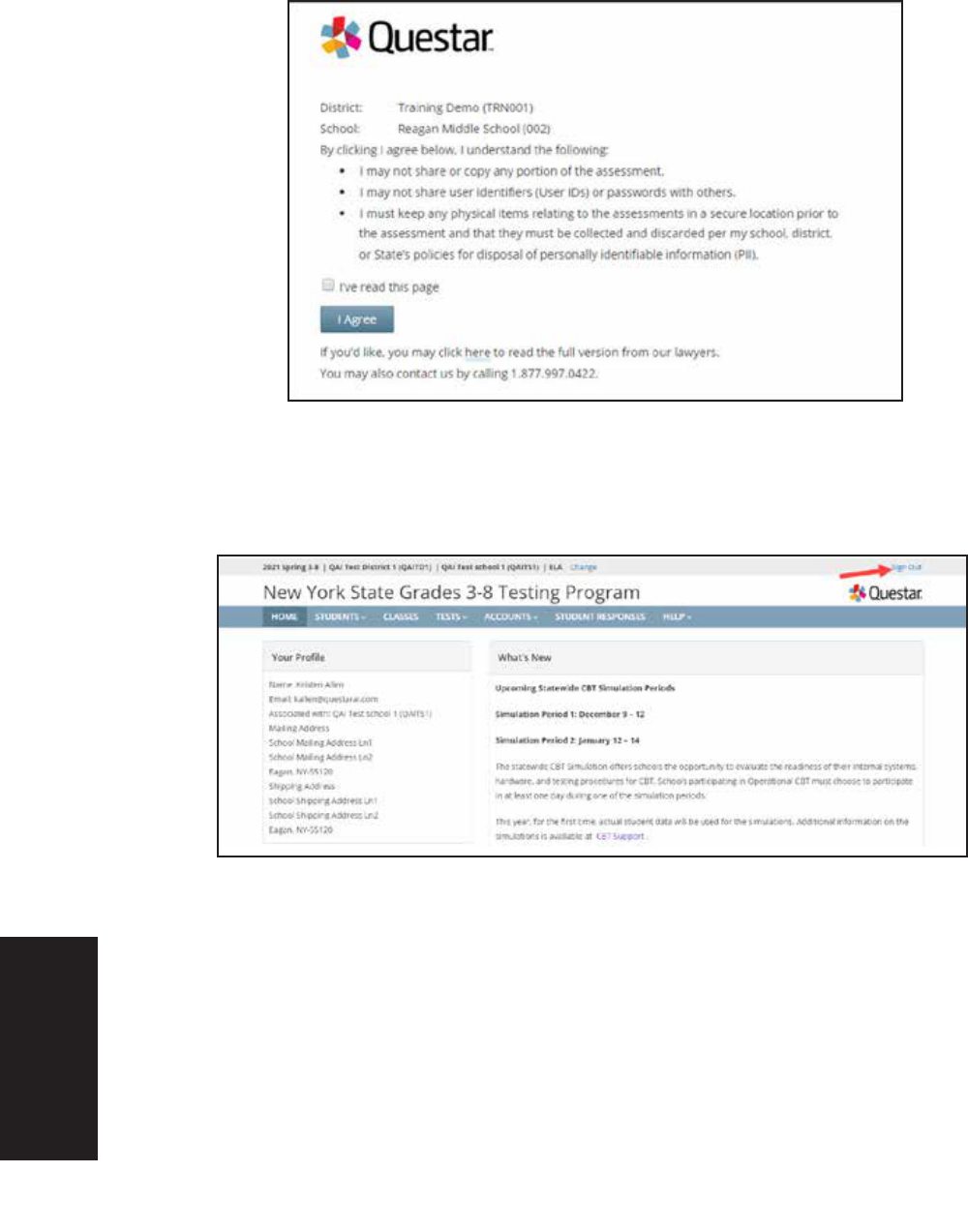
46
Appendices
Grades 3–8 English Language Arts and Mathematics Tests School Administrator’s Manual v202
4. For initial logins and for all password changes, you will be asked to acknowledge and agree to the
Security Compliance statement. After reviewing the statement, select the check box for “I’ve
read this page” and select I Agree.
Sign Out
To Sign Out of the Nextera
™
Administration System, select Sign Out from the upper right corner of the
screen. You will be logged out of Nextera
™
Admin immediately.
A-46

47
Appendices
Grades 3–8 English Language Arts and Mathematics Tests School Administrator’s Manual v202
Home Tab
Information available on the Home page is based on role. Please reference Appendix U to determine
which roles have access to the different information and functionality.
Depending on user role, information available on the Home page may include:
●
Administration Quick Links
●
DTC Important Information
●
STC Checklist
●
Teacher Checklist
●
What’s New
●
School Information, including the Proctor PIN, which is required when a student needs to
reactivate a paused test
A-47

48
Appendices
Grades 3–8 English Language Arts and Mathematics Tests School Administrator’s Manual v202
Since certain roles have access to multiple schools’ details, it is important to ensure they are looking at the
applicable school’s page when searching for data, such as the Proctor PIN, which is necessary when a student
needs to reactivate a paused test. See Appendix S: Pausing and Reactivating a Computer-Based Test in
Nextera
™
Test Delivery System for more details.
When viewing the Nextera
™
Administration System, DTCs should verify they are viewing information for the
appropriate school by looking in the “Schools” field on the Home page.
A-48

49
Appendices
Grades 3–8 English Language Arts and Mathematics Tests School Administrator’s Manual v202
If it is not the desired school:
1. Select Change in the header.
2. Use the “School” drop-down menu to select the correct school and select Change.
A-49

50
Appendices
Grades 3–8 English Language Arts and Mathematics Tests School Administrator’s Manual v202
3. The applicable school’s page displays.
A-50
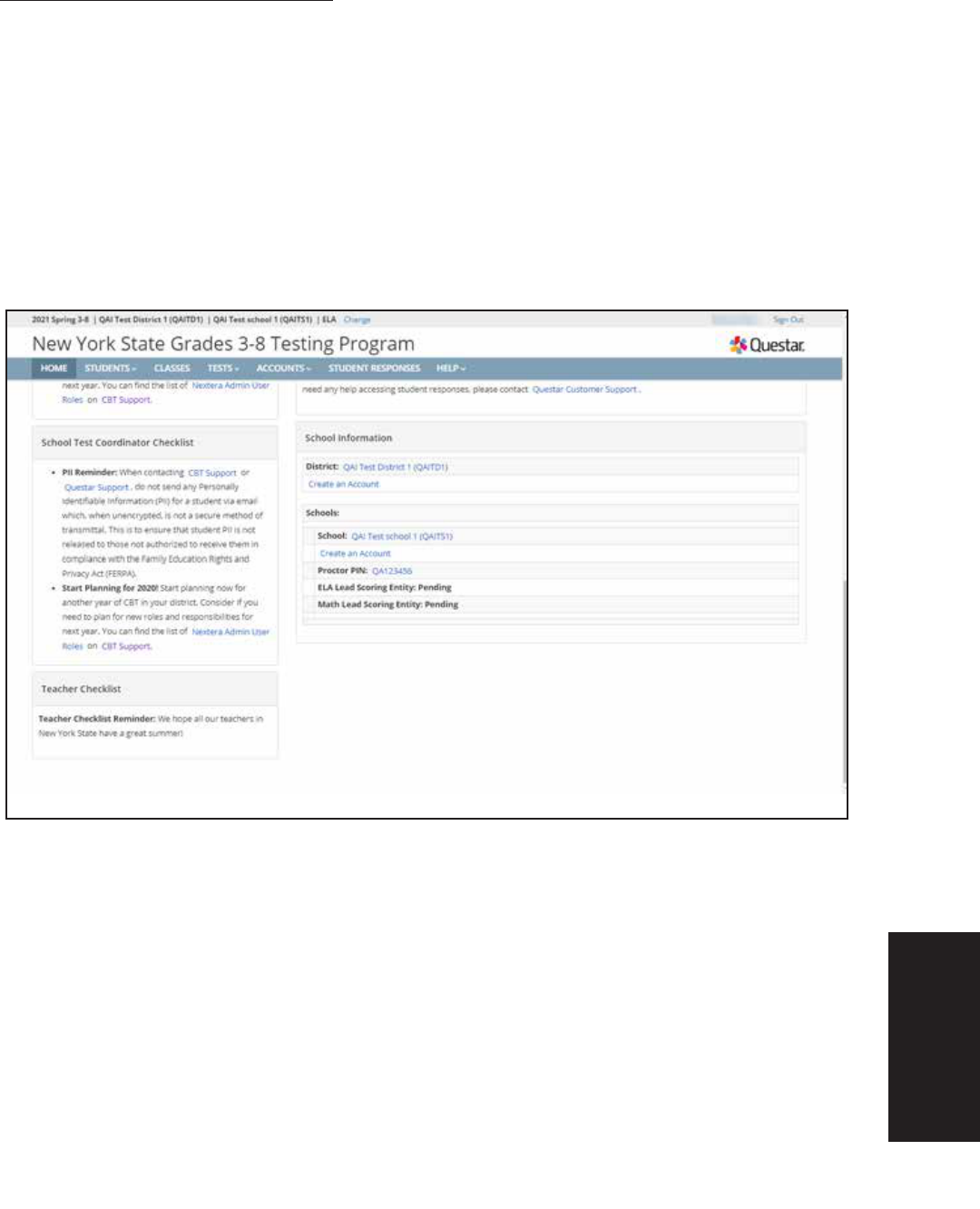
51
Appendices
Grades 3–8 English Language Arts and Mathematics Tests School Administrator’s Manual v202
School Test Coordinator
The School Test Coordinator’s (STC) Home page includes
●
Your Profile
●
Administration Quick Links
●
STC Checklist
●
Teacher Checklist
●
What’s New
●
School Information, including the Proctor PIN, which is required when a student needs to reactivate a
paused test, and the school’s CBT Lead Scoring Entities for English Language Arts and Mathematics
A-51

52
Appendices
Grades 3–8 English Language Arts and Mathematics Tests School Administrator’s Manual v202
Teacher
The Teacher’s Home page includes
●
Your Profile
●
Administration Quick Links
●
Teacher Checklist
●
What’s New
A-52

53
Appendices
Grades 3–8 English Language Arts and Mathematics Tests School Administrator’s Manual v202
Students Tab
Based on the user’s role, the Students tab allows users to view, make changes, and add students in the
Nextera
™
Admin system. STCs, DTCs, and Teachers can make changes (e.g., setting Not Tested codes)
and add students in the Nextera
™
Administration System. To access all students, users must verify they are
viewing information for the appropriate school.
To View Students
1. Select Students from the STUDENTS tab. The list of all students displays. The students appear in a
list with New York State Student Identification System (NYSSIS) ID, first and last name, class
assignment, and grade.
•
Click the up/down arrows in the column headings to sort users.
•
Click View to view student details and make changes, such as adding student testing
accommodations, if permissions allow.
•
Use the “Show Students” drop-down list on the upper left to tailor your view of students by
assigned to any class, finished all testing, not assigned to any class, testing, and assigned not
testing code.
2. To download the list of students, select the Student Download (Excel) link in the lower right
corner of the screen.
•
The downloaded list of students will show all student testing accommodations that have been
set for each student. Students are listed on a separate line in the report for every testing
accommodation that has been set for the student.
A-53
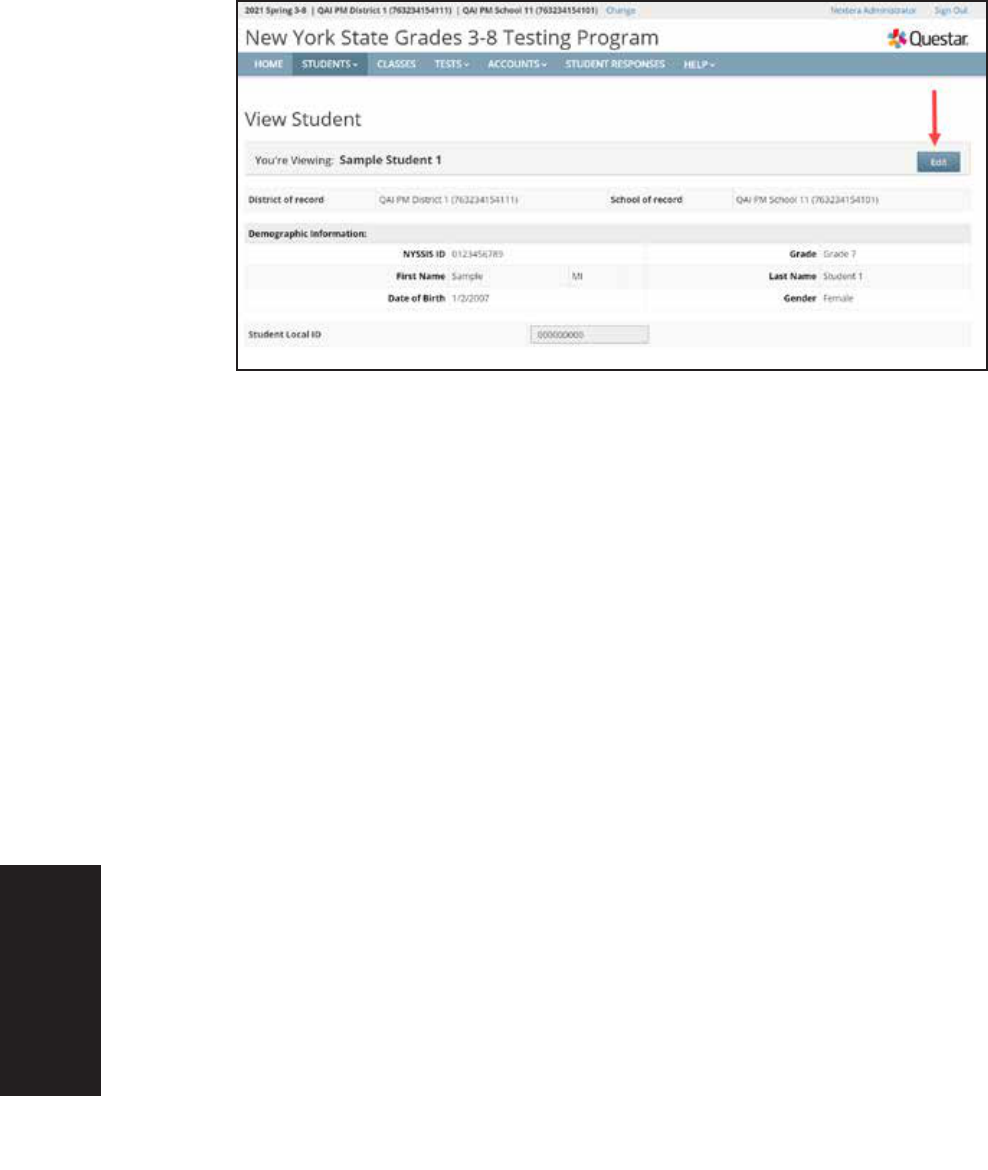
54
Appendices
Grades 3–8 English Language Arts and Mathematics Tests School Administrator’s Manual v202
3. To view the details of a particular student and make changes to that student (if permissions
allow), select View for the applicable student. The student information displays, including the
student’s name, grade, date of birth, NYSSIS ID, local ID, class name, and accommodation
options.
•
Click Edit on the upper right to make changes to the student’s information or to set testing
accommodations.
4. To return to the Class List, use your web browser’s back button.
A-54
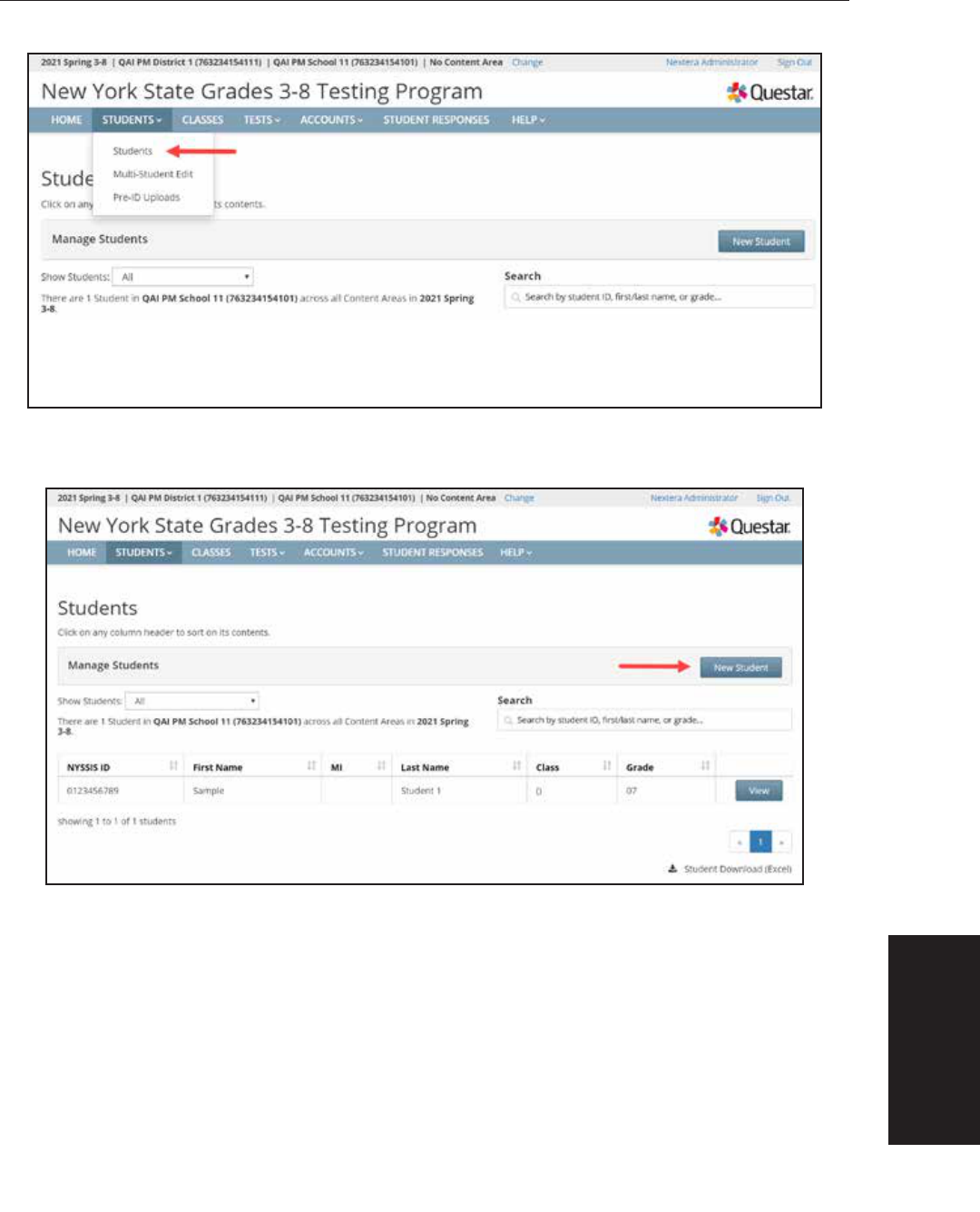
55
Appendices
Grades 3–8 English Language Arts and Mathematics Tests School Administrator’s Manual v202
To Add or Edit a Student (School and District Test Coordinators only)
1. Select Students from the STUDENTS tab.
2. To add a student:
•
Select New Student on the upper right of the Students page.
A-55
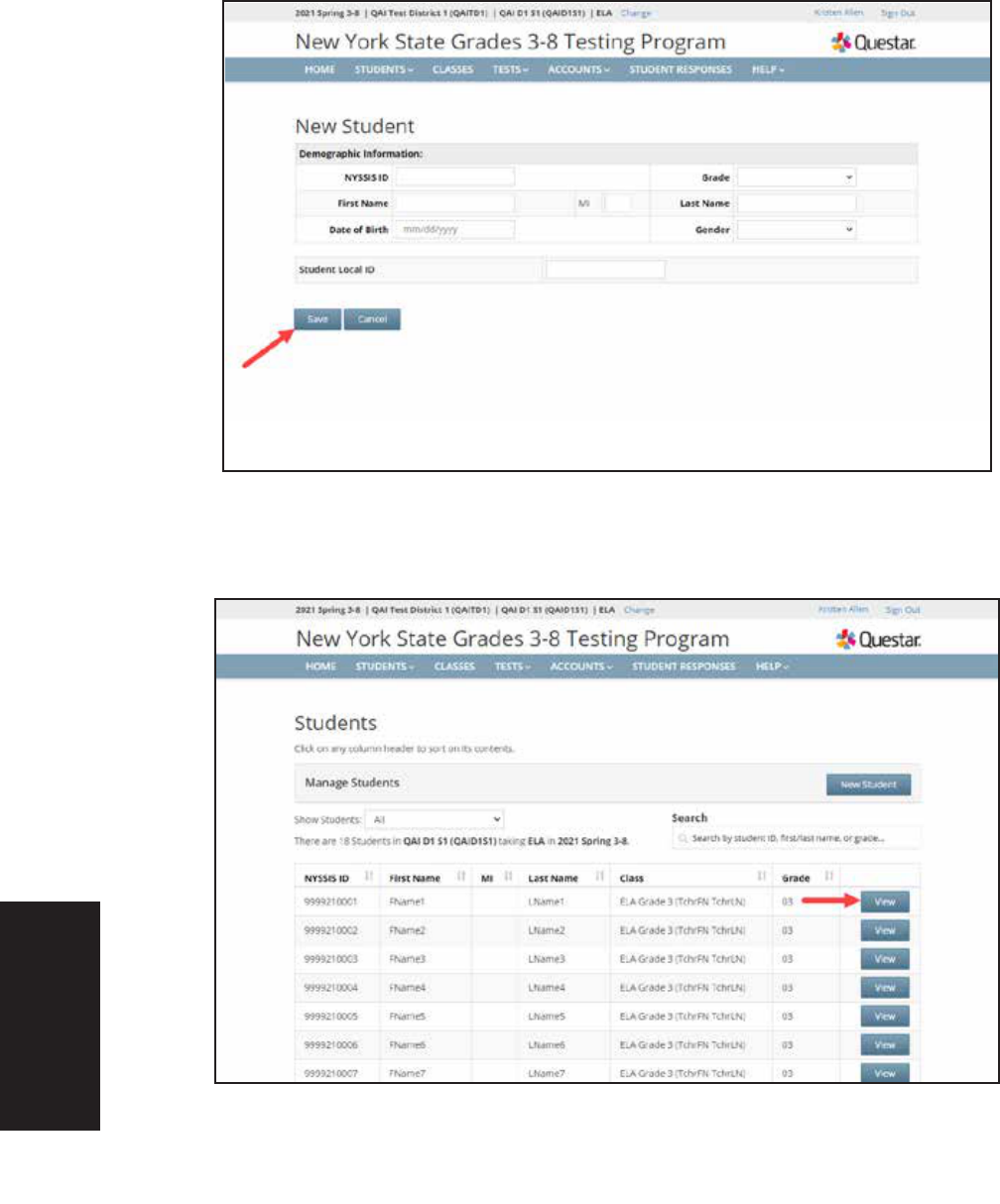
56
Appendices
Grades 3–8 English Language Arts and Mathematics Tests School Administrator’s Manual v202
•
Enter the new student’s information and click Save. The bold text on the New Student page
indicates required information to create a new student (NYSSIS ID, Grade, First Name, Last
Name, and Date of Birth). Local Student ID is also required.
•
When creating a new student, you can assign that student to a class in Nextera
™
Admin
before clicking Save or you can assign the student to a class as an additional step.
3. To edit a student:
•
Locate the student’s name on the Students page (you can browse to the student’s name or
use the Search feature on the upper right) and click View.
A-56

57
Appendices
Grades 3–8 English Language Arts and Mathematics Tests School Administrator’s Manual v202
•
Click Edit on the upper right of the student’s details page.
A-57
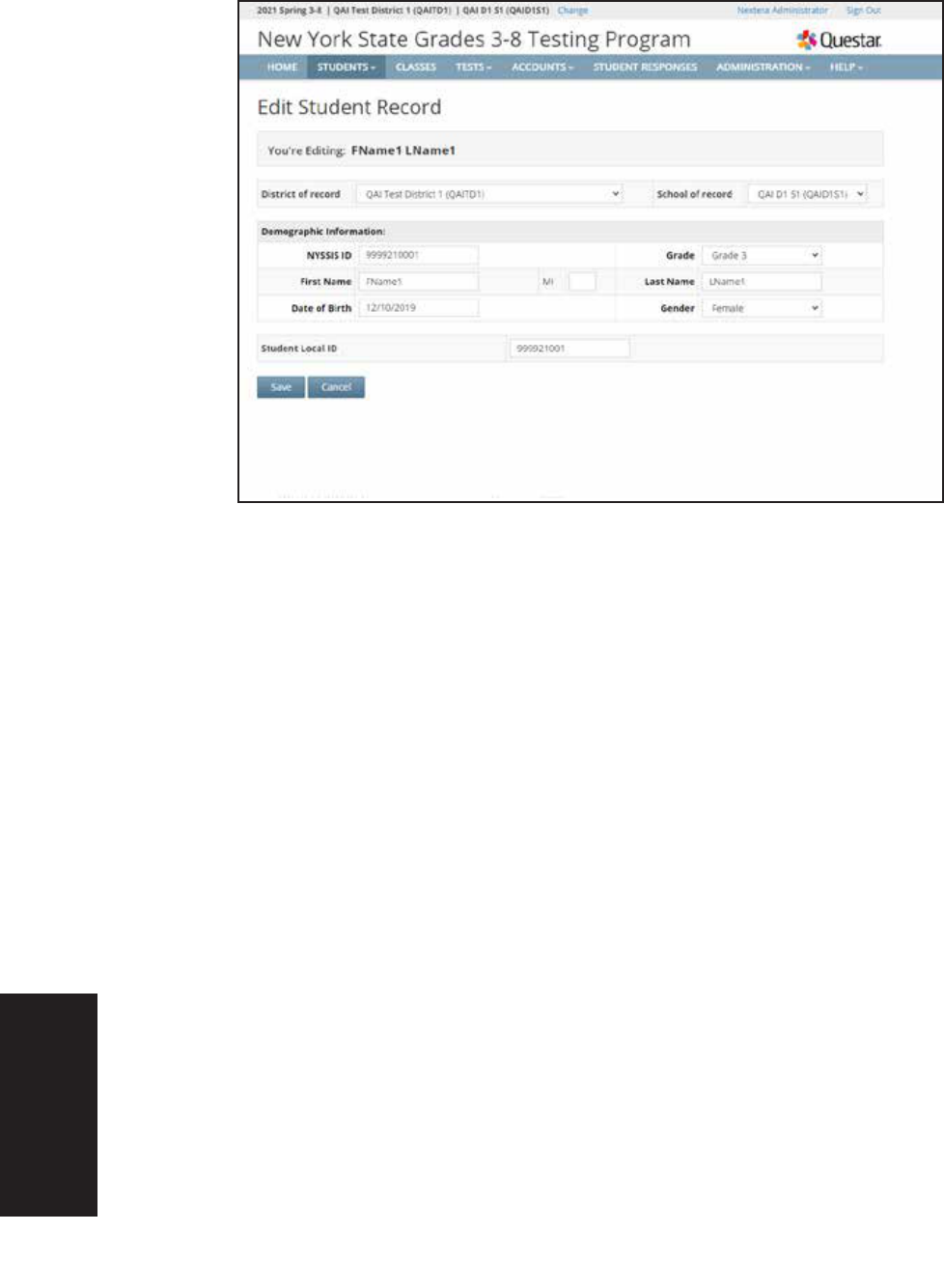
58
Appendices
Grades 3–8 English Language Arts and Mathematics Tests School Administrator’s Manual v202
•
To update the student’s general information, edit the applicable field(s) and select Save.
A-58

59
Appendices
Grades 3–8 English Language Arts and Mathematics Tests School Administrator’s Manual v202
4. To add or edit a student’s accommodations:
•
Locate the student’s name on the Students page (you can browse to the student’s name or use
the Search feature on the upper right) and click View.
•
Click Edit on the upper right of the student’s details page.
•
Scroll to the bottom of the Edit Student Record page and click Modify under the “Accessibility
and Accommodation Options.” The Select Accommodations screen pops up. Nextera
™
Admin
includes both online testing accommodations as well as classroom accommodations. Please note
that classroom accommodations are accommodations that are managed outside of the Nextera
™
Test Delivery System, such as for Flexibility in setting, Method of response, and more.
For a description of the online testing accommodations options available in the Nextera
™
Administration System, see Appendix T: Nextera
™
Test Delivery System Computer-Based
Testing Accommodations.
A-59

60
Appendices
Grades 3–8 English Language Arts and Mathematics Tests School Administrator’s Manual v202
•
To update or add an online testing accommodation, first select the Online Testing
Accommodations tab (the Online Testing Accommodations tab is the default view).
•
Click on the testing accommodation icon for the testing accommodation you want to add to
the student’s record.
•
Click Save to add the online testing accommodation to the student’s computer-based test.
•
Click Save again on the Edit Student Record page to apply all changes to the student.
Note: a student must be assigned to a class in order to see the “Accommodations and Accessibility
Options” panel on the Edit Student Record page.
A-60
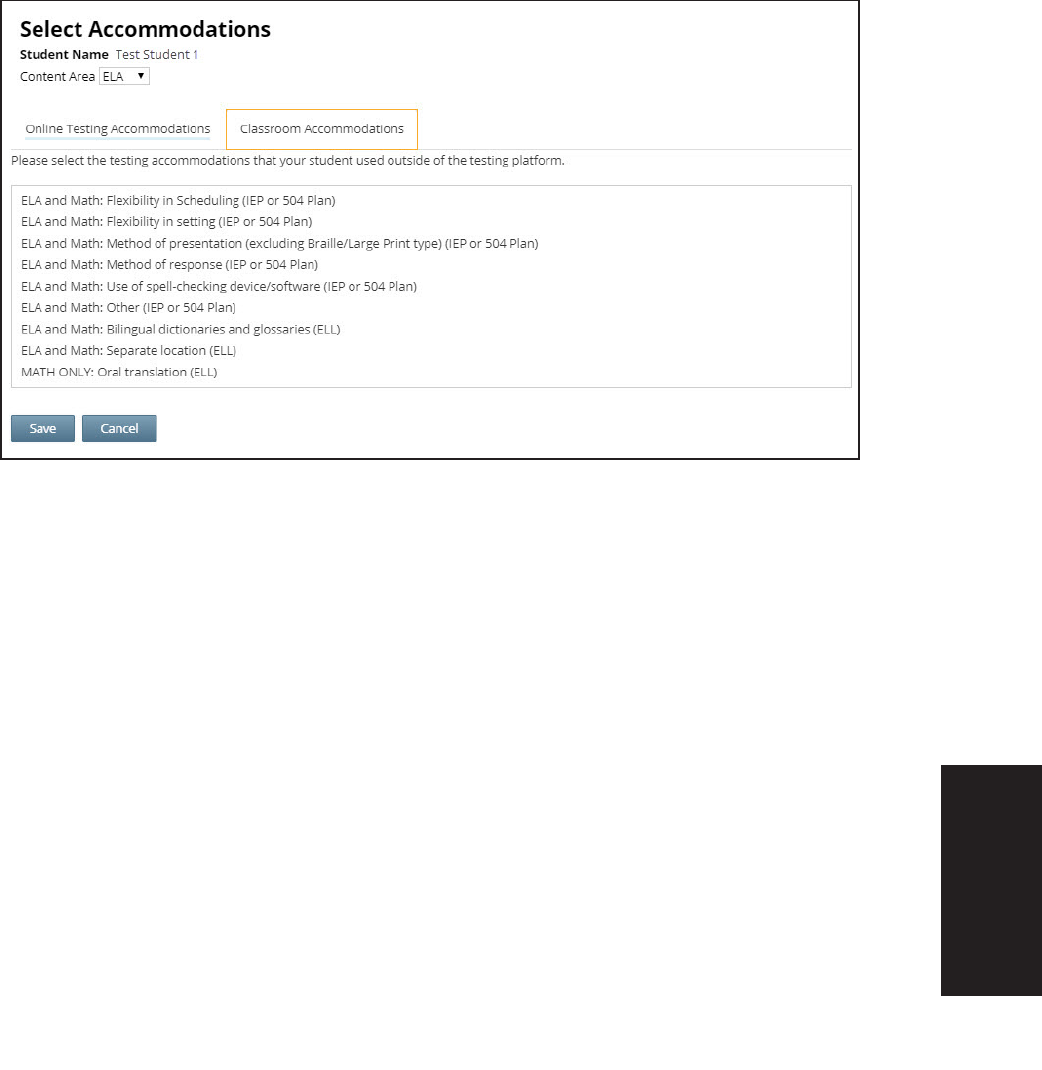
61
Appendices
Grades 3–8 English Language Arts and Mathematics Tests School Administrator’s Manual v202
To update or add a classroom accommodation, first select the Classroom Accommodations tab.
•
Select the classroom accommodation you want to add from the list.
•
Click Save to add the classroom accommodation to the student’s record.
•
Please note that these are classroom accommodations only; there is no online component to a
classroom accommodation.
•
Click Save again on the Edit Student Record page to apply all changes to the student’s record.
Note: a student must be assigned to a class in order to see the “Accommodations and Accessibility
Options” panel on the Edit Student Record page.
A-61
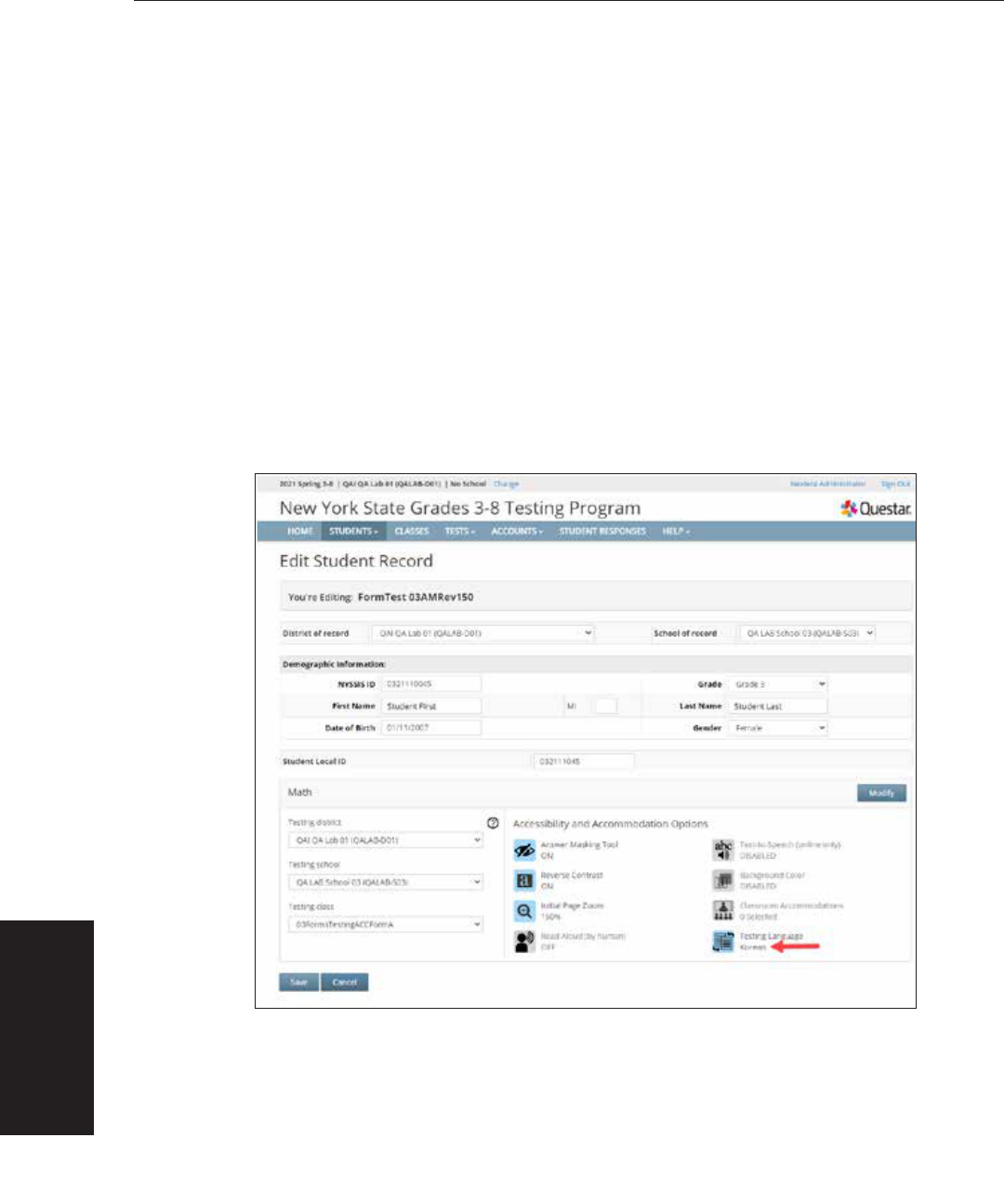
62
Appendices
Grades 3–8 English Language Arts and Mathematics Tests School Administrator’s Manual v202
To Set a Student’s Alternate Language for the Computer-Based
Mathematics Test
To set an alternate language to display for the student’s Mathematics Test in the Nextera
™
Test Delivery
System, such as Chinese (Traditional), Haitian Creole, Korean, Russian, and Spanish, you must first set the
student’s testing language to align with the alternate language that should display on-screen for the
student’s test.
•
Locate the student’s name on the Students page (you can browse to the student’s name or use
the Search feature on the upper right) and click View.
•
Click Edit on the upper right of the student’s details page.
•
Select the alternate language from the drop-down menu next to “Testing Language.”
•
The accompanying alternate language accommodation icon displays in the “Accommodations
and Accessibility Options” panel for mathematics, indicating that the alternate language is set
for that student’s computer-based Mathematics Test.
Reminder: To review student testing accommodations and alternate languages that have been set for
students, you can navigate to any student details page or download the list of all students from the
Students page. Student testing accommodations appear in downloadable reports.
A-62

63
Appendices
Grades 3–8 English Language Arts and Mathematics Tests School Administrator’s Manual v202
Multi-Student Edit
This feature allows you to add or edit student testing accommodations to any student in the school from
one location. Navigating to the Multi-Student Edit page provides access to all students, with the ability to
set individual or multiple accommodations for individual students or for a group of students from one
location. Accommodations are set only for selected students.
●
Changes made using this function will affect all selected students.
●
Selecting students, clicking on accommodations icons, and clicking Save will overwrite any
previously set accommodations, so it is important to be careful with student selections (the check
box to the left of a student’s name).
●
You can select multiple students to set the same accommodation(s) to multiple students at one
time.
●
After clicking Save all student check box selections will clear.
●
You can return to the Multi-Student Edit page to update student testing accommodations,
including Classroom Accommodations, at any time before testing, but you must reselect any
previously set accommodations when updating any selected student’s testing accommodations.
●
You can also set student testing accommodations for an individual student from the student’s
details page.
1. Select Multi-Student Edit from the STUDENTS tab.
A-63
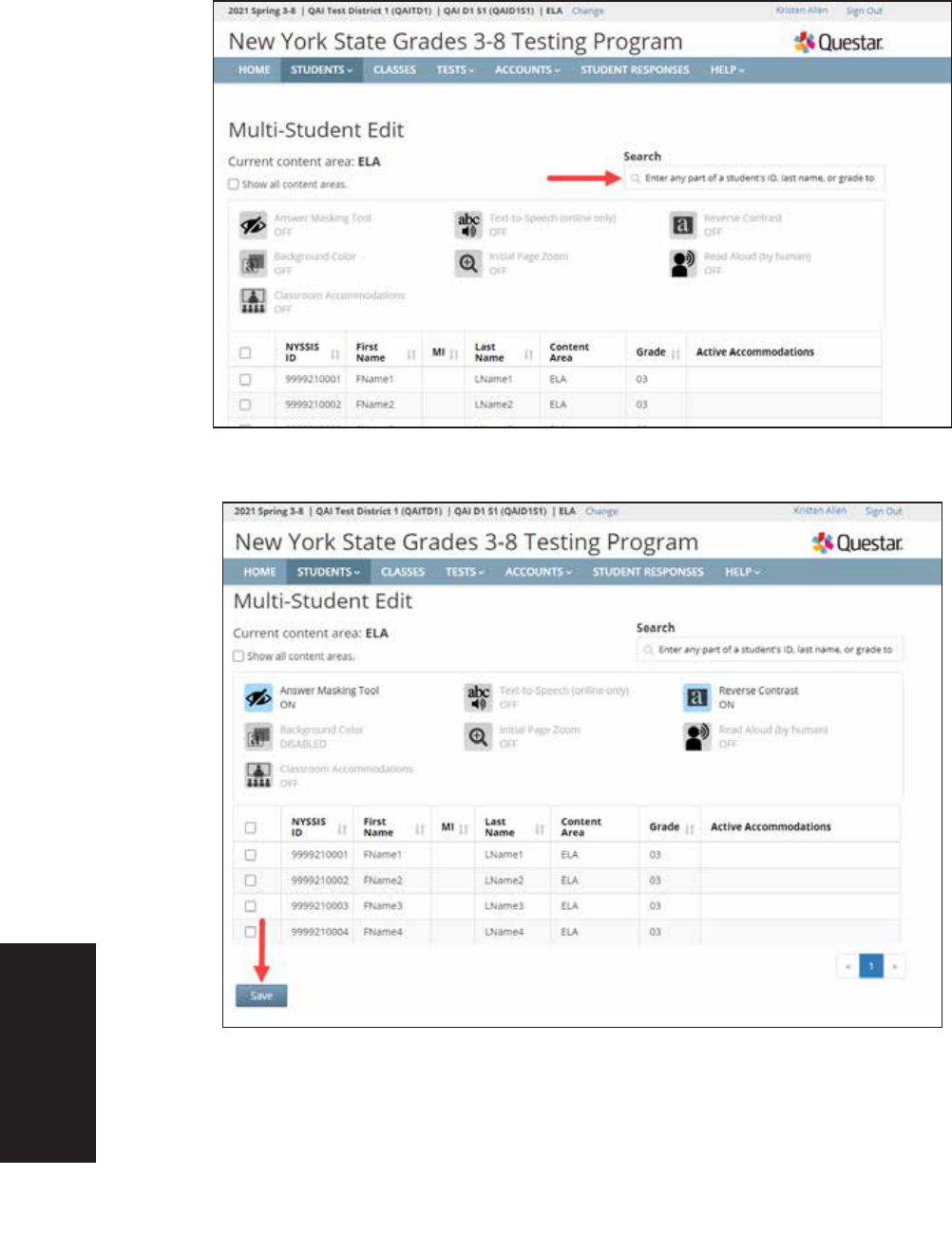
64
Appendices
Grades 3–8 English Language Arts and Mathematics Tests School Administrator’s Manual v202
2. Locate the students’ records you would like to edit using either the search bar or browsing through the
list of student results.
3. Check the boxes on the left next to the students’ names you would like to edit.
A-64
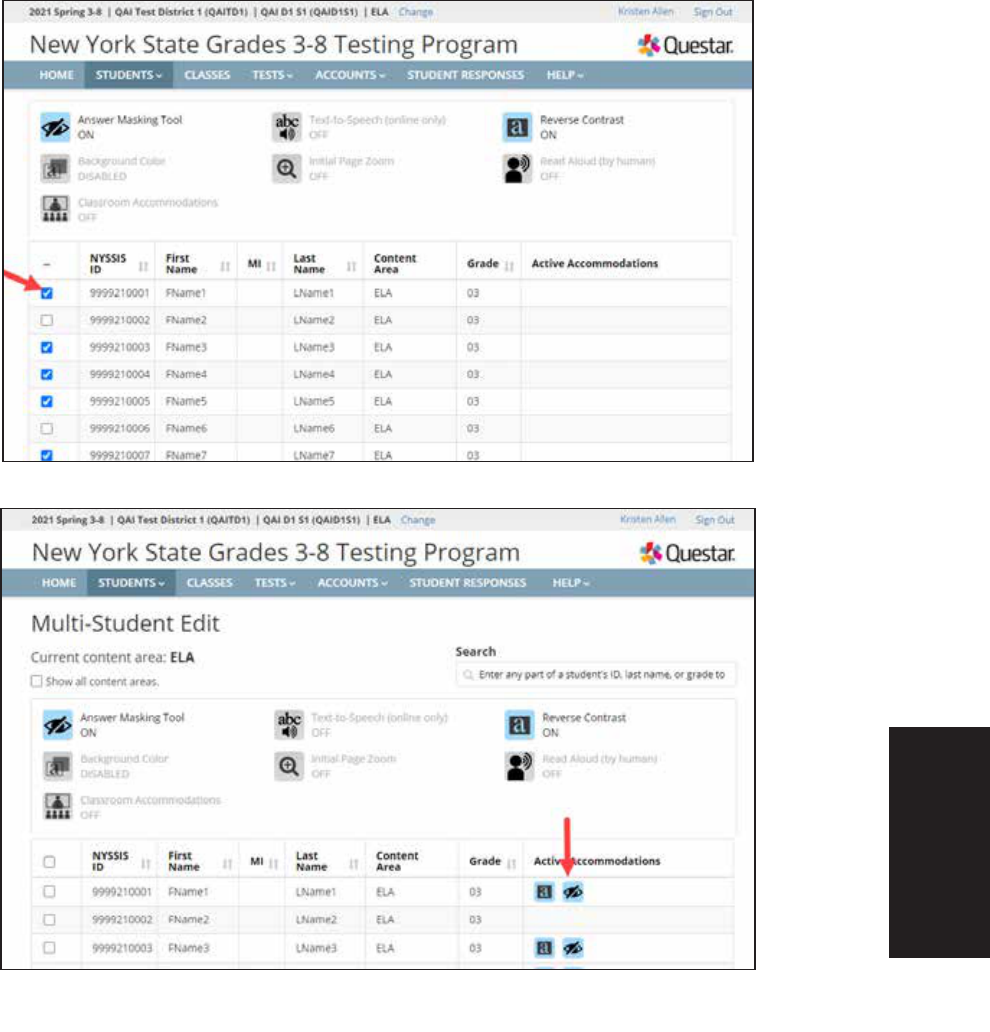
65
Appendices
Grades 3–8 English Language Arts and Mathematics Tests School Administrator’s Manual v202
4. Click the icon next to each accommodation you would like to turn on or off for the students and
click Save to save your changes.
•
You will see the accommodations icons appear to the right of the student’s name after you
click Save.
•
If you click the Classroom Accommodations icon, the list of classroom accommodations will
display, allowing the user to select check boxes for the needed classroom accommodation.
Click Apply and then Save to add a classroom accommodation to a selected student.
•
After clicking Save all student check box selections will clear.
•
If you want to add additional accommodations to a group of students or an individual student,
you must select the student by clicking the check box on the left next to the student’s name.
•
You can confirm that accommodations are correctly set for your students.
A-65
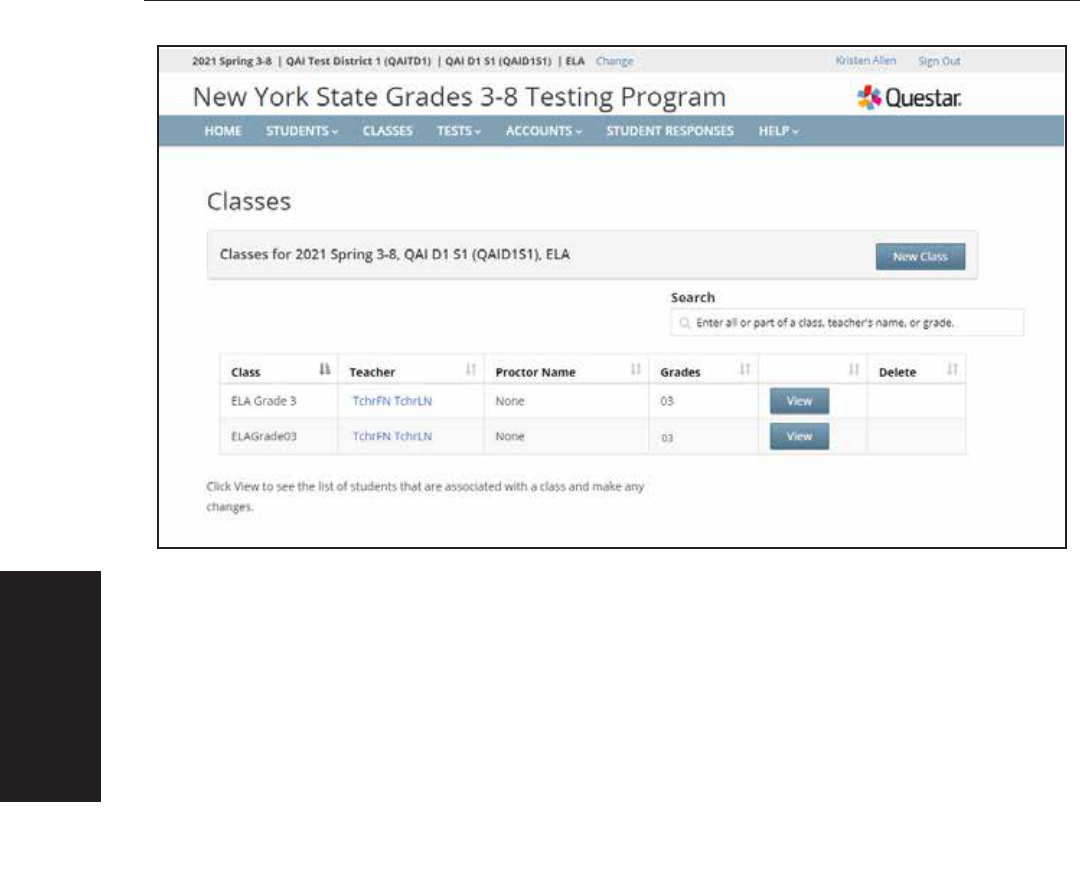
66
Appendices
Grades 3–8 English Language Arts and Mathematics Tests School Administrator’s Manual v202
Classes Tab
Based on the user’s role, the CLASSES tab allows users to view, make changes, and create classes in the
Nextera
™
Admin system. In New York State, students are loaded into Nextera
™
Admin from the Level 2
Data Warehouse before each CBT administration. Students are loaded by grade-level enrollment. When
navigating to the CLASSES tab for the first time, a user may see the enrollment classes that were loaded
to Nextera
™
Admin entitled “PRE ID” with the grade level. Users can edit the name of the populated class
with all student enrollments or create new classes to group students, such as by testing accommodation,
homeroom, and more. Each school can arrange student testing in a way that best fits their CBT needs.
The “teacher role” in Nextera
™
Admin is associated to a class only for CBT proctoring purposes.
●
Protip: You can group students in a class from different grade levels, such as for creating a makeup
testing class with students from all grades in Nextera
™
Admin. The students in the class will all have
the same test session access code, and the grade level associated to the student ensures the
student is provided with the correct grade-level test in Nextera
™
Admin.
To View and Edit a Class
1. Select the CLASSES tab. Review the list of classes. To see details regarding a class, select View.
A-66

67
Appendices
Grades 3–8 English Language Arts and Mathematics Tests School Administrator’s Manual v202
2. Information displayed includes the class name, teacher, class, test window, classroom, proctor,
content area, and the list of students in the class.
•
To edit the class details, including adding or removing students associated with the class,
click Edit.
3. To change general class information (teacher, class name, classroom, proctor, etc.), update the
applicable field(s) and click Save.
•
Protip: A teacher account must be active in Nextera
™
Admin to appear in the drop-down list of
Teachers to be selected and associated to a class.
•
To find students in different classes to add to a class, use the “Search by Class” drop-down
menu on the upper left.
A-67
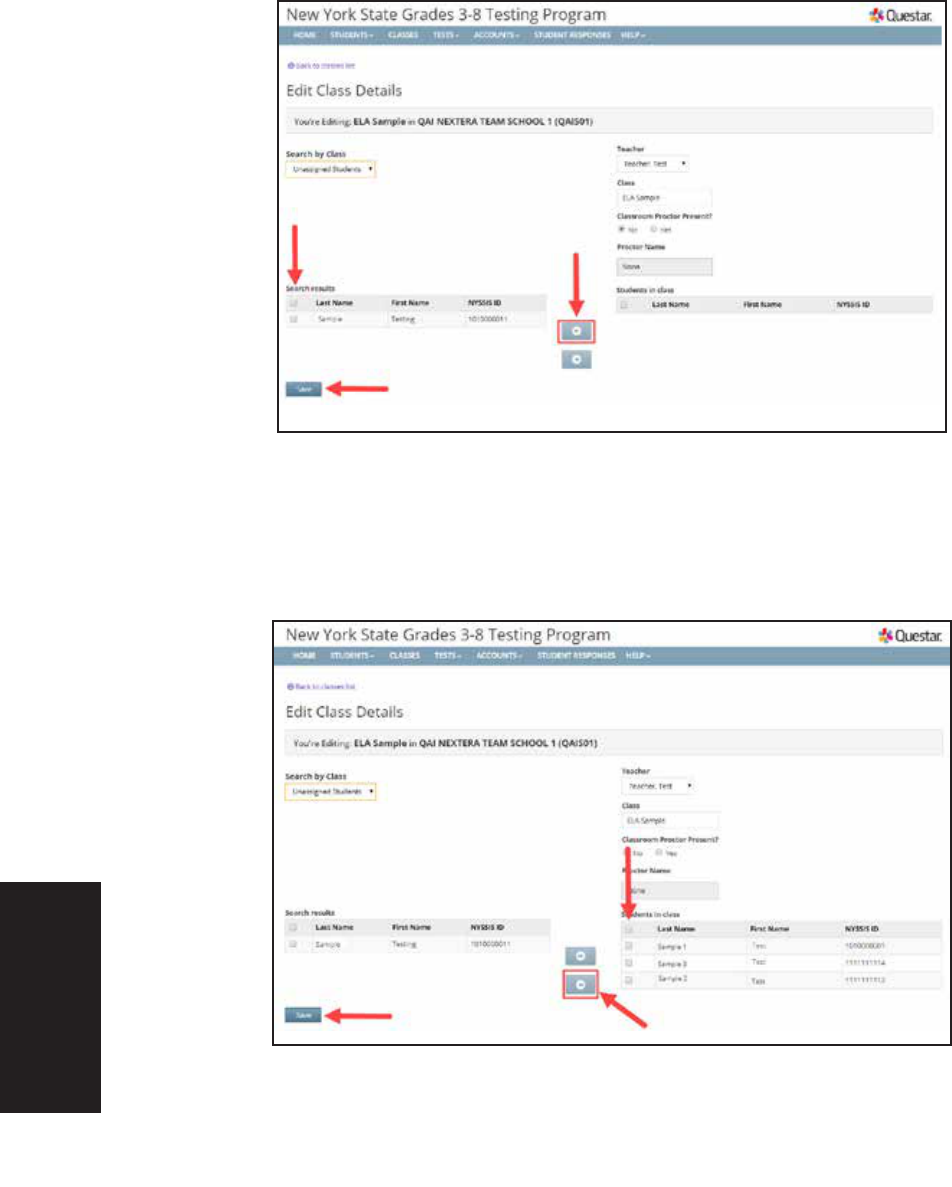
68
Appendices
Grades 3–8 English Language Arts and Mathematics Tests School Administrator’s Manual v202
4. To add students to the class:
•
Beneath the “Search results” list, select the check box (or check boxes to add more than one
student at a time to the class list) to the left of a student’s name.
•
Select the right arrow to move the student(s) to the “Students in class” list on the lower right.
•
Click Save.
5. To remove students from the class:
•
Select the check box (or check boxes to remove more than one student at a time from the
class list) to the left of the student’s name in the right column.
•
Select the left arrow to remove the student(s) from the “Students in class” list.
•
Click Save.
A-68
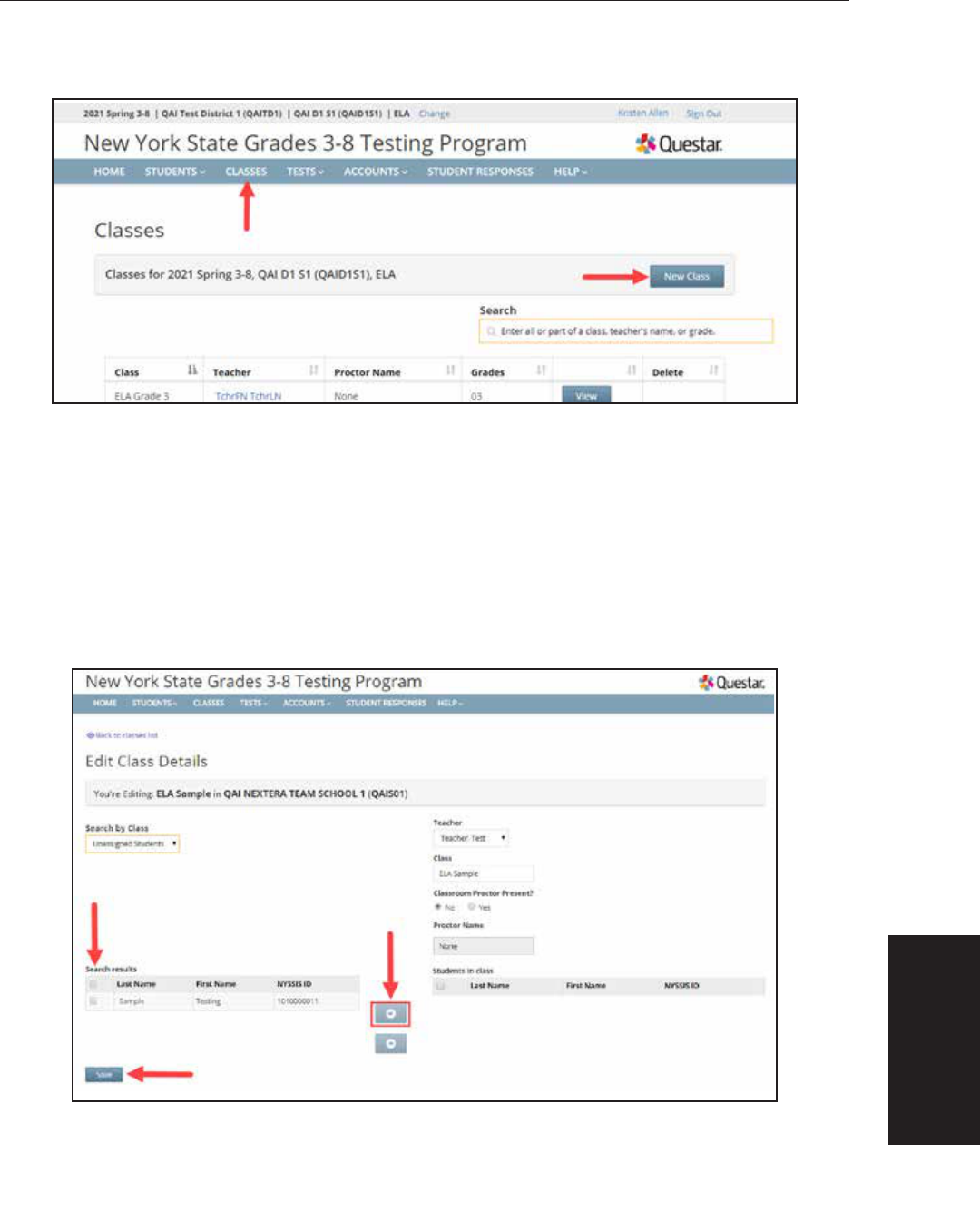
69
Appendices
Grades 3–8 English Language Arts and Mathematics Tests School Administrator’s Manual v202
To Add a Class
1. Select the CLASSES tab. Select New Class.
•
Protip: You must have a content area, such as English Language Arts or Mathematics, selected
on the “Change” menu in order to create a new class.
2. Enter the class details, including selecting the teacher from the “Teacher” drop-down menu, class
name, and proctor information. (Proctors are not required but can be added if the school wants
this information visible for the class data in Nextera
™
Admin.)
•
Use the “Search by class” drop-down menu on the upper left to locate lists of students.
•
Add students by selecting the check box (or check boxes to add more than one student at a
time to the class list) to the left of a student’s name.
•
Select the right arrow to move the student(s) to the “Students in class” list on the lower right.
•
Click Save.
A-69
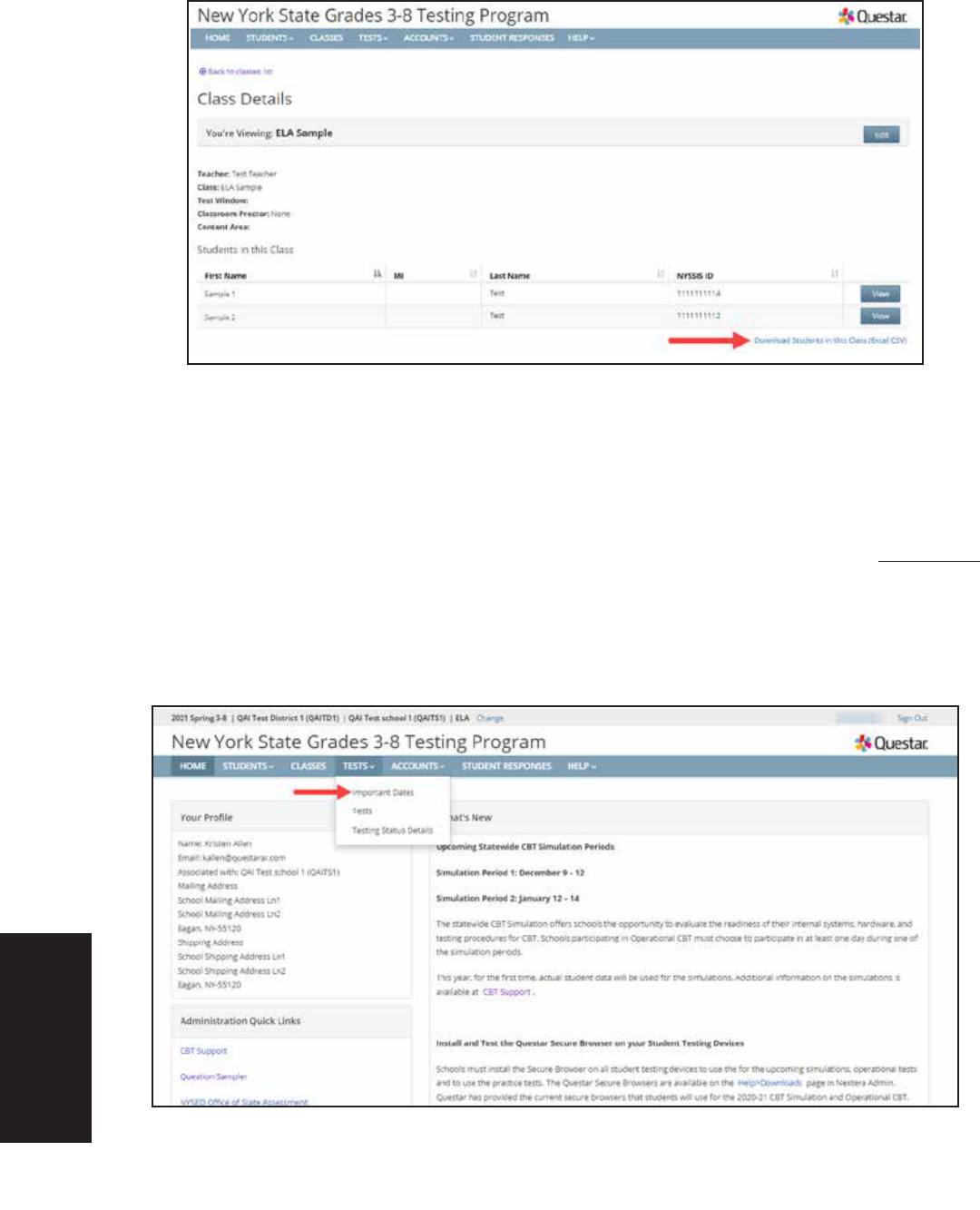
70
Appendices
Grades 3–8 English Language Arts and Mathematics Tests School Administrator’s Manual v202
•
Navigate to the Class Details page to download a list of all students in the class for review.
Tests Tab
Based on the user’s role, the TESTS tab allows users to view important dates and test administration
details, print student login tickets, designate students not taking the test, and track student progress of
students who are actively testing. The TESTS tab includes the Important Dates, Tests, and Testing Status
Details pages. The Tests page, which includes the ability to print student login tickets, and view session
access codes, is only available directly before a content area testing administration. Check on CBT Support
(http://cbtsupport.nysed.gov) to find out when the English Language Arts and Mathematics Tests page
will be available to schools.
To view important dates, which include the testing dates for all CBT administrations, select Important
Dates from the TESTS tab. The test dates are displayed for each CBT administration window.
A-70
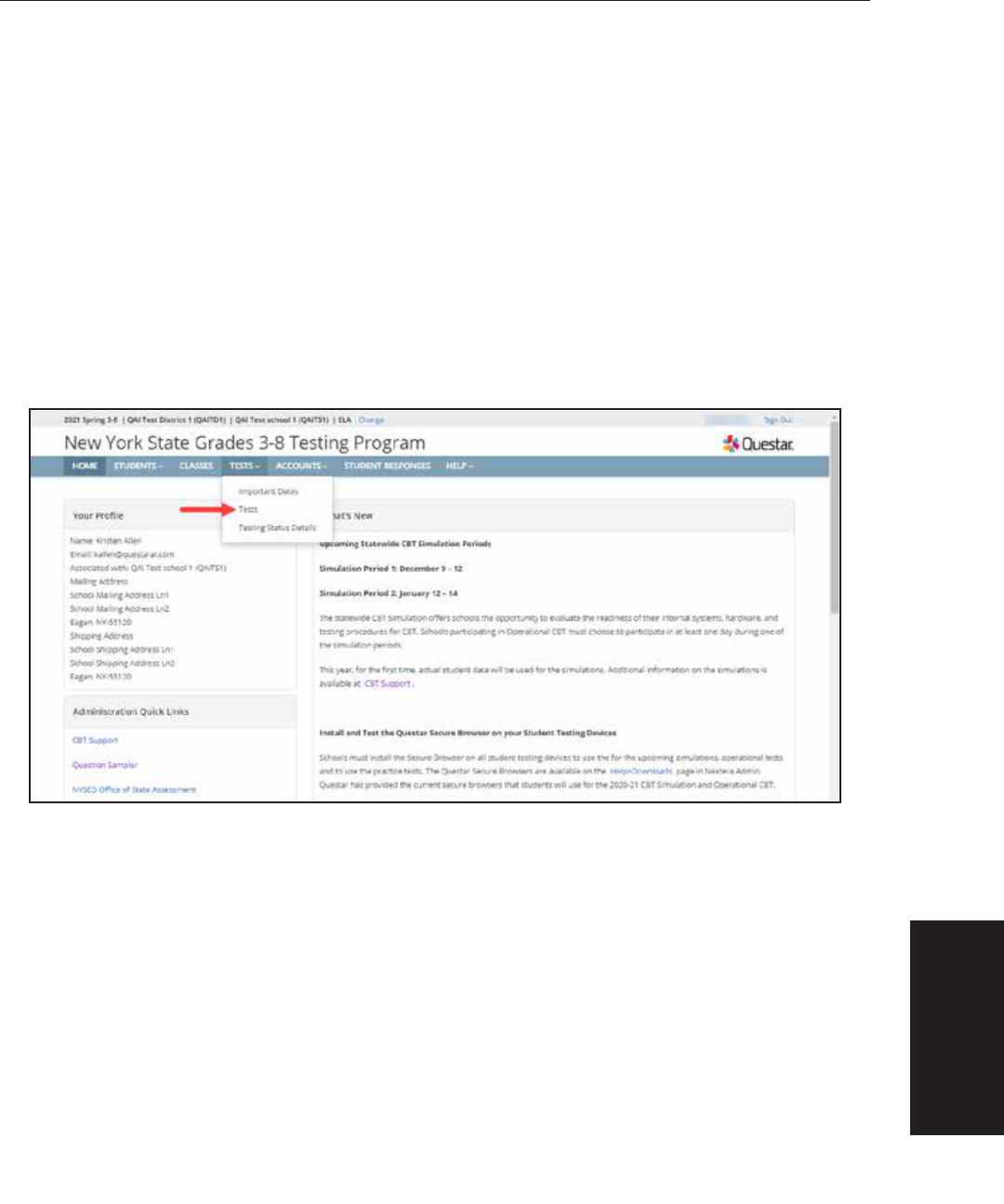
71
Appendices
Grades 3–8 English Language Arts and Mathematics Tests School Administrator’s Manual v202
To View Tests, Session Access Codes, and to Designate Students
Not Testing
There are two ways to set student Not Tested codes in Nextera
™
Admin: either from the Tests page or
from the Testing Status Details page. The latter is available to schools as soon as students are loaded and
available in Nextera
™
Admin. The former, from the Tests page, is available when the Tests page is opened
directly before a content area testing administration.
1. Select Tests from the TESTS tab. Information displayed includes the teacher, class, content
area,
test name, and testing status.
•
As soon as the first student accesses their test in the Nextera
™
Test Delivery System, the
“Testing Status” will show “In Progress” for students in that testing class.
•
Click the up/down arrows in the column headings to sort classes on the Tests page.
•
The View Test page displays the student name, username and password, grade level, test form
assigned to the student, testing status, total test questions completed, and start and end
times.
•
The View Test page is refreshed every 60 seconds.
A-71
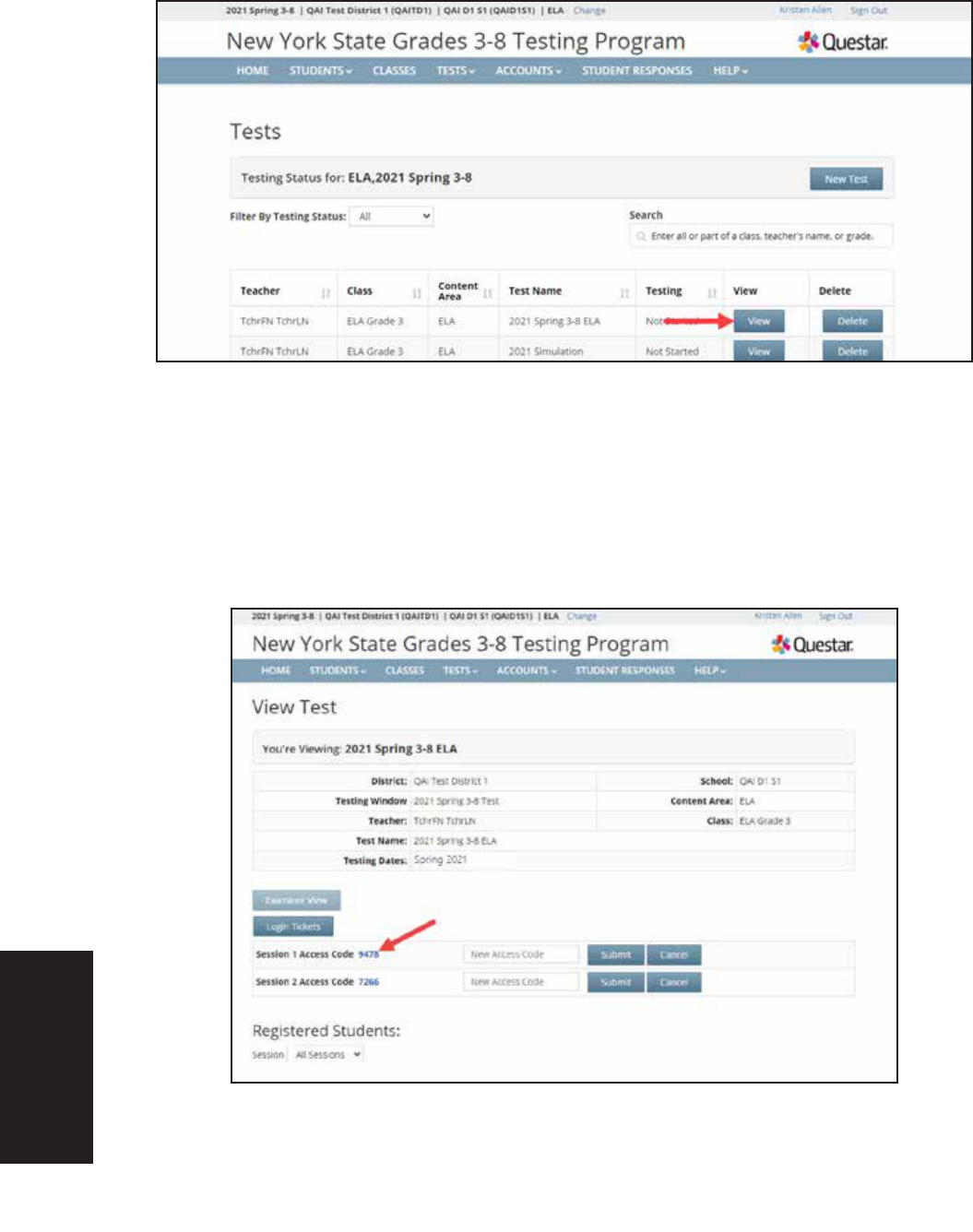
72
Appendices
Grades 3–8 English Language Arts and Mathematics Tests School Administrator’s Manual v202
2. To view test details, select View.
3. The View Test page displays test details, including the test progress, student status, and session
access codes. The teacher will provide the session access code on the day of the applicable test
session to students to allow them to start the test in the Nextera
™
Test Delivery System.
•
The session access code can be changed by entering a new code in the “New Access Code”
field and clicking Submit.
•
The session access code is a secure testing material that should be distributed to testing
classrooms on the morning of the test session.
A-72
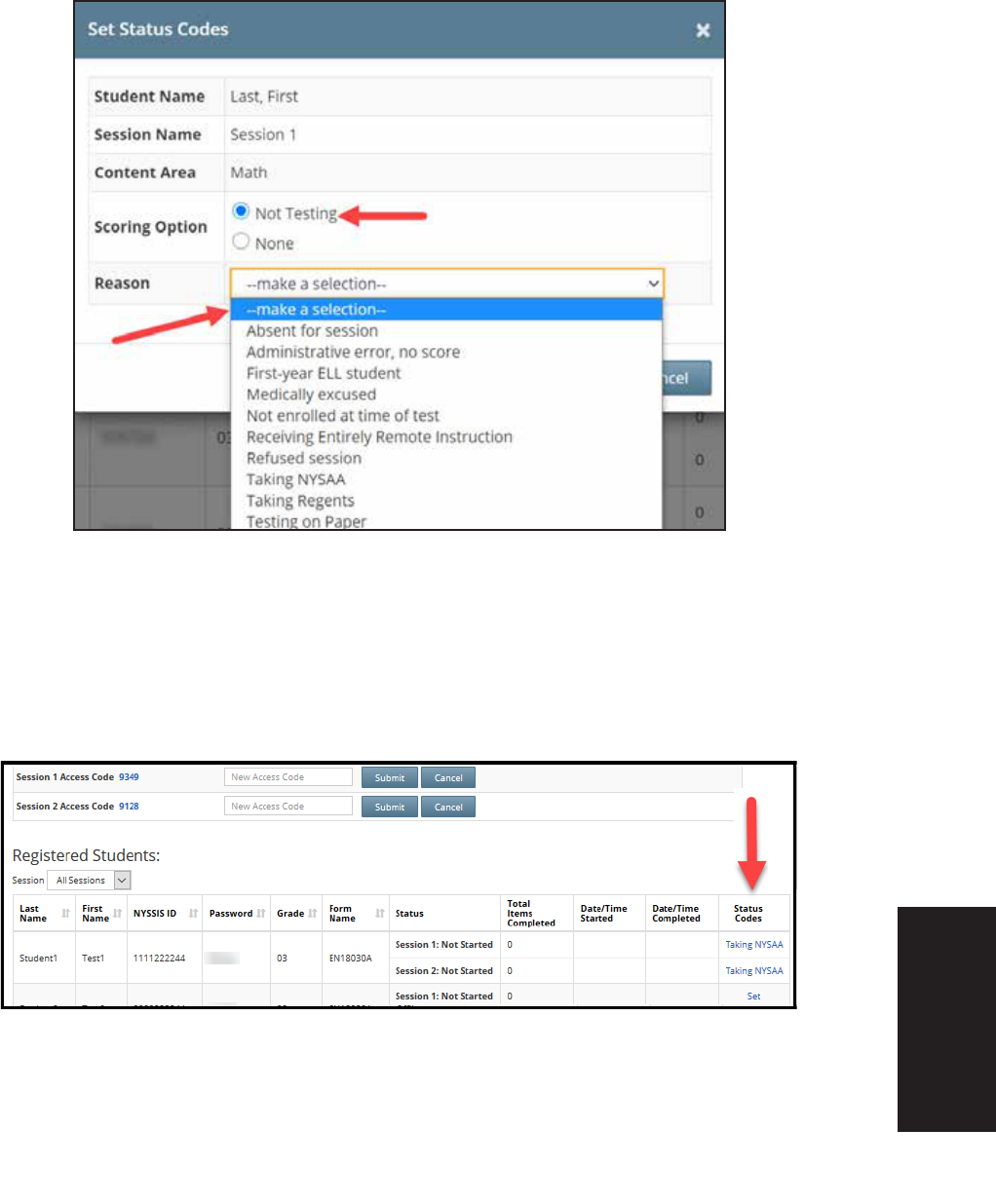
73
Appendices
Grades 3–8 English Language Arts and Mathematics Tests School Administrator’s Manual v202
4. To indicate that a student is not testing, locate the student’s name in the class list and click Set in
the “Status Codes” column.
•
For “Scoring Option,” select Not Testing to view the list of Not Testing codes in the “Reason”
drop-down menu.
•
Select the applicable Not Testing code.
•
Click Submit. You will see that a status code has been set for the student’s test session.
•
Not Testing codes must be set for both test sessions if the student will not be testing in
Session 1 and Session 2.
•
To download a list of students with their Not Testing codes, visit the Testing Status Details
page for that class.
A-73
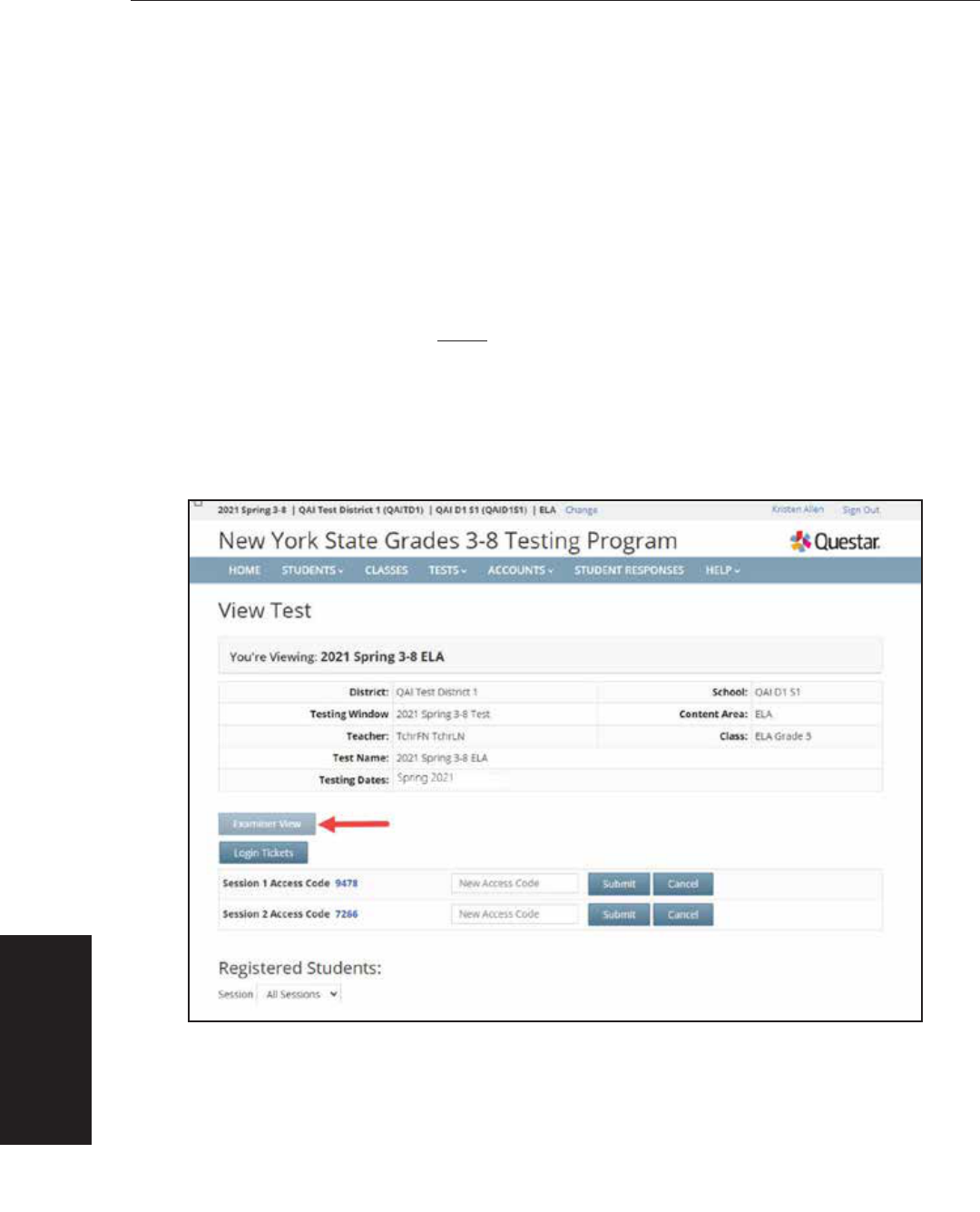
74
Appendices
Grades 3–8 English Language Arts and Mathematics Tests School Administrator’s Manual v202
Examiner View
The Examiner View feature is helpful when you have an educator supporting testing who does not have
or need access to the Nextera
™
Administration System. The Examiner View allows the STC or Teacher
associated to the testing class to open up a view of the active testing status for a testing class on a
different user’s computer without providing editing access to that testing class. The user can “examine”
the testing status, including viewing student login tickets, but cannot edit any information associated to
the test or students.
If you would like another educator to have access to individual student passwords and progress during
the assessment and that educator does not have a user account in Nextera
™
Admin, use this feature by
completing the following steps:
To set up Examiner View:
1. As the STC or Teacher, on the other educator’s computer, sign in to the Nextera
™
Administration
System with your username and password.
2. Select Tests from the TESTS tab.
3. Locate the applicable class and select View.
4. Click the blue Examiner View button on the View Test page.
A-74

75
Appendices
Grades 3–8 English Language Arts and Mathematics Tests School Administrator’s Manual v202
5. This opens a new tab on the Web browser containing the session access codes, student
passwords, and student testing progress. This tab will automatically refresh and display updated
student progress information. Keep this tab open. On the first tab, sign out of the Nextera
™
Administration System.
•
Now the other educator will have access to student progress during the assessment even
though that educator does not have a Nextera
™
Admin user account.
•
The testing status with student testing progress refreshes every 60 seconds.
•
The Examiner View shows student names, usernames and passwords, test status, the number
of test questions completed, and start and end time stamps for every student.
To Print Student Login Tickets (Labels)
Each student in the class will need student login tickets to sign in to the test session. On the day of the
computer-based test, the teacher will provide the access code to the students for that day’s test session.
Teachers may print student login tickets as labels.
To print the student login tickets as labels, complete the following steps:
1. Select Tests from the TESTS tab.
A-75
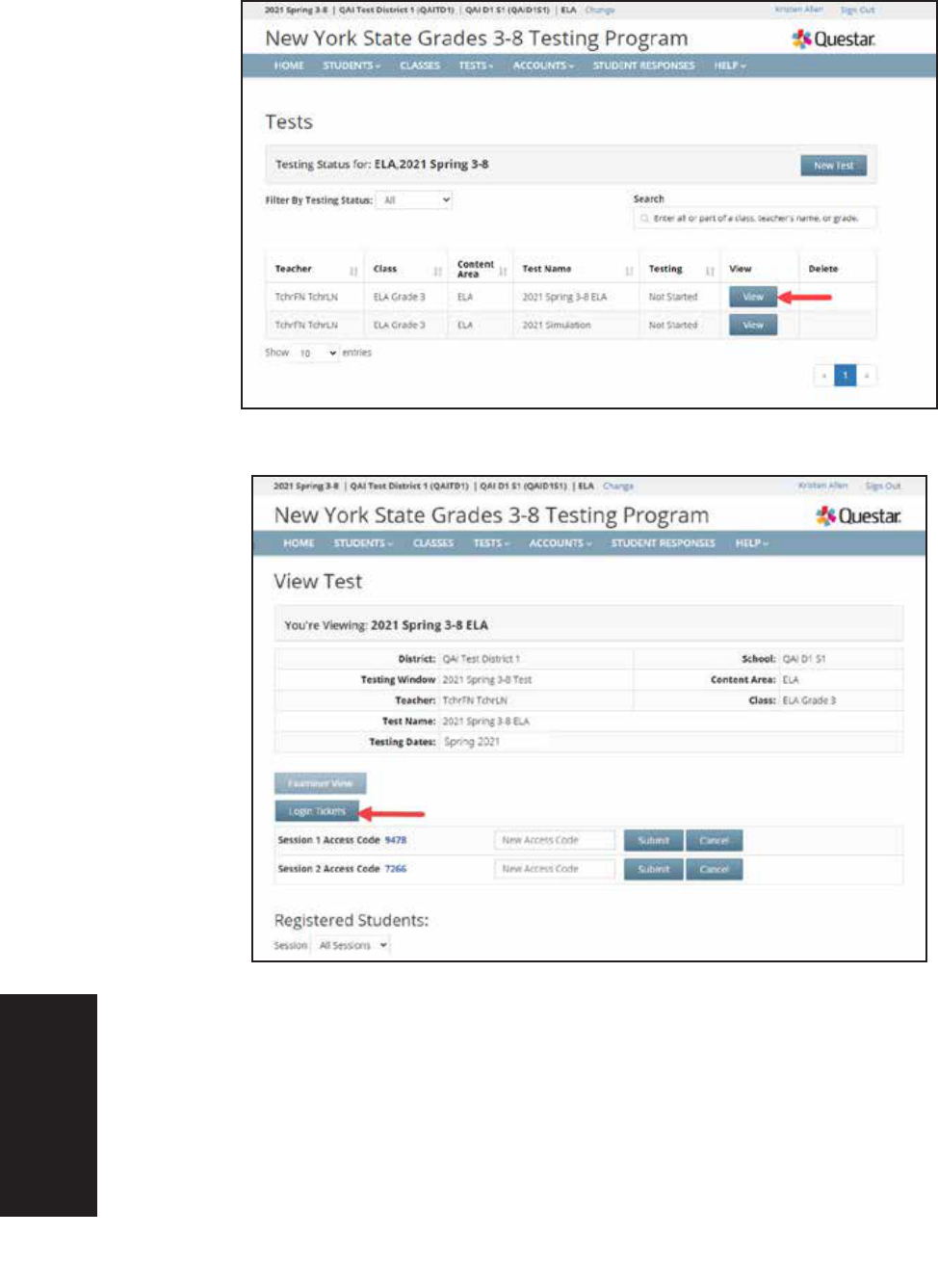
76
Appendices
Grades 3–8 English Language Arts and Mathematics Tests School Administrator’s Manual v202
2. Click View for the applicable test.
3. On the View Test page, click Login Tickets.
A-76

77
Appendices
Grades 3–8 English Language Arts and Mathematics Tests School Administrator’s Manual v202
4. Select the form option from the printing drop-down menu.
5. Click OK.
6. The student login ticket labels display. Use the Print function to print the labels. Each label
includes the student’s name, user ID (NYSSIS ID), password, and test name.
•
All student login tickets or labels are secure testing materials and must also be stored in the
safe or vault if they are printed prior to administration.
A-77

78
Appendices
Grades 3–8 English Language Arts and Mathematics Tests School Administrator’s Manual v202
Troubleshooting Tip for Printing Student Login Tickets
If you are attempting to print student login tickets on label stock and the student login tickets are not
aligning properly with the labels, try the following steps:
1. Save the .pdf file
2. Find the .pdf on your local drive and open it
3. File > print
4. Click “Custom Scale: 100%”
5. Be sure paper size says 8.5 x 11
6. Click Print
A-78

79
Appendices
Grades 3–8 English Language Arts and Mathematics Tests School Administrator’s Manual v202
Testing Status Details
To review testing status details and to set Not Testing codes by session, you can visit the Testing Status Details
page. When navigating to the Testing Status Details page, the user will have some testing status filters
automatically populated based on permissions. DTCs will need to select the school for which they want to
review a class’s status details. STCs will need to select the class and content area for which they want to review
a class’s status details.
1. To review the status of tests in your district or school, select Testing Status Details from the TESTS
tab.
•
Use the Testing Status filter feature to select testing window, district, school, content area, and
class to tailor your view.
•
The testing status details display, showing each student with their testing status for each test
session.
•
You can download the student testing status data into a spreadsheet by clicking Export.
A-79
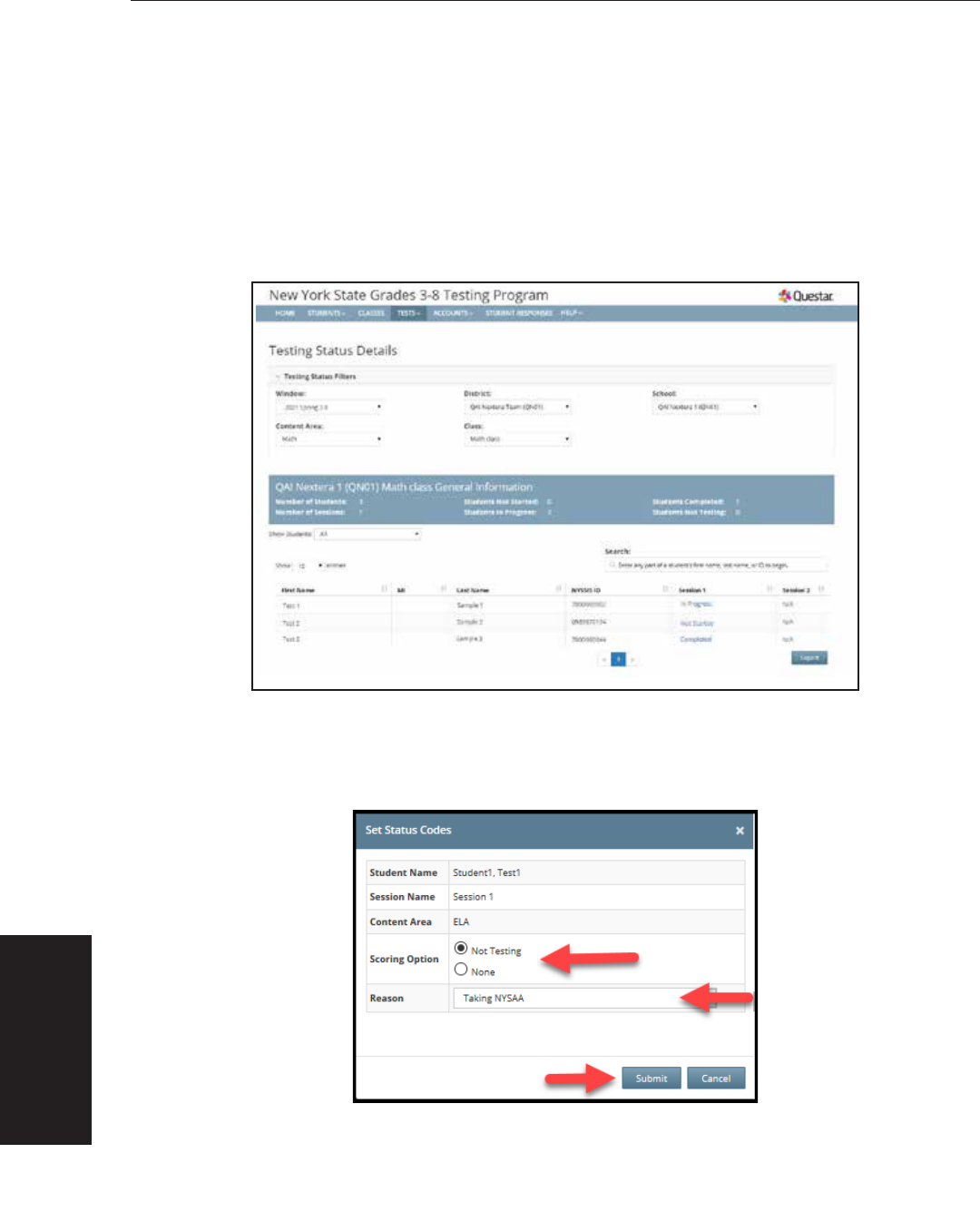
80
Appendices
Grades 3–8 English Language Arts and Mathematics Tests School Administrator’s Manual v202
Setting Student Not Testing Codes
A student’s testing status can be set to a Not Testing code as long as the student has not accessed the
computer-based test in the Nextera
™
Test Delivery System.
1. Select Testing Status Details from the TESTS tab.
2. Use the Testing Status filter feature to select testing window, district, school, content area, and
class to tailor your view.
3. The testing status details display, showing each student with their testing status for each test
session.
4. For the student, click on the blue Not Started link within the applicable test session column. The
Set Status Codes screen pops up.
5. On the Set Status Codes screen, select Not Testing for the “Scoring Option” field.
6. The “Reason” menu is populated with the Not Testing codes.
7. Select the applicable Not Testing code from the “Reason” drop-down menu.
A-80
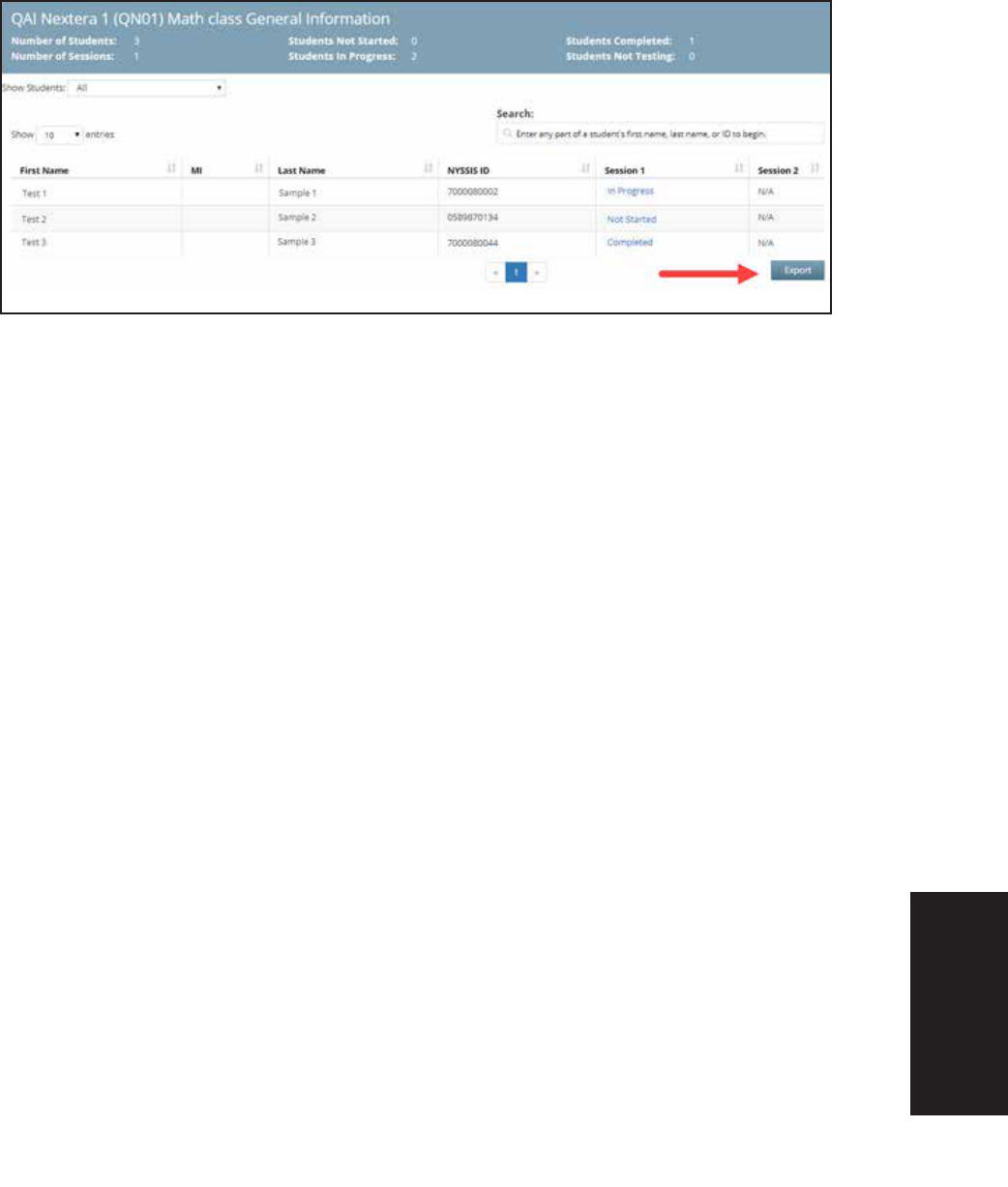
81
Appendices
Grades 3–8 English Language Arts and Mathematics Tests School Administrator’s Manual v202
8. Click Submit. You will see that a status code has been set for the student’s test session.
•
Not Testing codes must be set for both test sessions if the student will not be testing in
Session 1 and Session 2.
•
You can download the student testing status data into a spreadsheet by clicking Export.
A-81

82
Appendices
Grades 3–8 English Language Arts and Mathematics Tests School Administrator’s Manual v202
Accounts Tab
The options on the ACCOUNTS tab vary by role. Any user who will be actively managing CBT may need
a Nextera
™
Admin account. Multiple user levels exist within the Nextera
™
Administration System. DTCs
and STCs can add or edit users at or below their user-account level as needed to allow specific individuals
the rights they need for accessing student testing information.
To Edit an Account
Please reference Appendix U to determine which roles have access to this functionality.
1. Select Accounts from the ACCOUNTS tab.
•
Locate the user either by using the Search bar on the upper right or browsing through the list
of users in the accounts results list.
•
Click View in the “Actions” column to navigate to the user account details page.
2. Click Edit.
A-82
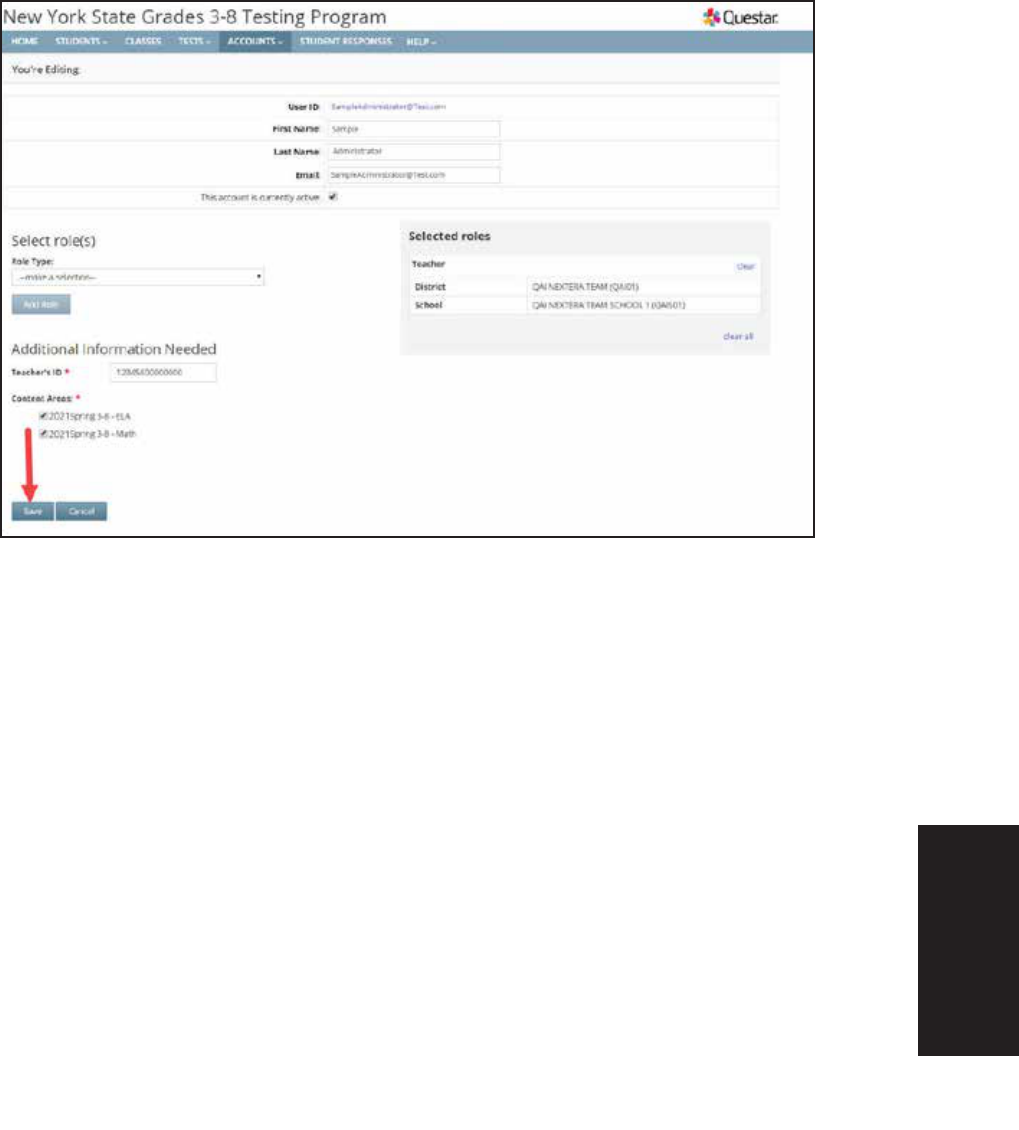
83
Appendices
Grades 3–8 English Language Arts and Mathematics Tests School Administrator’s Manual v202
3. Make the applicable changes and select Save.
•
If you are editing user roles, you must select district and school before clicking Add Role.
The Selected Roles will appear in a list on the left.
•
If you are adding a teacher role, you will need to include a TEACH ID or a local ID for the
user and then select the content area for test administration.
•
Protip: A teacher account must be active in Nextera
™
Admin to appear in the drop-down list
of teachers to be selected and associated to a class.
A-83

84
Appendices
Grades 3–8 English Language Arts and Mathematics Tests School Administrator’s Manual v202
To Add an Account
1. Select Accounts from the ACCOUNTS tab.
2. Select New Account.
A-84
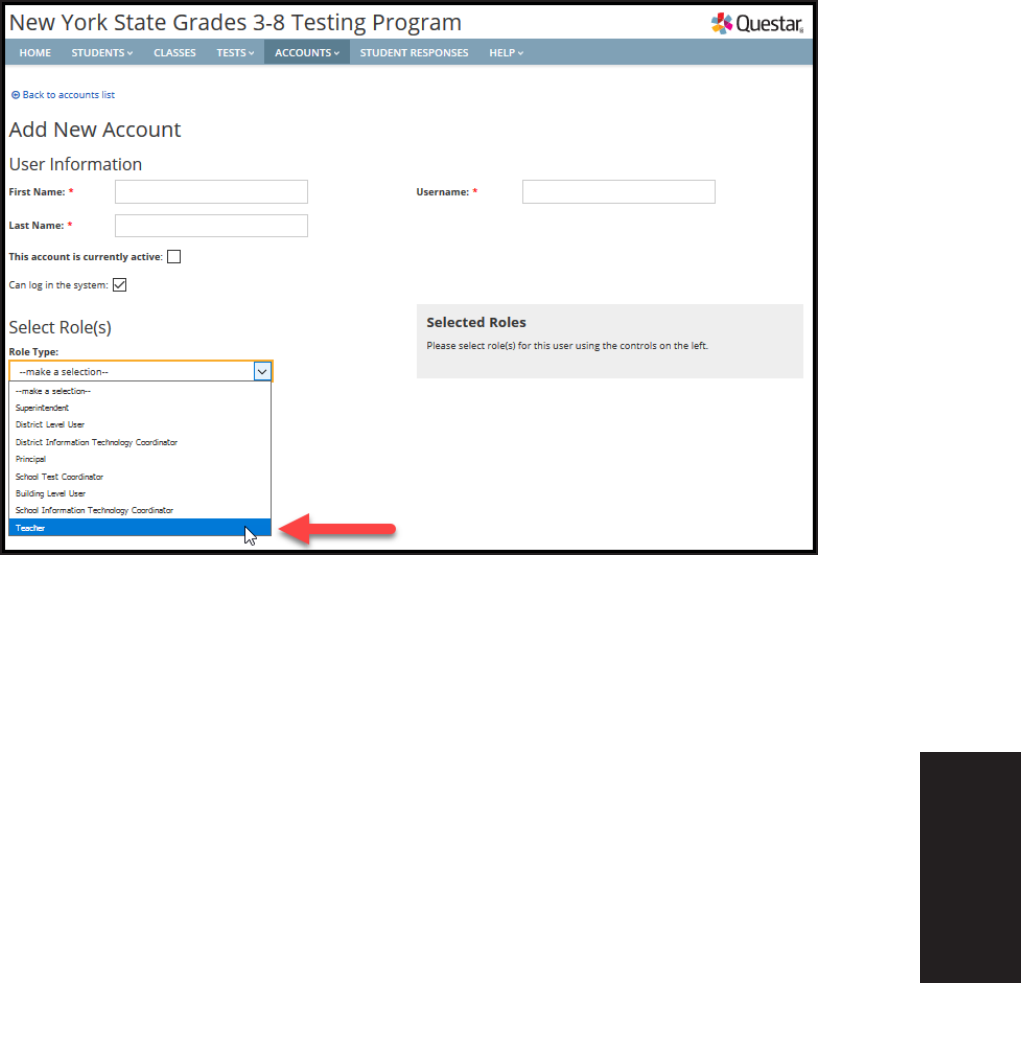
85
Appendices
Grades 3–8 English Language Arts and Mathematics Tests School Administrator’s Manual v202
3. Enter user first/last name and e-mail address. The username is the user’s e-mail address.
•
An e-mail address can only be associated to one account in Nextera
™
Admin.
•
Select district and school and the appropriate Role Type from the drop-down menu, then click
Add Role.
•
The Selected Roles will appear in a list on the left.
•
If you are adding a teacher role, you will need to include a TEACH ID or a local ID for the user
and then select the content area for test administration.
•
Protip: A teacher account must be active in Nextera
™
Admin to appear in the drop-down list of
Teachers to be selected and associated to a class.
•
In this example, Teacher is selected.
•
For a description of the different user account roles, see Appendix U: Roles, Responsibilities,
and Permissions in Nextera
™
Administration System for Computer-Based Testing.
A-85

86
Appendices
Grades 3–8 English Language Arts and Mathematics Tests School Administrator’s Manual v202
4. Enter the new user’s information and select Create an Account. Be sure to select the check box
“This account is currently active” to see that account in the Class “Teacher” drop-down menu for
editing or creating new classes.
A-86
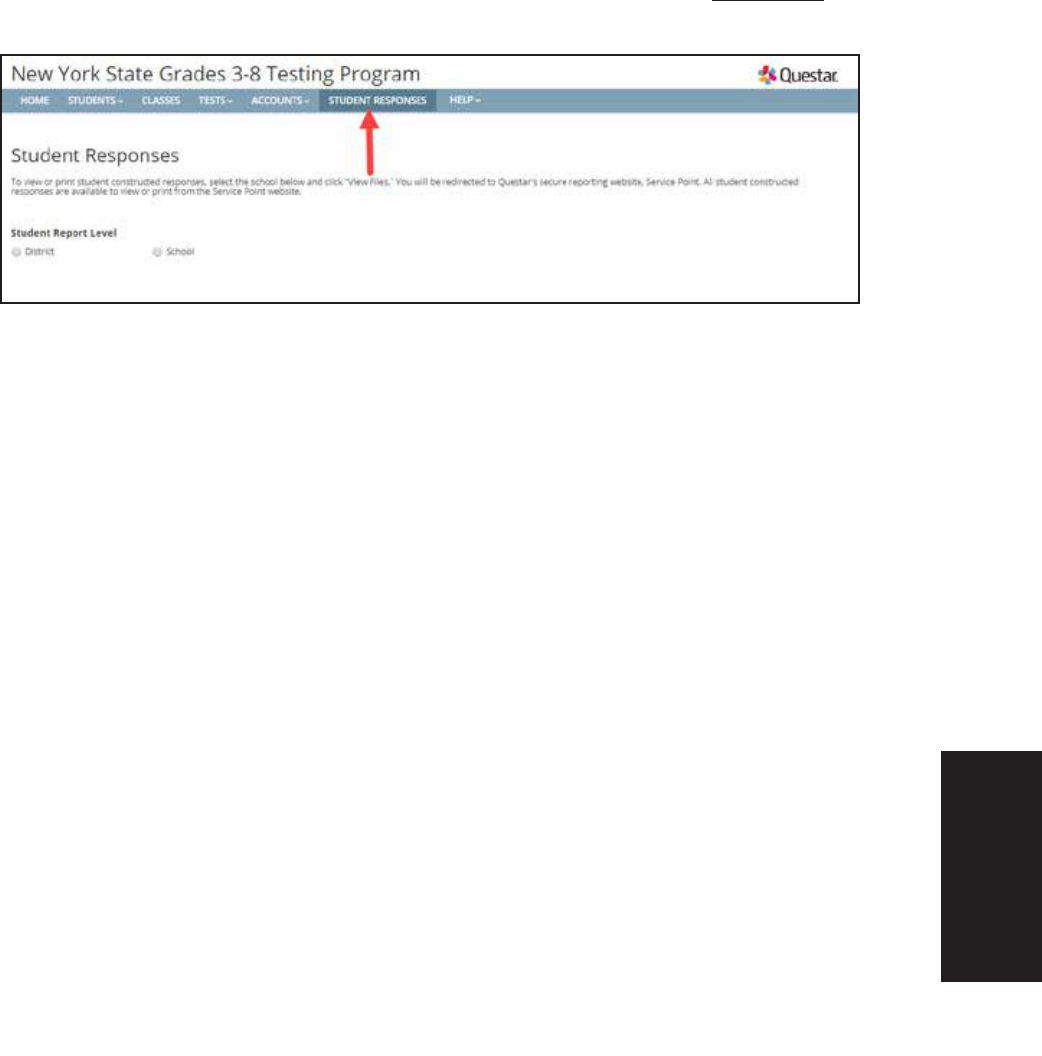
87
Appendices
Grades 3–8 English Language Arts and Mathematics Tests School Administrator’s Manual v202
Student Responses Tab
Principals and DTCs can access their students’ responses to operational constructed-response test
questions via the STUDENT RESPONSES tab in Nextera
™
Admin. This tab is only visible to principals and
DTCs of students who have taken the operational tests on computer.
Student responses are available to users in June each year following operational test administrations.
Once the responses have been made available, NYSED will notify CBT principals and DTCs, providing
further instruction on how they can access the students’ responses. Student responses are available on
the Nextera
™
Admin STUDENT RESPONSES tab for two years.
Additional information on accessing information in Nextera
™
Admin can be found at CBT Support (https://
cbtsupport.nysed.gov/).
A-87
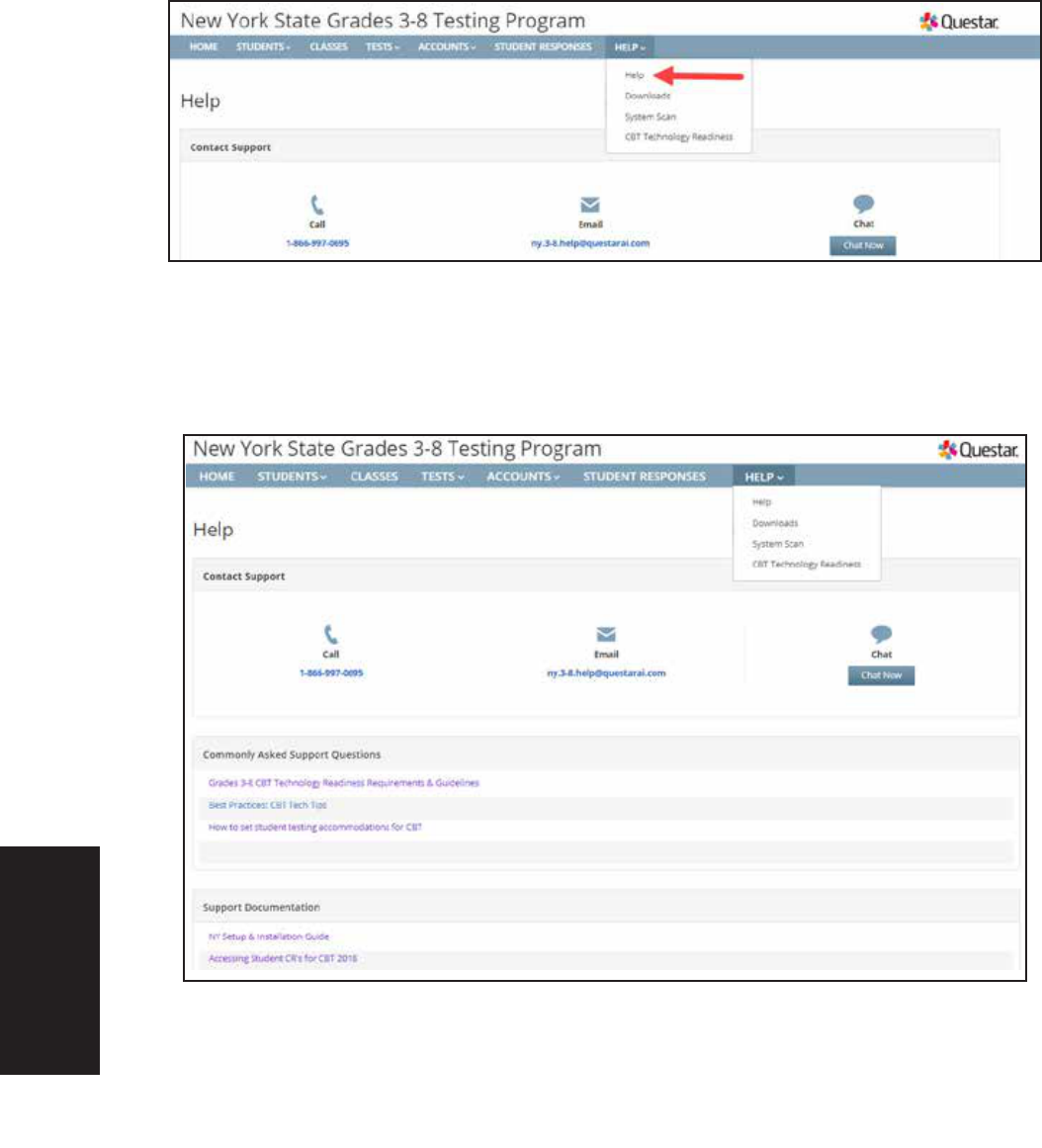
88
Appendices
Grades 3–8 English Language Arts and Mathematics Tests School Administrator’s Manual v202
Help Tab
Customer Support contact details, Commonly Asked Support Questions, and Support Documentation
are available on the Nextera
™
Administration System’s HELP tab.
To access this information:
1. Select Help from the HELP tab.
•
“Contact Support” details include a telephone number, e-mail address, and chat feature,
•
“Commonly Asked Support Questions” provides answers to commonly asked questions, and
•
“Support Documentation” includes links to reference materials, such as the Teacher’s
Directions. To open a document, simply click on the document title.
A-88

89
Appendices
Grades 3–8 English Language Arts and Mathematics Tests School Administrator’s Manual v202
All users can access Downloads from the HELP tab. Download the Questar Secure Browser using the
links on the Downloads page. The HELP tab also includes the Downloads page where technology
coordinators can download the most recent versions of the Questar Secure Browser.
For all users, the HELP tab also provides a link to the System Scan.
To perform the System Scan:
1. Select System Scan from the HELP tab.
A-89
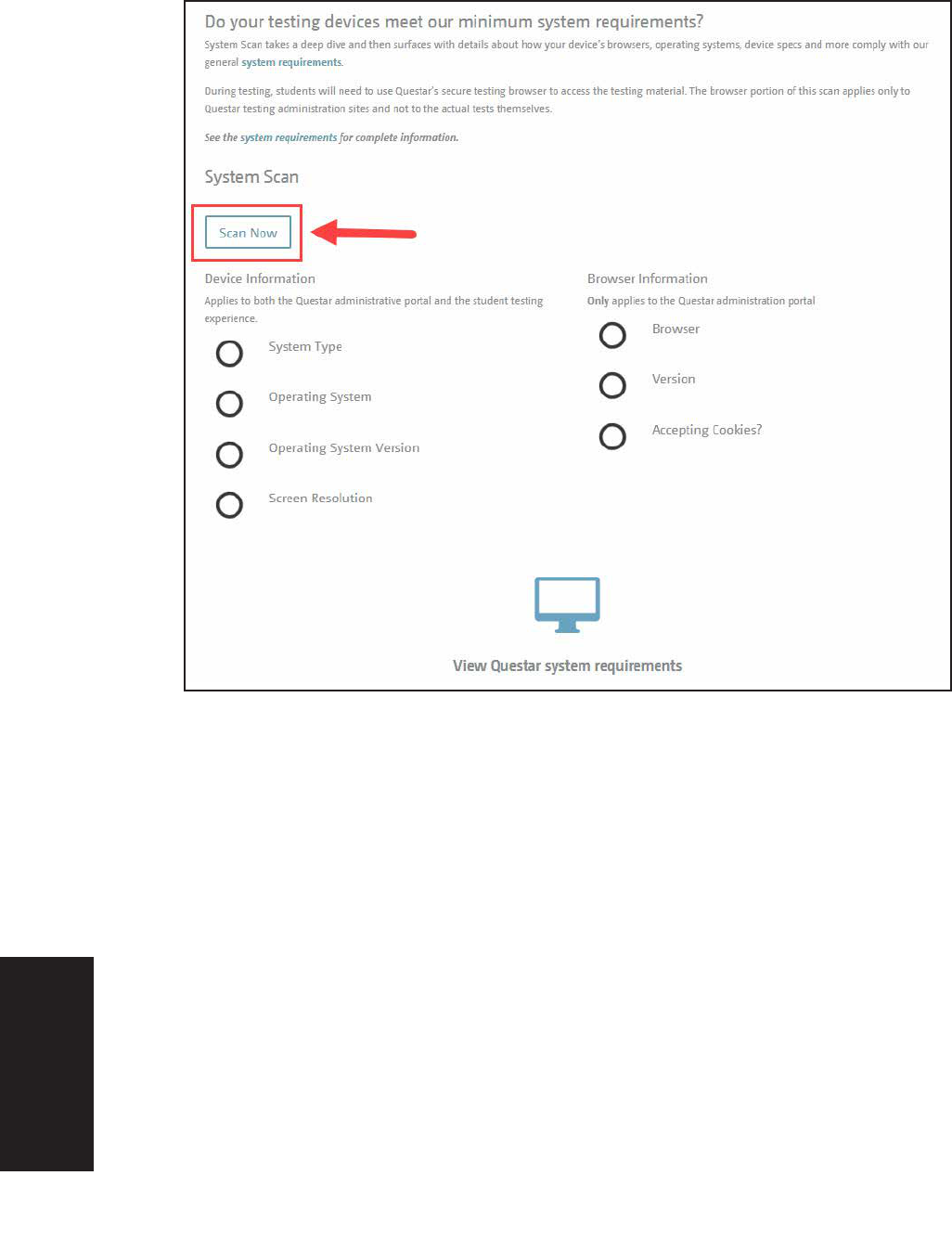
90
Appendices
Grades 3–8 English Language Arts and Mathematics Tests School Administrator’s Manual v202
2. Select Scan Now.
3. The scan results display and include the following details:
•
System type
•
Operating system and version
•
Screen resolution
•
Browser and version
•
Whether or not the system accepts cookies
A-90
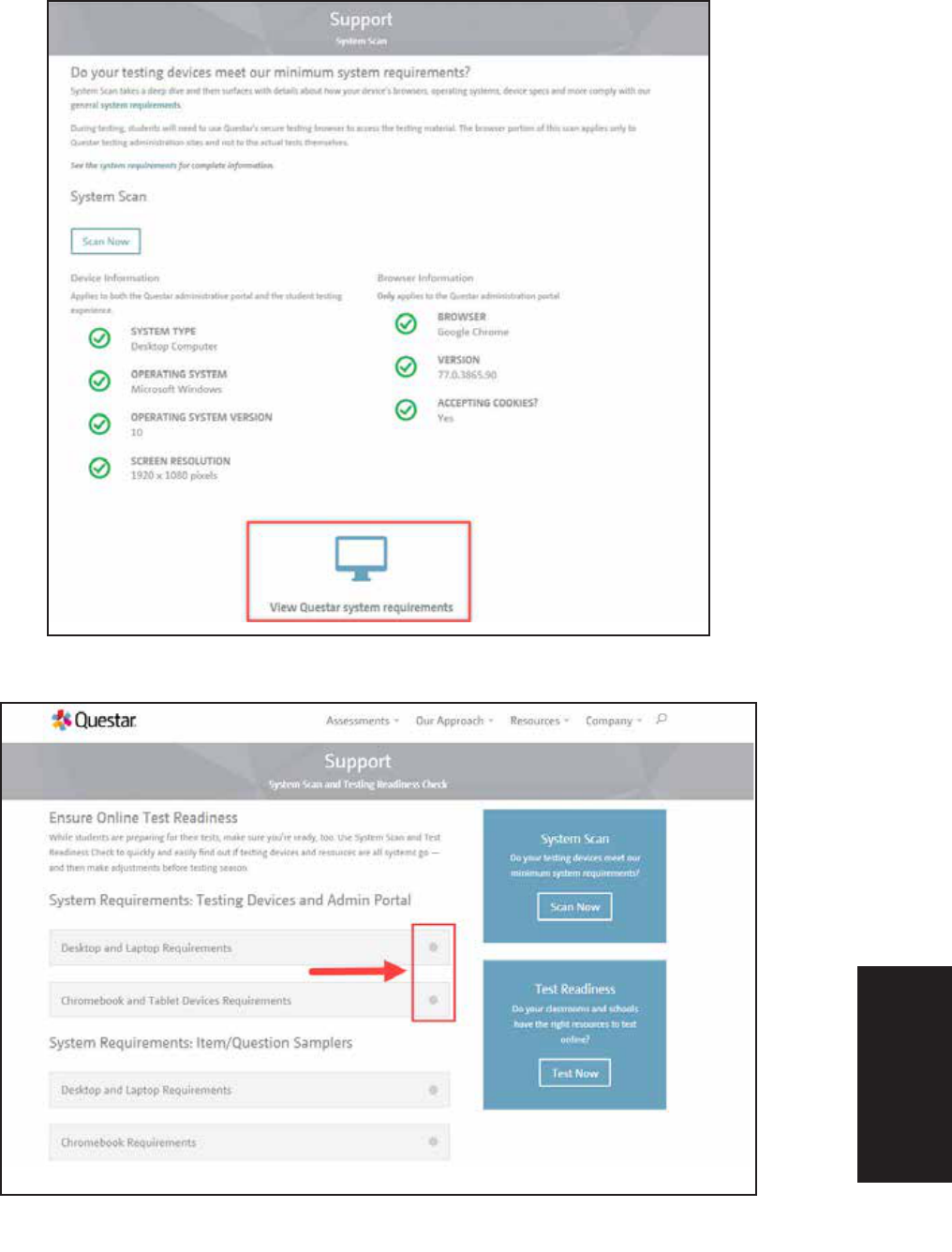
91
Appendices
Grades 3–8 English Language Arts and Mathematics Tests School Administrator’s Manual v202
4. To view Questar’s system requirements, select the View Questar system requirements option.
5. To view the requirements, select the plus sign next to “Desktop and Laptop Requirements” or
“Chromebook and Tablet Devices Requirements.”
A-91

92
Appendices
Grades 3–8 English Language Arts and Mathematics Tests School Administrator’s Manual v202
6. The requirements display and include physical requirements (e.g., screen resolution) and system/
network requirements (e.g., Internet speed).
A-92
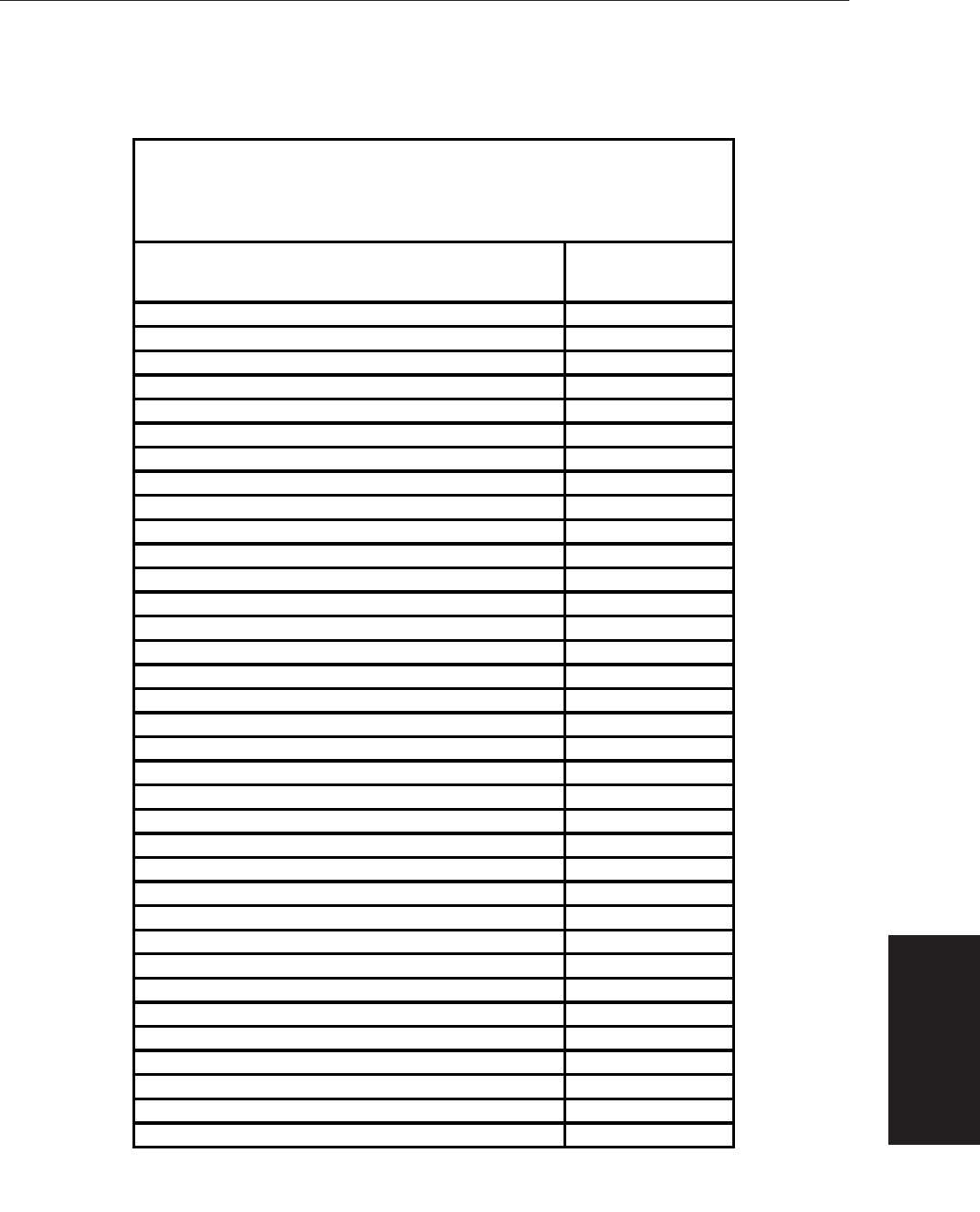
93
Appendices
Grades 3–8 English Language Arts and Mathematics Tests School Administrator’s Manual v202
Secure Browser Practice Test Logins
Below are the logins for the practice tests in the secure browser. These logins can also be found in the
Support Documentation section under Help in the HELP tab.
NY Math Practice Test Logins
Available in the Secure Browser
All passwords = practice
Practice Tests
(3 forms available for each)
User Name
Grade 3 Math mathg03
Grade 3 Math Text-to-Speech mathg03tts
Grade 3 Math Reverse Contrast mathg03rc
Grade 3 Math Answer Masking mathg03am
Grade 3 Math Background Color Black-on-Pink mathg03bcbp
Grade 3 Math Initial Zoom mathg03iz
Grade 3 Math Chinese mathg03c
Grade 3 Math Haitian Creole mathg03h
Grade 3 Math Korean mathg03k
Grade 3 Math Russian mathg03r
Grade 3 Math Spanish mathg03s
Grade 4 Math mathg04
Grade 4 Math Text-to-Speech mathg04tts
Grade 4 Math Reverse Contrast mathg04rc
Grade 4 Math Answer Masking mathg04am
Grade 4 Math Background Color Black-on-Blue mathg04bcbb
Grade 4 Math Initial Zoom mathg04iz
Grade 4 Math Chinese mathg04c
Grade 4 Math Haitian Creole mathg04h
Grade 4 Math Korean mathg04k
Grade 4 Math Russian mathg04r
Grade 4 Math Spanish mathg04s
Grade 5 Math mathg05
Grade 5 Math Text-to-Speech mathg05tts
Grade 5 Math Reverse Contrast mathg05rc
Grade 5 Math Answer Masking mathg05am
Grade 5 Math Background Color Black-on-Green mathg05bcbg
Grade 5 Math Initial Zoom mathg05iz
Grade 5 Math Chinese mathg05c
Grade 5 Math Haitian Creole mathg05h
Grade 5 Math Korean mathg05k
Grade 5 Math Russian mathg05r
Grade 5 Math Spanish mathg05s
A-93

94
Appendices
Grades 3–8 English Language Arts and Mathematics Tests School Administrator’s Manual v202
NY Math Practice Test Logins
Available in the Secure Browser
All passwords = practice
Practice Tests
(3 forms available for each)
User Name
Grade 6 Math mathg06
Grade 6 Math Text-to-Speech mathg06tts
Grade 6 Math Reverse Contrast mathg06rc
Grade 6 Math Answer Masking mathg06am
Grade 6 Math Background Color Black-on-Yellow mathg06bcby
Grade 6 Math Initial Zoom mathg06iz
Grade 6 Math Chinese mathg06c
Grade 6 Math Haitian Creole mathg06h
Grade 6 Math Korean mathg06k
Grade 6 Math Russian mathg06r
Grade 6 Math Spanish mathg06s
Grade 7 Math mathg07
Grade 7 Math Text-to-Speech mathg07tts
Grade 7 Math Reverse Contrast mathg07rc
Grade 7 Math Answer Masking mathg07am
Grade 7 Math Background Color Black-on-Pink mathg07bcbp
Grade 7 Math Initial Zoom mathg07iz
Grade 7 Math Chinese mathg07c
Grade 7 Math Haitian Creole mathg07h
Grade 7 Math Korean mathg07k
Grade 7 Math Russian mathg07r
Grade 7 Math Spanish mathg07s
Grade 8 Math mathg08
Grade 8 Math Text-to-Speech mathg08tts
Grade 8 Math Reverse Contrast mathg08rc
Grade 8 Math Answer Masking mathg08am
Grade 8 Math Background Color Black-on-Blue mathg08bcbb
Grade 8 Math Initial Zoom mathg08iz
Grade 8 Math Chinese mathg08c
Grade 8 Math Haitian Creole mathg08h
Grade 8 Math Korean mathg08k
Grade 8 Math Russian mathg08r
Grade 8 Math Spanish mathg08s
A-94
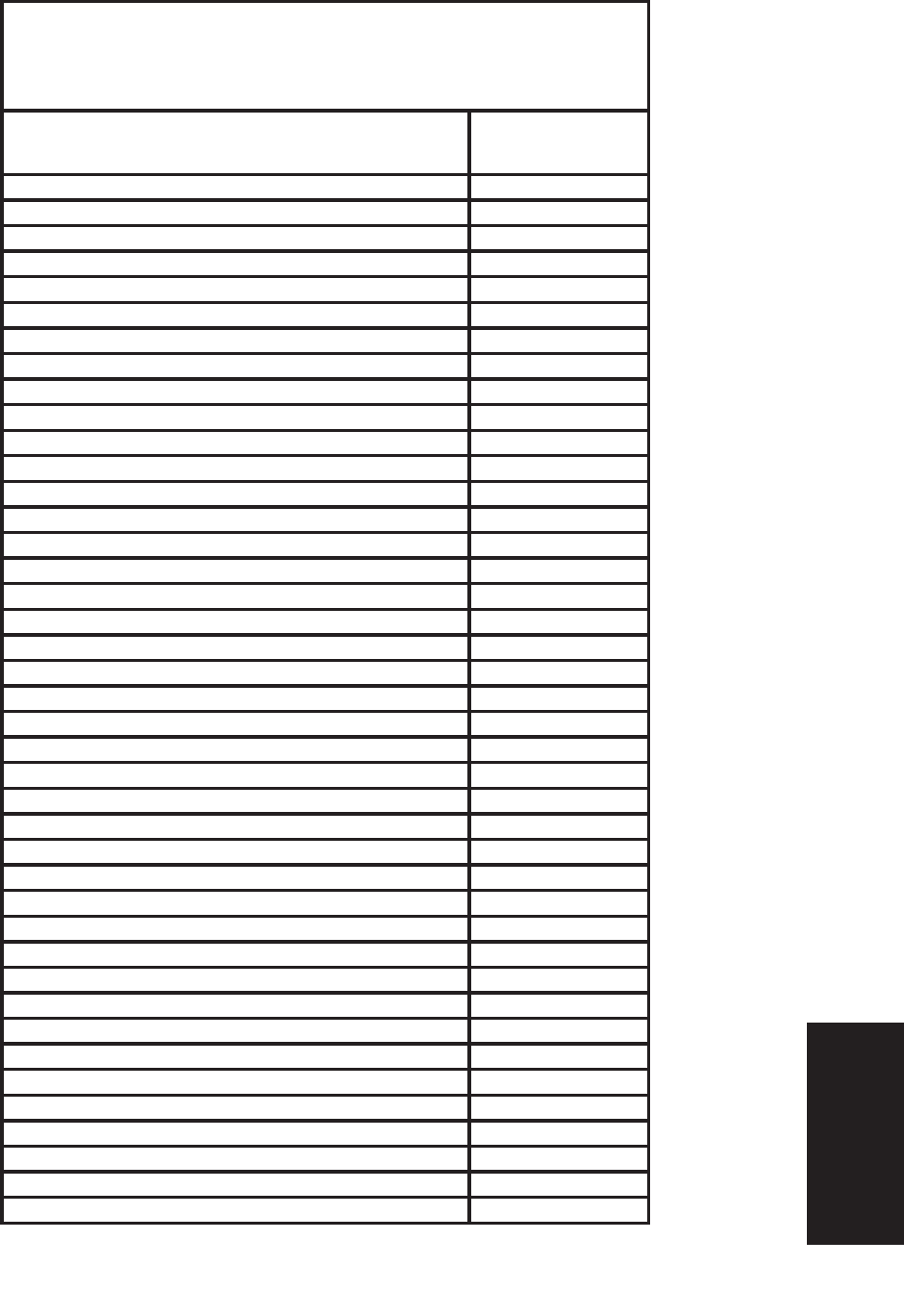
95
Appendices
Grades 3–8 English Language Arts and Mathematics Tests School Administrator’s Manual v202
NY ELA Prac�ce Test Logins
Available in the Secure Browser
All passwords = prac�ce
Prac�ce Tests
(3 forms available for each)
User Name
Grade 3 ELA elag03
Grade 3 ELA Text-to-Speech elag03s
Grade 3 ELA Reverse Contrast elag03rc
Grade 3 ELA Answer Masking elag03am
Grade 3 ELA Background Color Black-on-Pink elag03bcbp
Grade 3 ELA Zoom elag03iz
Grade 4 ELA elag04
Grade 4 ELA Text-to-Speech elag04s
Grade 4 ELA Reverse Contrast elag04rc
Grade 4 ELA Answer Masking elag04am
Grade 4 ELA Background Color Black-on-Blue elag04bcbb
Grade 4 ELA Zoom elag04iz
Grade 5 ELA elag05
Grade 5 ELA Text-to-Speech elag05s
Grade 5 ELA Reverse Contrast elag05rc
Grade 5 ELA Answer Masking elag05am
Grade 5 ELA Background Color Black-on-Green elag05bcbg
Grade 5 ELA Zoom elag05iz
Grade 6 ELA elag06
Grade 6 ELA Text-to-Speech elag06s
Grade 6 ELA Reverse Contrast elag06rc
Grade 6 ELA Answer Masking elag06am
Grade 6 ELA Background Color Black-on-Yellow elag06bcby
Grade 6 ELA Zoom elag06iz
Grade 7 ELA elag07
Grade 7 ELA Text-to-Speech elag07s
Grade 7 ELA Reverse Contrast elag07rc
Grade 7 ELA Answer Masking elag07am
Grade 7 ELA Background Color Black-on-Pink elag07bcbp
Grade 7 ELA Zoom elag07iz
Grade 8 ELA elag08
Grade 8 ELA Text-to-Speech elag08s
Grade 8 ELA Reverse Contrast elag08rc
Grade 8 ELA Answer Masking elag08am
Grade 8 ELA Background Color Black-on-Blue elag08bcbb
Grade 8 ELA Zoom elag08iz
A-95
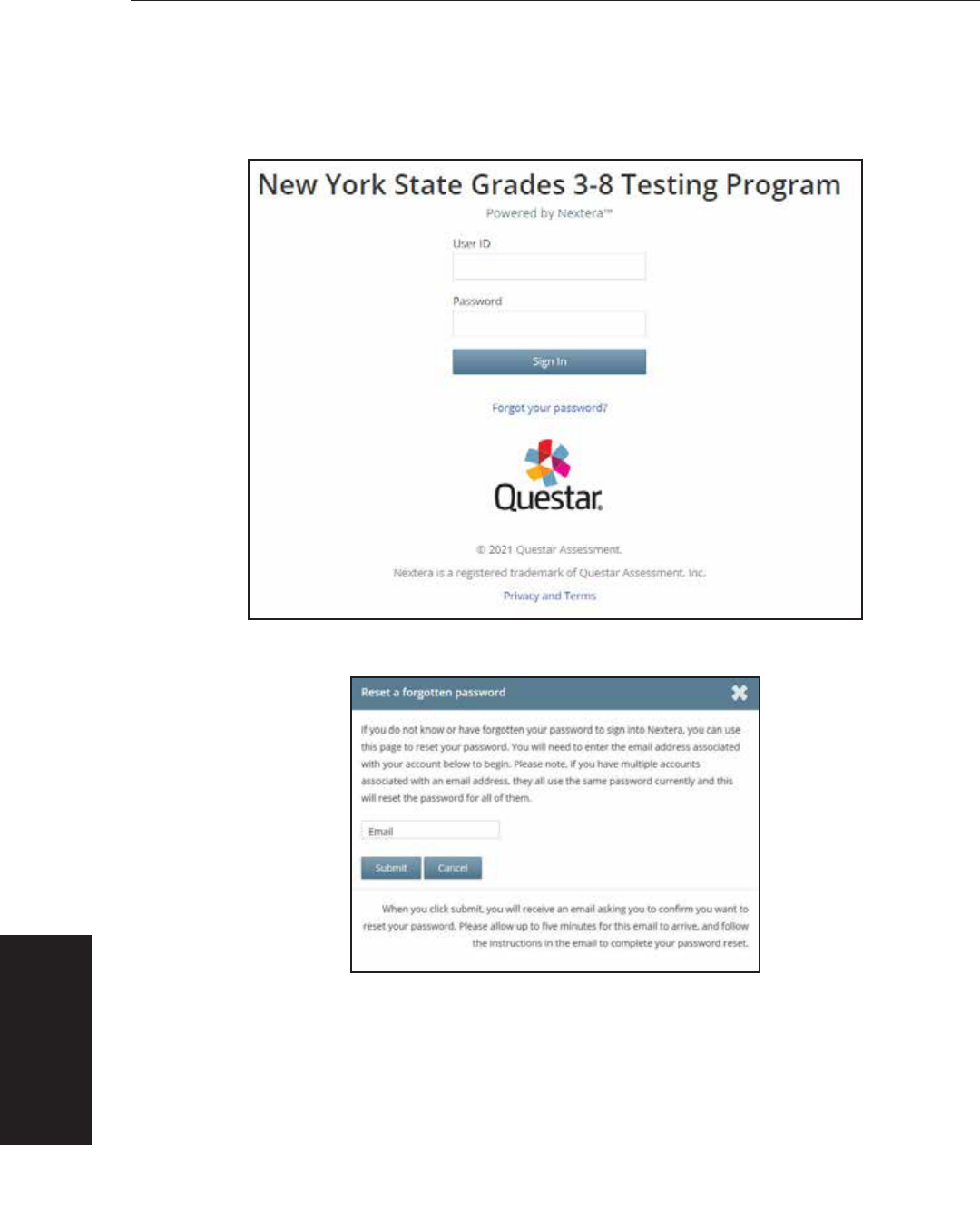
96
Appendices
Grades 3–8 English Language Arts and Mathematics Tests School Administrator’s Manual v202
Forgot Your Password?
Upon initial login, you will be required to change your password. This step allows you to create your own
password. Enter a new password in the New Password and Retype Password fields and select Submit.
If you have forgotten your password:
•
Select Forgot your password?
•
Enter your e-mail address and select Submit.
A-96
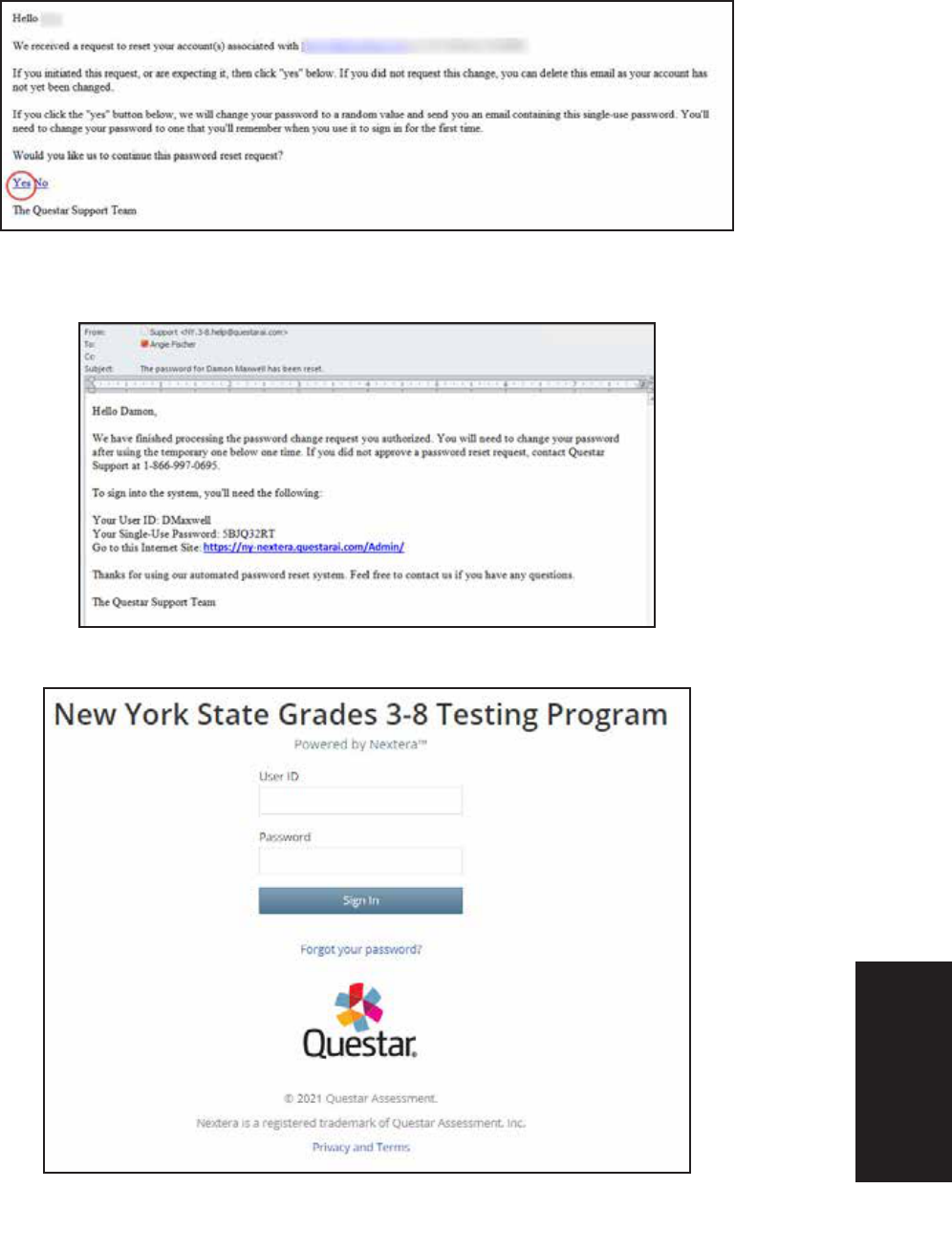
97
Appendices
Grades 3–8 English Language Arts and Mathematics Tests School Administrator’s Manual v202
•
You will receive an e-mail asking you to confirm you want to reset your password. Select Yes
to continue the password reset process.
•
You will receive another e-mail that provides you with a single-use Password. Select the Go
to this Internet Site link.
•
Enter your User ID and single-use Password and select Sign In.
A-97

98
Appendices
Grades 3–8 English Language Arts and Mathematics Tests School Administrator’s Manual v202
•
You will receive a message that your password has expired. This step allows you to create your
own password. Enter a new password in the New Password and Retype Password fields
and select Submit.
For initial logins and for all password changes, you will be asked to acknowledge and agree to the
Security Compliance statement. After reviewing the statement, select the check box for “I’ve read this
page” and select I Agree.
A-98

Grades 3–8
English Language Arts
and Mathematics Tests
School Administrator’s Manual
v202
2021 Edition
QAI26472
